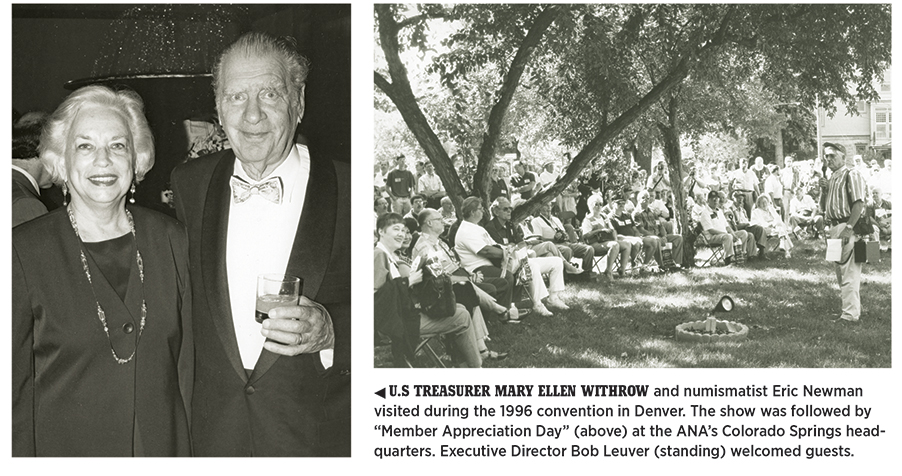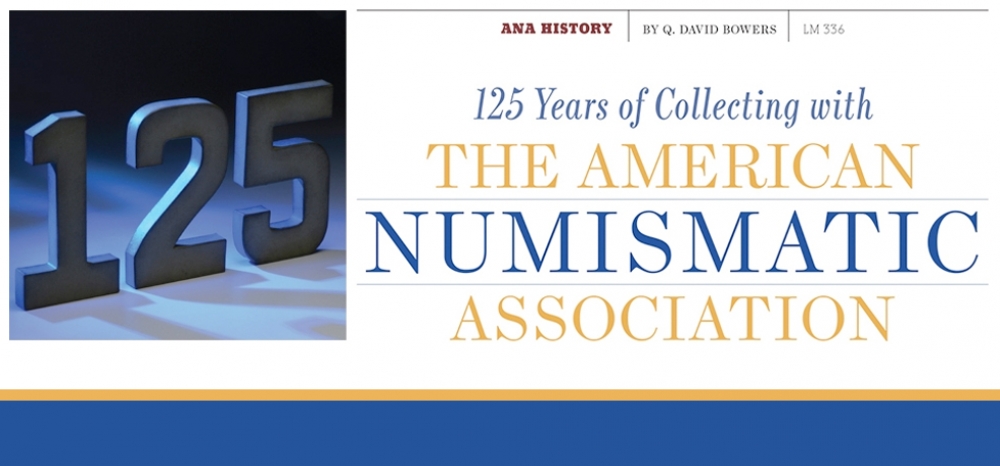
This year marks the 125th anniversary of the American Numismatic Association, of which you and I are proud members. Founded in Chicago in October 1891, the ANA has grown to include nearly 25,000 members and has become the world’s largest organization devoted to the history, lore and lure of coins, tokens, medals and paper money. Today, the ANA’s activities, educational programs and services are extensive and varied, including a museum and library, as well as conventions, seminars, online offerings and, of course, The Numismatist, which remains members’ primary benefit and source of Association news.
With this issue, I begin a series of monthly features about the history of the ANA, summarizing its progress and, along the way, its problems, potential and pleasures. This month, I offer a prologue— the pursuit of the hobby in America in the early days leading up to the debut of The Numismatist in 1888 and the foundation of the Association three years later.
The Early Years
The identity of the first serious numismatist in America is not known. Naturalist and American patriot Pierre Eugène du Simitière (1737-84) was active in the pursuit in the late 18th century. (Dr. Joel Orosz has researched Simitière and presented his findings in a study entitled The Eagle That Is Forgotten.)
In 1787 Wil liam Bentley, D.D. (1759-1819) of Salem, Massachusetts, entered in his diary some observations about coins in cir culation, creating one of the earliest such records known. He included the following in his notes for September 2:
About this time there was a great difficulty respecting the circulation of small copper coin. Those of George III, being well executed, were of uncommon thinness, and those stamped from the face of other coppers in sand, commonly called “Bir mingham,” were very badly executed. Beside these were the coppers bearing the authority of the states of Vermont, Connecticut and New York, etc., but no accounts how issued, regularly transmitted.

To remember all the coin which passes through my hands, I note down a few coppers of foreign coins, Swedish coin, shield, three bars, lion, etc., 1763, measures one inch and 3-10; another 1747, similar; Russian, a warrior on horseback with a spear piercing a dragon, on the reverse a wreath infolding a cypher.
Bentley’s diary entry on October 23, 1795, described his work with an important cabinet formed by another Salem collector:
Busied myself to provide catalogue of coins for Mr. [Samuel] Curwen’s collection for Mr. [James] Winthrop. Such collections are rare in this country and in some parts utterly unknown. This is the largest that I have ever seen. The real antiques in silver, are an Athenian City, a Greek City, a Consul, Scipio, Juba, Julius Caesar, Augustus, Tiberius, Claudius, Hadrian, Marcus Antoninus. There are also a considerable number of copper and Mantuans, which the connoisseurs must distinguish. Among the modern is to be found a MARYLAND coin, Cecilius C Lord Baltimore. A Specimen is to be seen of all the modern coinage in this collection.


When the first federally minted coins—the 1792 silver half dismes—were placed in circulation, followed by copper half cents and cents in 1793, no known collectors actively sought them. Those who did pursue numismatics were mainly interested in ancient Greek and Roman issues, European coins and medals, and, to a more limited extent, Early American coins.
In Europe, numismatics was pursued by thousands of enthusiasts. In 1780s and ’90s England, many collectors searched for copper halfpenny-size tokens that circulated in commerce and sometimes were minted for sale to hobbyists. These pieces, known today as “Conder” tokens (after author James Conder, who cataloged them in 1798), featured many subjects, ranging from political figures and ruins of ancient abbeys to exotic animals, such as crocodiles and elephants.
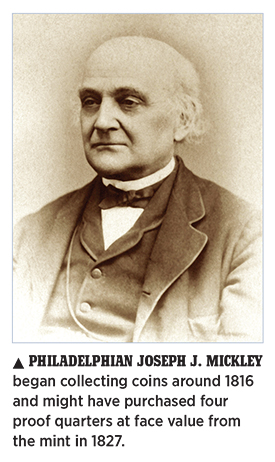
Into the 19th Century
America’s interest in numismatics increased in the early years of the 19th century, mostly in the form of ancient and classical coins and medals acquired for their historical value. Young people who attended high schools and academies learned about ancient Greek and Rome as part of their studies, and most college students took Latin and sometimes Greek. Collecting related coins was a natural outcome.
Museums were opened in many cities, some as part of historical or learned societies, and others as attractions for the admission-paying public. Coins and medals usually were on display. Few inventories with content useful to modern-day numismatists have survived.
In the meantime, money was often mentioned in newspaper and magazine articles, notably curious instances in which buried silver and gold pieces came to light. Nathaniel Hawthorne wrote a charming story about the master of the Massachusetts mint who paid his daughter Betsey’s dowry in her weight in newly coined Pine Tree shillings. In 1821 John Allan, a Scottish immigrant, bought and sold coins while engaging in his occupation as an accountant. In that decade, Philip Hone, mayor of New York City, lived nearby and was among Allan’s clients, as was Baltimore numismatist Robert Gilmor Jr.
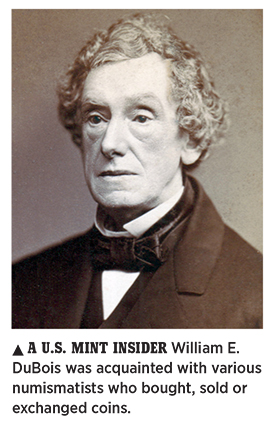
The Mint cabinet was authorized by Congress in July 1838. In time, co-curators William E. DuBois and Jacob R. Eckfeldt formed a fine collection (much of which resides in the National Numismatic Collection at the Smithsonian Institution, to which it was transferred in 1923). Prior to 1838, Adam Eckfeldt (1769-1852), who had been at the mint since its inception and was guided by “his own taste and the expectation that a conser vatory would some day be established,” began a collection of rare and unusual foreign coins (deposited for recoinage) and of select specimens of U.S. coins (assembled at his own expense). This included an 1822 half eagle (gold $5) retrieved from a bullion deposit.
The March 1852 issue of Banker’s Magazine noted Adam Eckfeldt’s passing:
THE MINT. – Mr. Adam Eckfeldt, formerly chief coiner of the Philadelphia Mint, died on Friday, February 6, in the eightythird year of his age. Mr. Eckfeldt has long been a well-known and highly respected citizen ofPhiladelphia. He began to make machinery for the Mint at its first organization in 1792-3; was soon after appointed assistant coiner, and in the year 1814 was made chief coiner, which office he held until the year 1839, at the age of seventy. As a special token of regard, his fellowofficers presented him on that occasion with a gold medal bearing his likeness. Nearly all the coinage of the country, up to 1839, was executed under his immediate superintendence; and by his ingenuity several valuable improvements were made in the machinery and processes, some of which were afterwards adopted in foreign mints. The son of Mr. Eckfeldt is now one of the assayers at the Mint.

In 1839 the first numismatic book was published in the United States: An Historical Account of Massachusetts Currency by Joseph Felt. Remarkably, its information is still useful to today’s collectors, if you are lucky enough to obtain a copy!
The 1850s
In 1851 the first American numismatic auction of any importance featured the estate collection of Dr. Lewis Roper. He had gone to California to take part in the Gold Rush, but he became very ill and died aboard a steamship during his return trip.
The public’s interest in numismatics grew after the Coinage Act of February 21, 1857, discontinued the copper half cent and cent, and authorized the new, small coppernickel cent. A wave of nostalgia swept across the land. Thousands of citizens began to save the “pennies” of their childhood, and some set about acquiring as many different dates as possible. Their enthusiasm knew no bounds.
Historical Magazine was established that year and went on to include many articles about coins. Norton’s Literary Letter was another source of information. In Boston, Jeremiah Colburn wrote articles about coins for a local paper, and in New York City Augustus Sage did the same. The Philadelphia Numismatic Society was organized in the waning days of 1857. In March 1858, Sage, then a teen aged school teacher, gathered collectors in his family’s apartment upstairs at 121 Essex Street in New York City and formed the American Numismatic Society. Similar groups were established within the next several years.
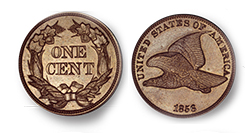
In 1858 Sage cataloged three r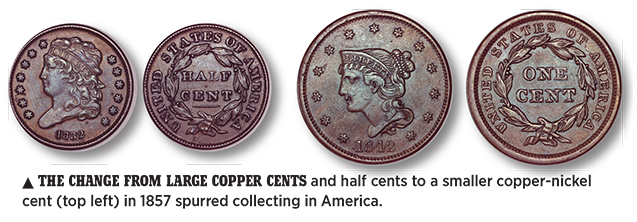
In the American series, the most actively sought items included colonial and related coins dating back to the Massachusetts silver issues of 1652; tokens and medals of George Washington (the hottest items by far); copper cents dated 1793 and later; silver coins from 1794 to the late 1830s; gold coins from 1795 to 1834; and medals with American themes.
Later Years
In the 1860s, the hobby matured somewhat. W. Elliot Woodward of Roxbury, Massachusetts, operated a pharmacy and, as a sideline, cataloged rare coins for auction. An intellectual par excellence, he was well studied and had a large library. Competition was furnished by Edward D. Cogan, an English immigrant who operated an art shop in Philadelphia. In 1858 Cogan sent out letters offering copper cents to mail bidders. Based on this, he later boasted he was the father of the rare-coin trade in America, a false premise as several others were in the auction field as well.
For reasons not known today, the American Numismatic Society either slipped into a coma or died in 1860. In 1864 collectors (not involved earlier in the ANS) formed the American Numismatic and Archaeological Society in New York. The ad dition of “and Archaeological” was an effort to broaden membership. It soon became obvious that fossils and dinosaur bones were of little interest to numismatists, and archaeologists did not care that the 1787 Columbia and Washington medal was rare. Years later, the name was changed to the American Numismatic Society. Today, the ANS—headquartered on Varick Street in New York City—is dynamic.
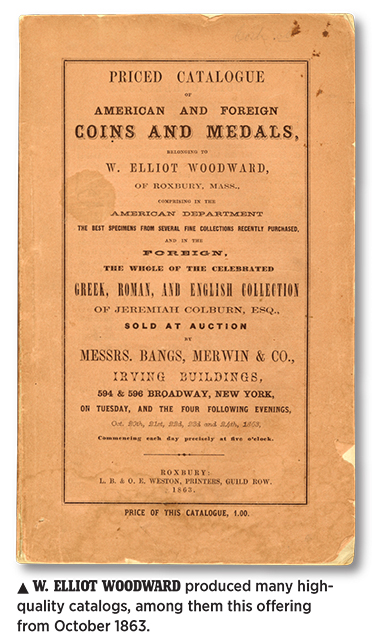
In 1883 the Shield-type 5-cent piece was discontinued, and the Liberty Head nickel, designed by Charles E. Barber, took its place. The denomination on the reverse was stated simply with the Roman numeral “V,” a logical move since the 3-cent piece was identified as “III.” Fraudsters seized upon the nickels, gold-plated them, and passed them off as $5 gold coins of similar diameter. This necessitated a quick change, and the word CENTS was lettered on the reverse. A nationwide sensation was created when it was publicized that any 1883 nickel without CENTS would be recalled by the mint and likely become a valuable rarity. Tens of thousands of excited treasure hunters joined in the search. So many CENTS-less nickels were saved that today they are the most common Liberty Head nickels in high grades.
Nevertheless, thousands of people were captured by the lure of numismatics and stayed on to become collectors of other things. This engendered the most dynamic rare-coin market in history up to that time. Coin auctions were held at the rate of about one a week, countless catalogs were issued, new magazines were published, and many dealerships were established.
Making its debut on the coin collecting scene in the autumn of 1888 was The American Numismatist, a modest four-page leaflet dated September-October, the brainchild of George F. Heath, M.D. of Monroe, Michigan. The doctor was an intellectual in the mold of W. Elliot Woodward. He had his eye on the future, with more issues planned, as the masthead proclaimed that the initial edition was Volume 1, Issue No. 1.
Thus was planted a seed that, in 1891, would germinate and result in Dr. George Heath’s creation of the American Numismatic Association, setting the scene for next month’s chapter.
Last month, I profiled the early years of numismatics and the establishment of the hobby in the United States, which led to the eventual publishing of the first issue of The American Numismatist. This month’s installment will discuss the formation of the American Numismatic Association and the man behind the magazine, Dr. George Francis Heath.
George Heath, M.D.
Heath was born on September 21, 1850, in Warsaw, New York. When he was 10 years old, his mother died and he was sent to Poultney, Vermont, to live with an uncle. In 1861 his father joined the Union army.
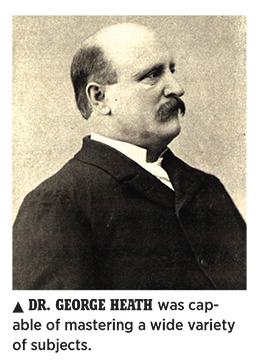
Heath moved to Warrensburg, Missouri, in 1871 where his father had established residence. There he continued his education, including advanced placement in the State Normal School. By 1872, Heath was appointed postmaster of Warrensburg, a position he held until 1876, at which time he resigned to pursue a career in pharmacy. That same year, he married Lucy May Rayhill, a Warrensburg native. He also served two terms as a town councilman. Heath’s pharmacy career engendered a desire to learn more about medicine, and in 1879 he entered the University of Michigan. While there, he served as president of his class. He graduated with a medical degree in 1881, and was appointed resident physician and surgeon at the university hospital, where he and his staff attended to about 5,000 cases over the next three years.
In 1884 Heath and his wife moved to Monroe, Michigan, so he could take over Dr. C.T. Southworth’s practice. Once there, Heath engaged in many activities, including those related to charity, education and politics, the last capped by his election as mayor in 1890, after which he served multiple terms. He also pursued many hobbies, including coin and stamp collecting, and traveling by rail to destinations he considered interesting. An avid reader, Heath’s personal library comprised over 1,000 volumes.
The Numismatist
In Autumn 1888, Heath (who nearly always gave his first name in print as “Geo.”), published a fourpage leaflet titled The American Numismatist. Dated September-October, the pamphlet’s masthead read “Vol. 1 …No. 1.” Obviously, an extensive future was planned.
Apparently unknown to Heath, C.E. Leal of Paterson, New Jersey, had launched a magazine, also titled The American Numismatist, in September 1886, predating Heath’s periodical by two years. Although Leal changed the name to The Collector’s Magazine in early 1888, Heath changed the name of his publication’s second issue to The Numismatist, the name it bears today.
For the next several years, the magazine contained a variety of news articles, advertisements and coin features, and Heath sold American and world coins in each issue. More than anything else it was a house organ. In the first issue, for just 60 cents the reader could order: “Packet No. 13, contains 10 var. of silver coins size of half dime,” or for $1.25 Packet No. 14 “contain[ing] 10 var. of same dime size.” Heath also had this to say in the first edition:
Of one thing all may rest assured, this paper has come to see its year out and though small and unpretentious, will, like the Irishman’s flea, ‘get there just the same,’ and when least expected. And so without further ado we launch our frail bark on the journalistic seas, and with clear skies and a flowing sail go out on our mission.
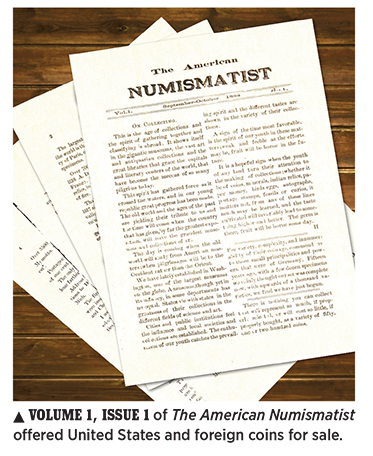
The Numismatist was not without its problems. From the late 1880s into 1890, the nation was in an economic recession, and some subscribers dropped out. Heath wondered if the magazine would endure, but after some fits and starts, it did.
A Memorable Proposal
In 1891 on a sunny day in Monroe, Michigan, Heath announced that The Numismatist would be issued twice monthly at an annual subscription rate of 50 cents.
Every number will be illustrated. Every number will contain interesting articles and notes on coins. Every number will contain the names and addresses of from 10 to 15 or more live coin collectors, with their specialties, if any.
In February of that year, Heath went on to say:
What’s the matter of having an American Numismatic Association? Would it be possible? Would it be practicable? All in favor of such a scheme, send in your names. If a sufficient number are received, we can think of organizing on some inexpensive basis.
The seed was planted, and Heath furthered the idea in the March 1891 article, “A Plea for an American Numismatic Association.” Through the publication of this editorial, the good doctor found many individuals who might contribute to the success of such an organization.
Wheels in Motion
Not one to deal in theory when practice could be accomplished, Heath took the bull by the horns, and in the July 1-15, 1891, issue of The Numismatist he said that the American Numismatic Association was a necessity. No doubt about it! Henceforth, he nominated those whom he hoped would serve on the board if the ANA was formed:
For president: W.G. Jerrems, Jr., of Chicago; vice-president: Joseph Hooper, Port Hope, Ontario; secretary: Charles T. Tatman, Worcester, Massachusetts; treasurer: David Harlowe, Milwaukee, Wisconsin; Board of Trustees: C.W. Stutesman, Bunker Hill, Indiana; W. Kelsey Hall, Peterborough, Ontario; J.F. Jones, Jamestown, New York; Board of Temporary Organization: George W. Rode, Pittsburgh, Pennsylvania; J.A. Heckelman, Cullom, Illinois; F.J. Grenny, Brantford, Ontario.
“These officers nominated are all tried and true, and earnest workers in the numismatic field,” said Heath. “We do not expect one will shrink from duty. If for good and sufficient reasons he cannot serve, at least hold the picket line until the relief comes up on permanent organization.”
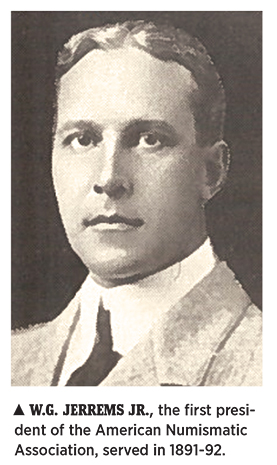
Call for Convention
In the August 1-15, 1891, issue, Heath speculated that there might be as many as 20,000 coin collectors in the United States,
of which it is probable that less than 5% collect scientifically or intelligently; about 40% are still in the “medieval” age, and the balance just emerging from the “barbaric” state. To these varied classes will the Association appeal.
He reported that 25 members signed up for the ANA as of July 1, 1891, and “many more” were waiting until the organization became official.
The September 1891 issue (combined numbers 17 and 18) stated that the Committee on Temporary Organization of the American Numismatic Association had called for the first convention to be held in Chicago on Wednesday, October 7, 1891.
We hope all will attend that can possibly do so, and that the First Convention of the ANA may be a success in every particular. With two-thirds of our membership in the East, and an infant organization besides, there may be some who may doubt the propriety of calling the convention so far from the majority. We however trust that the result will show that the Committee acted with wisdom in this matter. The holding of the convention in Chicago should bring in a number of additions to our association from the Windy City and vicinity…
Heath announced that from October 1 through 7, he would be at the Commercial Hotel, at the corner of Lake and Dearborn Streets, in Chicago, preparing for the event.
ANA Formation
The convention took place, and all transpired as Heath hoped. He later reported that the Board of Officers of the American Numismatic Association had been elected, with the top nominees earning seats. Additional officers included Librarian and Curator S.H. Chapman; Superintendent of Exchange George W. Rode; and Counterfeit Detector Ed. Frossard. The Board of Trustees consisted of W.K. Hall, C.W. Stutesman, J.A. Heckelman, J.F. Jones and H.E. Deats.
We were in at the launching and saw the good ship Numisma go out with flowing sails and a clear sky on her 12 months voyage. Sixty souls comprise her officers and crew. Monthly stops will be made and passengers received. Numismatists! This Ark has been fitted out with special reference to your comfort and convenience. Make haste and come aboard, an awful shower is coming up.
Two days were spent in a pleasant and harmonious convention; a constitution and bylaws were adopted, that, while not perfect, we believe will serve the Association well. Thirty-one members were present in person, or represented by proxy.
Heath stated that members could join the ANA by paying an initiation fee of 50 cents and submitting a form signed by two members of the organization. If no objections were received within 30 days of the date of publication in the journal, the secretary would issue a certificate of membership signed by the president.
It was apparent that The Numismatist was becoming the official journal of the ANA (although this was not specifically stated), and as recently as the November 1891 issue, it was intimated that Plain Talk was still in the running for this honor.
The First Year
During the Association’s first year, The Numismatist expanded in size and coverage. Advice on collecting and how to clean coins, plus auction news, biographies of collectors and dealers, and other content made the magazine a key source of information. In the meantime, the American Journal of Numismatics, launched in New York City by the American Numismatic and Archaeological Association in 1866, was now published in Boston. A typical issue featured research information, auction news, and other content, and was more scholastic in nature than the popular style employed by The Numismatist.

Coin grading, still controversial today, was first discussed at length in The Numismatist in February 1892. Joseph Hooper, a frequent contributor, suggested a system based on Roman numerals from I (“Brilliant Proofs or first strikes on planchets”) to XII (“Very Poor”). As printed descriptions in auction catalogs and other publications varied all over the place throughout the United States, Hooper suggested such a system would make grading understandable to everyone.
At this time, there were 80 ANA members and 411 subscribers to The Numismatist, still privately published by Heath. This changed after 1892, when Heath wrote, “If desired, The Numismatist with its prerequisites and emoluments will be turned over to the Association.”
Among news of the era, it was stated that ANA Trustee Hiram Deats, a well-known figure in the hobby, had dropped numismatics in favor of stamp collecting, and his coins would be sold at auction by Ed. Frossard. Not long before, in 1890, Lorin G. Parmelee, who had built what was probably the second finest collection of United States coins (after T. Harrison Garrett’s) and consigned it to the New York Coin and Stamp Company for auction, when the economy was struggling, “bought in” many items. Finally, in early 1892, Parmelee sold the remaining items for $75,000 to William Sumner Appleton, a prominent Massachusetts collector.
The Scott Stamp and Coin Company was located at 12 East 23rd Street in New York City and staffed by 19 people, probably the largest dealership in the country. At the time, most coin dealers also sold stamps, and many offered autographs, fossils, Indian arrowheads and artifacts, and even birds’ eggs. In Philadelphia in 1878, brothers S. Hudson and Henry Chapman partnered to form the leading auction company. The duo, born in 1857 and 1859, respectively, learned the trade as employees in J.W. Haseltine’s shop in the mid-1870s.
In 1892 it was proposed that the second annual ANA convention be held in Niagara Falls. Little information was published about the event, and only five people attended, including Deats, who, it seems, concluded that collecting coins was a nice hobby after all. Another convention (this one better publicized) was scheduled for Pittsburgh on Saturday, October 1, 1892. None of the officers attended, although 36 members were represented, mostly by proxy (a very controversial policy that endured for decades). Henry McKnight volunteered to preside, W. Rode took notes in the absence of the secretary, and Heath was elected president of the ANA.
An Uncertain Year
In 1893 expanded coverage was given to the World’s Columbian Exposition and its coins. The Panic of 1893, as it was later called, negatively affected the economy, which had improved more or less since the Civil War. By the late 1880s, vast growth in the prairie states, largely financed by Easterners buying bonds that paid 8 percent or more annual interest, slowed, and many bankruptcies occurred.

In a special message in the March issue, Heath reassured readers that the ANA was here to stay, but many difficulties loomed ahead, including apathy within the ranks. “However, once the Valley of Despond is crossed, the Delectable Hills are ahead,” he stated comfortingly. Each member was encouraged to spread the word about the Association among friends, acquaintances and correspondents. Still, there was doubt:
Stand by the guns! If by any possibility our ship goes down, let it be like the Cumberland, with our guns trained and booming and our flag flying. We have set our mark high. If we fail to realize all our hopes and ambitions we shall still be found fighting in a worthy cause; as success crowns our efforts, and we expect nothing else, to our science and Association give the glory.
(The above suggests that mostpeople who read Heath’s articles would have done well to have an encyclopedia at hand. Few probably could remember the fate of the U.S.S. Cumberland.)
The March 1893 issue of The Numismatist also shared a variety of interesting facts: President William Henry Harrison possessed a collection of ancient Greek and Roman coins; only five 1815 half eagles were known; the King of Sweden paid $2,000 to complete his set of U.S. coins; the rarest coin in the U.S. series was the double eagle of 1849; only 10 1804 silver dollars were in existence; and a Fine half dime of 1802 was worth $100.
The “Slough of Despond” continued, as per Heath’s April editorial, again in his inimitable style:
For now, upwards of two years, we have endeavored to keep alive the flame that faintly flickered on the altar in the temple dedicated to Numisma. In the midst of a busy professional life we have been glad to do this little, though it has crowded our spare time to the utmost. Many times we would have been glad to lay our burden down or place it into worthy or abler hands; but we have found no opportunity. We see none now…of our trials and hindrances, of our doubts and disappoinments, none may know…and yet, there have been rifts of sunshine through the shadows to lighten our burden and make glad our way. To those friends who have by their aid and subscriptions, contributions, advertisements, kind words, etc. do we extend our heartfelt thanks. By your aid we have done what we have done … our future, to make or mar our superstructure, lie mainly with you.
Meanwhile, Augustus G. Heaton published Mint Marks, a booklet that gave 17 reasons why collecting coins by mintmarks rather than obverse dates was a good idea. This suggestion caught on, but it was not until the next century that the practice became accepted widely.
The Association’s annual convention was held in Chicago on August 21 so at tendees could visit the Exposition. Fifteen members took advantage of the opportunity. The event was held at Douglas Hall, and the official program noted the presentation of 12 different scholarly papers.
Onward & Upward
The January 1894 issue of The Numismatist included a poem by Heaton titled “The Convention of the Thirteen Silver Barons.” The “barons” in question consisted of rarities in the American silver series, with the 1804 silver dollar being the “chairman,” and the others consisting of the 1802 half dime, the 1804 dime, quarters of 1823 and 1827, half dollars of 1796 and 1797, and dollars of 1794, 1838, 1839, 1851, 1852 and 1858. The lengthy and clever poem was a commentary on the unrestricted coinage of silver.
In the April 1894 column, “Hooper’s Restrikes,” which had appeared intermittently during the preceding year, included this:
Coin collectors have long felt great difficulty in making a complete collection of American specimens. The United States coinage of 1793 is very rare, and a dollar of the year 1794 has often sold for as much as $100. The 1796 half cent is so rare as to readily sell for $15, and a half dollar of the same year is worth 60 times its original value. While the half cent of 1804 is common enough, all the other coins of that year are rare, the dollar of that particular date being the rarest of all American coins. Only eight are known to exist out of the 19,570 that were coined. The lowest price that one of these now changes hands for is $800.
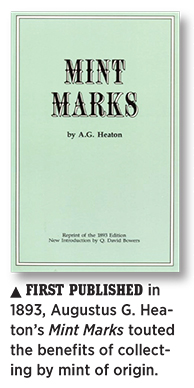
In August 1894, the annual ANA convention was held in Detroit. It was reported that 191 people were ANA members in good standing. Of that number, the division by states was as follows: Massachusetts and Michigan led the pack, each with 24 members, followed by New York with 20, then Pennsylvania (16), Illinois (14), Indiana (10), Rhode Island (7), New Jersey (7), Wisconsin (6), Nebraska (5), Ohio (4), Connecticut (4), Iowa (3), North Carolina (3), New Hampshire (3) and Virginia (3). Several other states had one or two each, and about twodozen members were located in foreign countries. Among those attending was young Howard R. Newcomb, a native of Detroit, who in later years would become one of the most prominent people in the hobby.
During this era, Heaton’s series “A Tour Among the Coin Dealers” attracted wide attention. Separately, his remarks on certain behind-the-scenes activities at auctions stirred up controversy. The grading of coins continued to be a popular subject for discussion, with few conclusions reached other than that there should be some kind of grading system.
ANA membership was growing steadily, and by March 1895 it was reported that the latest person to join the roster, C.H. Porter, of Winona, Minnesota, was assigned number 241. However, there were some vacancies among earlier numbers, and quite a few members had not renewed their dues. The annual convention was held in Washington, D.C., that summer.
In December, Heath was criticized sharply by Lancaster, Pennsylvania, dealer Charles Steiger walt, who said the ANA was wasting its money by publishing The Numismatist, as it was of no real value. Unstated was that Steigerwalt had recently launched his own magazine. By that time other dealers also had been critical, with some stating the magazine was revealing names of private individuals and information that should not be made public.
Quiet Times
In 1896 the hard-fought U.S. presidential contest of that year, which pitted Democrat William Jennings Bryan, an advocate of free and un limited coinage of silver to benefit Western interests, against conservative Republican William McKinley, spawned many varieties of anti-Bryan medals that became widely desired as collectibles. The ANA convention was advertised to take place in Philadelphia on September 18 and 19, but later was canceled. Heath voiced his frustration, stating that
up to the time the manuscript of this issue is given to our printer (August 27) no communication has been received from the officers of the Association further than has been published in these pages. We know no more regarding nominations, election and place of meeting than before.
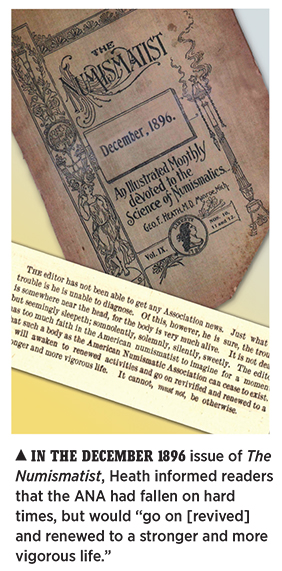
the editor has not been able to get any Association news. Just what the trouble is he is unable to diagnose. Of this, however, he is sure, the trouble is somewhere near the head, for the body is very much alive. It is not dead, but seemingly sleepeth; somnolently, solemnly, silently, sweetly. The editor has too much faith in the American numismatists to imagine for a moment that such a body as the American Numismatic Association can cease to exist. It will awaken to renewed activities and go on revivified and renewed to a stronger and more vigorous life. It cannot, must not, be otherwise. This magazine cannot, however, afford to remain with the inactive body longer, and until it arises with new habiliments and energy, shall remain detached and independent. In the meantime its efforts shall be toward resuscitation.
Thus, at the end of 1896, the editor and owner of The Numismatist
informed readers that it was no longer the official journal of the
Association. The ANA remained in suspended animation—or was it dead? No
one knew for sure.
Vive le Association!
In August 1897 Heath printed a letter from J.A. Heckelman, president of the Board of Trustees, which invited members to vote for new officers. This was all that was needed to revive the Association. Heath took up the fallen banner of the ANA and exclaimed, “Vive le Association!” The Numismatist resumed as the organization’s official publication.
In January 1898, a lengthy series titled “American Store or Business Cards” by Dr. Benjamin P. Wright made its debut. This catalyzed interest in such tokens to the extent that, for the next decade, they would be the hottest tickets in the numismatic market.
In April it was reported that the ANA had over 250 members. The Spanish-American War of 1898 resulted in various medals that were featured in The Numismatist as they were issued. No convention was held this year. The only successful annual gathering after the ANA’s formation was in 1894 in Detroit. The others were failures, according to Heath.
On December 14, 1899, the centennial of George Washington’s death, Lafayette commemorative dollars dated 1900 were struck by the Philadelphia Mint. As the ANA and the hobby of numismatics headed into 1900, the cusp of the new century, everything was looking up. The American economy had recovered, and the ANA was dynamic once again.
As relayed in this series last month, the 1890s were challenging for the ANA. After the enthusiasm of its founding in 1891, the growth of membership, and a successful convention in Detroit in 1894, the Association slowed down. Not helping matters was the economic recession following the Panic of 1893, which resulted in many bankruptcies and a slow coin market. At one point, ANA officers were not answering correspondence or providing information to Dr. George Heath, Association founder and editor of The Numismatist. Happily, things took a turn for the better later in the decade, and by 1900 The Numismatist once again was filled with news of Association activities.

By 1901, the market had perked up. Among the hottest tickets were merchant tokens and storecards inspired by a serialized study by Dr. Benjamin Wright featured in the Association’s magazine. Most merchant tokens were inexpensive—no more than $3 apiece for hundreds of varieties. Hard Times tokens, mostly the size of the large copper cents issued in 1832-44, were in the fast lane as well, catalyzed by a popular book, Hard Times Tokens, by Lyman H. Low (ANA Library Catalog No. PA73.L6).
Leading off in the January 1901 issue of The Numismatist was an article by George W. Rice, “The Copper Cents of the United States,” which gave an overview of the work of Sylvester Sage Crosby, Francis Worcester Doughty, Ed. Frossard and William Wallace Hays, and their descriptions of cent dies. “The copper cents have ever been in favor with the United States collectors, and probably more sets of them are being formed than any other coin, with a consequent effect on values,” Rice wrote.
Although this might seem strange to read today, there was hardly any interest in collecting United States coins by mintmark varieties in 1901, even though Augustus G. Heaton’s 1893 Mint Marks (GA80.H4) treatise was widely sold. Probably fewer than a dozen or so numismatists collected branch-mint Morgan silver dollars. Instead, these and other coins were acquired by date, and current proofs served to fill that need. Even so, interest in proofs was much lower in 1901 than it had been in the mid-1880s. More people collected Hard Times tokens by varieties than collected Seated Liberty and Barber coins or Morgan dollars by mintmarks.
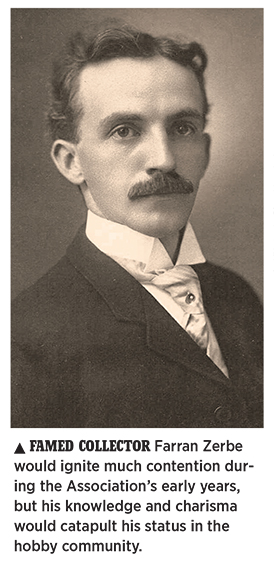
In 1901 The Numismatist announced that Joseph Lesher was planning to issue 10,000 souvenir “Referendum dollars”: “The silver will cost him $6,500, and the making $1,500. He will sell the coins for $12,500 and redeem them on demand for the same amount.” Today, a single “Lesher dollar” in high grade is valued at four figures. The byline of Farran Zerbe, a peripatetic young entrepreneur from Tyrone, Pennsylvania, appeared in various articles of the era, with no hint that by decade’s end he would create unprecedented controversy. The 1901 ANA convention was held that August in Buffalo, New York, as part of a schedule more occasional than annual. The venue was the medical office of ANA President Benjamin Wright, M.D. A woman named V.H. Eaton came into the convention, and the receptionist thought she was a patient. Amazingly, she was there as a collector—unprecedented in a hobby that most people thought was reserved for men.
At the Pan-American Exposition in Buffalo on September 6, an assassin shot President William McKinley. He was treated nearby, and a young part-time coin dealer, Thomas L. Elder, appointed as the official government telegrapher, relayed news of the president’s condition to the world until McKinley’s death on September 14.
Heath reminisced that, of the 61 ANA members active in its founding year of 1891, only 16 remained by 1901. During the year, 119 new members signed up, of whom 14 were age 50 or older. The average age was 381⁄2 years, with the youngest being 13 and the oldest 60.

In early 1903, the ANA roster comprised 450 names. The coin market was strong, and the American economy was growing. Zerbe landed a contract as the official distributor of the first American gold commemoratives—two varieties of gold dollars dated 1903. One depicted the late President McKinley, and the other featured Thomas Jefferson, who had negotiated the Louisiana Purchase in 1803. These coins were offered for $3 each, raising howls of protest from collectors and dealers. Sales were poor, and from a mintage of 125,000 each, only 17,500 of each specimen were saved from melting.
In other news, page 382 of the December 1903 issue of The Numismatist featured the magazine’s first advertisement, placed by teenager B. Max Mehl of Ft. Worth, Texas. He eventually became the most successful and famous rare coin dealer of his time, and remained so until passing in 1957.
A relatively new fad was the issuing of brass and aluminum tokens by coin collectors and dealers. Dozens of different varieties were made, and many were described and illustrated in print.
On another subject, it was stated that at the French Mint (Monnaie de Paris), the blasting of medals with fine sand at 180 feet per second gave them a pleasing “minutely granular or frosted” appearance. This pro-cess was carried over to the Philadelphia Mint and was used on proof gold coins from 1908 to 1915, much to the dissatisfaction of collectors.
Cream of the Crop
Heath tried to keep readers up-to-date on Association membership, elections (which typically were conducted at conventions, with some attendees holding many proxies from others) and other news, but information from the officers was sporadic and often incomplete. The October 1904 convention was held in St. Louis, with low attendance.
Each month, The Numismatist contained numerous classified advertisements. In the January 1906 issue, for example, J.C. Mitchelson, a prominent collector from Tariffville, Connecticut, took out space to state, “I cannot live without The Numismatist. It is the cream of my reading matter.”
In New York City, the American Numismatic and Archaeological Society announced that through a gift of railroad scion Archer M. Huntington, a property had been purchased on Audubon Terrace. There, a beautiful new headquarters, museum and library would be erected.

Old & New Favorites
In February 1907, great American rarities were showcased in The Numismatist, including the 1787 Brasher doubloon; an 1822 half eagle (so rare that it had been given little publicity over the years); an 1804 dollar; and 1783 Nova Constellatio silver patterns. Colonials, Early American coins, copper cents, various tokens and medals, and old paper money continued to be marketplace favorites.
The 1907 convention was held in Columbus, Ohio, starting on September 2, at the Neil House. The Association had 421 members—a number that was more or less unchanged in recent years—of whom 28 went to the gathering, plus some spouses. It was supposed that the current ANA president Albert Frey would stand for re-election, but he surprised everyone by declining. This set in motion a series of fierce backroom deals by six or seven members who held about 250 proxies. Zerbe wielded significant influence and was elected president. (Dr. J.M. Henderson, a close friend of Zerbe’s and a resident of Columbus, was the convention host in charge of arrangements and activities.)
In autumn, the new Indian Head $10 gold coin designed by Augustus Saint-Gaudens, America’s most famous sculptor (who had passed away on August 3), reached circulation. A nationwide commotion arose in the press when it was baselessly stated that Mary Cunningham, an attractive Irish immigrant and waitress, was the model. More excitement was created in December, when the beautiful Saint-Gaudens High Relief double eagles (gold $20) with the date in Roman numerals were released. There was a great rush to buy them, and their price quickly jumped to $30 each.
Meanwhile, Baltimore collector Frank G. Duffield discussed at length the flaws in the proxy system used to elect ANA officers. The process encouraged abuse, and those chosen might not really represent the membership. Nevertheless, no specific charges were made in the 1907 election. Zerbe later countered Duffield’s sentiments in a three-page article.
Changing Ownership
ANA founder George Heath died on June 16, 1908. He was widely mourned and fondly remembered. In a communication dated Au-gust 1, 1908, ANA President Zerbe reported a conference with representatives of the Heath estate. He journeyed to Monroe, Michigan, during the third week in July, and spent three days completing arrangements for the immediate future publication of The Numismatist. Since the first issue, Heath had owned, edited and, for six years, personally printed the magazine, and later allowed the ANA to use it as its official publication. Zerbe and collector How-land Wood made arrangements to take it over, relieving the Heath estate from the obligations of fulfilling subscriptions. But Zerbe purchased the magazine, not on behalf of the Association, as many thought was the case, but for himself. As of January 1909, he published it in Philadelphia.
The 1908 convention (by then an annual event) was held in Phila-delphia from September 28 to October 2 at the Hotel Stenton, and Mr. and Mrs. Henry Chapman were the social hosts. About 30 of the 556 members attended. Wood proposed that the ANA constitution be revised to formulate a better method than proxies to determine elections, and Zerbe pro-tested. The discussion was at a stalemate, and it was agreed to keep the old system in place for another year. The still-influential Zerbe was re-elected president.

On August 9, 1909, the annual convention opened in Montreal, Canada—its first time outside the United States. Running for president were Francis C. Higgins, a well-known New York City collector, and Dr. J.M. Henderson. Mailings were made on Higgins’ behalf to blast Zerbe and Henderson. In retaliation, Zerbe sent out a mailing that declared Higgins unfit for office. Coming to Higgins’ defense was Thomas L. Elder, who called Zerbe out in print, stating, “How it must pain you to talk to anybody who does his own thinking. Your oily, oozy, slimy phrases will make about as much impression as a pea shooter against a belt of armor plate. Never again will the American collectors be deceived.” (Years later, it was discovered that Zerbe encouraged “phony” members to join for six months so he could gain their proxies.)
Close to 50 members attended the Montreal convention, about 450 proxies were exercised, and Henderson won the election. The enmity of Elder, Higgins and others continued against Zerbe, his personal ownership of The Numismatist, the hucksterism they felt characterized his numismatic activities at fairs and expositions, and his general dishonesty. In Zerbe’s favor was that under his aegis, The Numismatist had better articles, and more content and illustrations than ever before.
In-House Publishing
At the 1910 convention in New York City, ANA President Henderson was elected to a second term in a contest that was remarkably quiet. (Zerbe’s detractors seemed to have given up.) Zerbe sold The Numismatist to Canadian W.W.C. Wilson, who gifted it to the Association.
Around the same time, further steps were made to adopt an official standard for grading coins. In the ANA’s Year Book for 1910, Howland Wood proposed a grading system with these distinc-tions: Proof, Uncirculated, Very Fine (“condition but little below Uncirculated, with imperceptible wear or showing only under close scrutiny”), Fine, Very Good, Good, Fair and Poor. He also noted:
Nicks, scratches, corrosion, tarnish, marks, faults in striking and in the planchet, file marks, discoloration, spots, etc., should be stated in the description of every coin above Good. The color of the coins, especially copper coins, should be stated if the piece is of any value. Coins brightened by che-micals should not be called bright, but should be termed “cleaned.” “Bright” and “brilliant” are terms defining the natural condition of the coins, not an artificial rendering of the surface. The terms “evenly struck,” “off center,” “weak” or “strong impression,” should be used in every case when the value of the coin warrants the additional description.
The book was intended to be an annual issue, but the idea faded. (Alas, it was not until the 1970s that the ANA adopted official grading standards.)
By 1911, The Numismatist was edited by Albert R. Frey of New York City, with George H. Blake and Edgar H. Adams assisting. A new column, “Live American Numismatic Items” by Adams, became very popular and often included previously unknown information. Partly because of finances, the appearance of the magazine suffered a great set-back. There were fewer illustrations, and the typography was less imaginative than it had been under Zerbe’s command. This rather plain format would continue for many years.
In a style reminiscent of Heath’s earlier writing, author Frank C. Higgins wrote in his column, “Numismatic Elements,” that the main appeal of a coin was its history and artistry. In this era, the investment aspect of coins was taken for granted by advanced collectors, although occasional articles pointed out past successes.
In August 1911, Frey lamented that The Numismatist was the work of just a few people, and the greater part of the Association didn’t seem to care.
There are 27 names on the page of officers, Board of Governors, and district secretaries which is to be found in every number of The Numismatist. Of these not more than 12, or less than half those who are directly responsible for the prosperity of the Association, have taken the trouble to communicate with the editor since the January number appeared!
In December 1910, it was reported that there were 654 members, but by August of the next year, the number dropped to 553. The 1911 convention was held in Chicago starting on August 28, and about 50 people attended. The balance in the ANA treasury was $175.76. Around this time, there was an anti-dealer feeling among some members, and it was suggested that they not be allowed to serve in an ANA office or on the Board. Judson Brenner, an Illinois collector, was elected president.
Frey cashed in his chips and resigned in December 1911, stating he had suffered from misunderstanding and little support. By this time, ANA membership was declining, and it was not a happy time for the Association. Printing of The Numismatist was transferred to The Stowell Press in Federalsburg, Maryland, a firm that would produce the publication for many years after. The good news was that the highly accomplished and personable Edgar H. Adams was given the editorial chair. Classified ads, absent for a long time, also resumed.
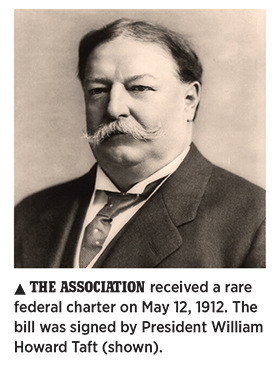
A milestone in the history of the Association took place in 1912, when Representative William Ashbrook (D-Ohio), an ardent collector, introduced a House bill to give the ANA a rare federal charter. “We are informed that the bill was passed only after the hardest kind of three-hour fight,” said Adams. It went to the Senate, was approved and became law on May 12, after it was signed by President William Howard Taft.
For some time, there had been controversy within the Associa-tion as to what position had the most power: the presidency or the chairmanship of the Board of Governors. Other issues within the ANA included changing the bylaws and deciding whether dealers were desirable as members. In the meantime, The Numismatist remained far and away the major benefit to members, as only 15 percent of them attended the annual conventions.
Minute die varieties of federal coins were described in many articles over a long period of time—ranging from colonials and early cents and tokens to Morgan silver dollars and a series about small cents by U.S. Navy Commodore W.C. Eaton:
I have to now report that the Denver Mint is already using, or has used, three different dies for the cents of 1912. [A]t least the “D” has been cut in three slightly differing places. In the first two a prolongation of the “1” downward would cut the right edge of the “D” but in one case the “D” is perceptibly nearer the “9” than in the other. In the third variety the “1” prolonged would miss the “D” altogether and the “D” is smaller than in either of the first two varieties. These three varieties were all mixed in one lot of 25 I have just received from the Mint.
In August 1912, the annual convention was held at New York’s Hotel Rochester in the city of the same name. Membership stood at 550, 55 of whom attended the meeting. Judson Brenner was re-elected president. Adams reported that, unlike similar recent gatherings, the event was warm and friendly from beginning to end.
For the first time since its inception, The Numismatist was financially self-supporting, helped in part by $10-per-page advertising rates. (B. Max Mehl start-led Adams by running a two-page notice that year.) The Indian Head/Buffalo nickel by James Earle Fraser debuted to wide acclaim. Official production began on February 17. Meanwhile, an employee at the Philadelphia Mint, Samuel W. Brown, secretly struck at least five nickels with the old Liberty Head design, one in proof and four with a lusterous finish, igniting a numismatic frenzy that continues today.

Standardized Grading
Similar to Benjamin Franklin’s wry observation on weather, stand- ardized coin grading was a subject that was discussed endlessly, but no one did anything about it. Incoming president Frank Duffield stated that the Association would do well by adopting the system proposed by Howland Wood in 1910, but he “would not place the dealers under obligation to adhere to it in their catalogues, though this would be the object sought.”
The annual convention was held in Springfield, Massachusetts, on August 22-26, 1914, and all officers were re-elected. Members totaled 579, of whom 68 attended the gathering.
With a fond farewell, Adams resigned as editor of The Numismatist on July 28, 1915. Current ANA President Duffield was appointed to the post and served into the 1940s.
The 1915 convention was held in San Francisco from August 30 to September 1. Neither the president nor the vice president made an appearance. The gathering set a record for low member attendance. Some attributed this to widespread dislike for Zerbe, who was present at the show.
Troubling Times
The Great War in Europe (known as World War I) began in August 1914. By 1916, various medals had been issued by Germany, the aggressor, as well as by the British and other Allies. The Numismatist devoted much space to chronicling these pieces from 1916 through the end of the decade. Those produced by Karl Goetz in Germany had particularly innovative and often provocative designs.
The year 1916 was highlighted by the long-hoped-for issuance of new circulating coin designs. Sculptor Adolph A. Weinman created the Winged Liberty Head dime (nicknamed the “Mercury” dime) and the Walking Liberty half dollar, while Hermon A. MacNeil designed the Standing Liberty quarter. The coins were released near the end of 1916 to widespread acclaim.
While many factories ran day and night to supply war materials to Europe, the mints were busy stamping out large quantities of coins. Although commerce was robust, this activity did not translate to the hobby. At the annual convention held in Baltimore in September 1916, only 38 members attended, and it was reported that membership had declined to 482.
Acclaim for the 1916 coins continued well into 1917, when MacNeil modified the quarter to depict Liberty in a suit of armor, signifying military preparedness. That same year, America joined the war in Europe. Duffield resolved to record in The Numismatist as many as possible of the hundreds of medals that had already been issued by both sides and the pieces to come.
The 1917 convention was held in a familiar venue, the Hotel Rochester, August 25-29. Membership had increased to 512, with 80 members in attendance, and Carl Wurtzbach was elected president. Editor Duffield later commented that:
The increasing popularity of ANA conventions and their power to attract members from a radius of several hundred miles can be attributed to two reasons. First is the numismatic side, of course, for during the three or four days devoted to the convention one simply breathes a numismatic atmosphere…The other reason is that our conventions have become occasions for what may best be described as “a corking good time.”
The war continued until the armistice of November 11, 1918. In the May 1918 issue, Dr. Malcolm Storer’s article, “Numismatic Bibliography of the United States,” furnished a valuable list of periodicals and other informative sources relating to American numismatics. While by no means complete, it treated major citations from The American Journal of Numismatics, The Numismatist and other important references, although at the time, numismatic bibliophilia was of little interest to people outside of museums.
Later that month, the U.S. Department of the Treasury began melting 350 million long-stored silver dollars under the Pittman Act, so that the resulting bullion could be shipped to England, whose own supplies were short. No accounting was made of the quantities destroyed. A later generation of collectors surmised that the melt included many varieties that later proved to be rare, despite generous mintages.
The postponed 1918 convention was scheduled for Philadelphia, but canceled because of an outbreak of influenza. The 1919 convention was held October 4-8, 1919. President Wurtzbach reported that membership stood at just 489. “The number in attendance was about the same as at Rochester two years ago,” he stated. Waldo C. Moore, a prolific researcher and writer, was elected president for the coming year.
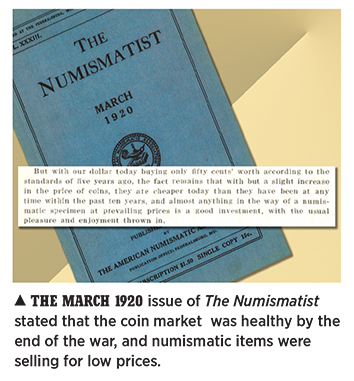
After the war, there was a general feeling that peace would result in a continuation of economic prosperity. The outlook for 1919 appeared bright. It was reported that in Europe, rare-coin auctions were setting records as pent-up reserves of buying power and enthusiasm were unleashed. In May, M. Sorenson proposed that a new silver dollar design be made to observe the victory in Europe. When such a commemorative became a reality in 1921, Zerbe claimed he thought of it first.
In July 1919, Duffield published “A Trial List of the Countermarked Modern Coins of the World,” the first in continuing installments that became the standard reference on the subject. Countermarks (or counterstamps) were placed on coins for many reasons, including the revaluation of a denomination; advertising; and vandalism. The initial series covered coins of Angola through Bolivia.
In March 1920, Duffield reflected that, unlike the prices of goods and services that rose sharply during the war, the coin market was relatively unchanged.
With our dollar today buying only fifty cents’ worth according to the standards of five years ago, the fact remains that with but a slight increase in the price of coins, they are cheaper today than they have been at any time within the past ten years, and almost anything in the way of a numismatic specimen at prevailing prices is a good investment, with the usual pleasure and enjoyment thrown in. The wise collector will not need to be urged to buy now to the extent of his ability.
The 1920 annual convention was held in Chicago, August 23-26, at the Hotel Sherman. Membership had increased to 603, and there was an aura of good feeling about the hobby and the market.
At the time, the most active collecting specialties in the United States were colonial and post-revolution coins; state coinage (popularized by a book by Hillyer C. Ryder and Henry Miller listing New England issues); Washington pieces; half cents (catalyzed by a book on the series by E.S. Gilbert); copper cents from 1793 to 1857; early silver and gold federal coins; patterns; and territorial gold.
Tokens of the early years through the Civil War had many advocates, as did Continental paper money, obsolete bank notes, fractional currency and Confederate paper. Interest in regular, large-size notes from 1861 to date was lukewarm and generally did not include notes from National Banks after the 19th century. Apart from U.S. issues, ancient coins were very popular, as were foreign issues and medals. Canadian coins were especially in demand.
As 1920 drew to a close, the Association and the hobby remained in good health, but more challenges were on the horizon.
Last month’s chronicle focused on Association highs and lows at the beginning of the 20th century. Businesses were growing rapidly, and coin production increased substantially at the start of the First World War. Continuing challenges included the lack of standardized coin grading and how to generate interest in the hobby. Despite the death of ANA founder George F. Heath in 1908, the future of the hobby was bright by 1921, and Association membership was climbing steadily.

Coin mintages reached rec-ord highs. In 1920 the Denver, Philadelphia and San Francisco Mints produced an unprecedented 809,500,000 pieces ranging from cents to half dollars. Silver dollars had not been struck since 1904. The postwar momentum ran out of steam, however, and in 1921, the call for consumer goods and services diminished, and coin production was sharply reduced from the spirited end of the last decade.
In the first ANA election of the new decade, only 203 members bothered to cast ballots. Moritz Wormser was elected president, succeeding Waldo C. Moore (a regular contributor to The Numismatist). The former would go on to serve a record six terms as president. Fred Joy won the post of first vice president; Frank H. Shumway, second vice president; and Alden Scott Boyer, treasurer. Six men were elected to the ANA Board of Governors.
As had been the case for many years, The Numismatist remained the primary benefit of ANA membership. Editor Frank G. Duffield continued his series, “A Trial List of the Countermarked Modern Coins of the World.” Attracting new faces to the hobby was desirable, and many articles gave suggestions for enticing new members.
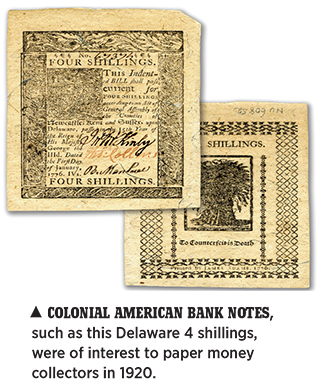
Popular collecting areas in the 1920s included colonial and Early American coins, with copper cents dated 1793 being a particular focus for collectors of die varieties. Vermont, Connecticut and Massachusetts state coins were in the fast lane as well, spurred by the release of State Coinages of New England (ANA Library Catalog No. GB80 .N44a) by the American Numismatic Society, which was comfortably situated in its temple-like headquarters on New York City’s Audubon Terrace. (This was in stark contrast to the ANA, which had no headquarters at the time.)
Tokens and medals also were favorites, with Civil War and Hard Times issues leading the pack. Federal coins were nearly always collected by date, as mintmarks were not particularly popular. Few people were interested in 1916-D dimes, 1901-S quarters and the like, and collectors would not discover the 1918/7-S quarter until 1931. (Looking through pocket change for potential finds was a rare pursuit.)
Commemoratives had a large following, and thousands of numismatists formed sets of the silver issues dating back to 1892. New commemorative half dollars were plentiful, including the 1920 and 1921 Pilgrim Tercentenary piece, 1921 Alabama and Missouri Centennial specimens, 1922 Grant Memorial issue, 1923-S Monroe Doctrine coin and many others. (Each of these received wide coverage in The Numismatist.) In 1926 the Oregon Trail series was launched, leading to more than a dozen date and mintmark combinations through 1939.
Gold commemoratives also com- manded great interest. (Lyman H. Low sold a 1915-S Panama-Pacific set with both types of $50 coin for $316.) There were no coin albums or holders available, and most collectors and dealers kept their treasures in paper envelopes measuring 2 x 2 inches.

On the Auction Block
Among the advertisers in 1921, B. Max Mehl announced the sale of the Honorable James H. Manning Collection, which included an 1804 silver dollar. Byrle B. Davis, a Los Angeles dealer, offered several varieties of privately minted gold coins, as well as other issues at fixed prices. Thomas L. Elder, trading as the Elder Coin & Curio Company, noted, “Our last sale brought over $15,000.” Wayte Raymond offered two price lists.
On December 7-17, 1921, Henry Chapman auctioned the John Story Jenks’ 7,302-lot collection, setting a record for bidder endurance, as sophisticated collectors and dealers felt compelled to examine every coin carefully. The sale brought $61,000, breaking the record for any coin auction ever held in America up to that time. Among the most active buyers was the cataloger himself, who advertised, “I bought largely at the Jenks sale, and if you are interested in any number, advise me which it is, and if I purchased it, we’ll price it.”
No guides listed market prices for coins, so this knowledge was gained by reading catalogs and advertisements, and tracking prices at auctions. As mentioned in last month’s article, there were no agreed-upon grading standards either, despite constant calls for such. One person’s Uncirculated might be another’s polished Extremely Fine (EF), resulting in much confusion.
Clean & Bright
While it was perfectly fine to let copper coins mellow from orange-red to various shades of brown, and while gold pieces often remained mint-fresh in appearance, silver specimens had the nasty habit of tarnishing. (Heaven forbid!) Throughout this era, contributors to The Numismatist gave advice on how to keep coins bright. The Philadelphia Mint’s numismatic holdings (known as the Mint Collection) had been cleaned with silver polish several times. In his room at the Hotel Metropole in London on June 24, 1922, J. Sanford Saltus brightened his silver coins with potassium cyanide. This chemical, despite its lethal nature, was widely used. It not only removed tarnish, but also microns of metal from coins’ surfaces. Gone were tiny hairlines and evidences of friction. Saltus mistook a glassof the cleaner for ginger ale. The coroner reported, “Death by misadventure.”
America was prosperous in 1925, prices were rising and the outlook was rosy. Thomas L. Elder wrote that while an orchestra seat at a grand opera was $9,a prime sirloin steak was $3.50, and a skilled stonemason earned $16 per day, “I don’t believe that collector’s prices have kept pace with the prices of things in many other fields.”

Circulating Currency
Coins circulating in the 1920s included Indian Head cents dating back to 1859 and the occasional Flying Eagle cent dated even earlier. Nickels of the Shield, Liberty Head and Indian Head/Buffalo types were common, as were Barber and later-date Seated Liberty coins. Silver dollars circulated in some Rocky Mountain states, but hardly anywhere else. Half eagles (gold $5), eagles (gold $10) and double eagles (gold $20) were available at banks, but did not circulate in commerce. Quarter eagles (gold $21⁄2) were struck into 1915, then again from 1925 to 1929, but for some reason were not readily available at face value. The denomination was officially terminated in 1929, which had a positive effect a few years later.
Circulating paper money ranged in denomination from $1 and up, with $1, $5 and $10 bills being the most popular. A number of parallel series were in commerce, each backed by authorizing legislation specifying the amounts that could be issued. These included Legal Tender notes; Silver Certificates backed by silver dollars stored by the U.S. Treasury (accounting in part for large numbers of such coins being minted in the 1920s); Gold Certificates backed by gold coins; Federal Reserve Bank notes; Federal Reserve notes; and National Bank notes. The last were mainly the Series of 1902 and were paid out by thousands of banks across the country. If a bank failed, as some did, the notes were still backed by the Treasury.
Important Business
The ANA’s August 1921 convention was held in Boston’s Copley Plaza Hotel. Membership in the Association climbed to 704. The pending release of the new silver “Peace” dollar was a popular topic of discussion. Dealers were tolerated at conventions, but not widely welcomed. The buying and selling of coins was apt to draw cold stares.
In August 1922, the ANA convention took place at the Great Northern Hotel in New York City. While dealing at such gatherings was frowned upon, it was typical to have an official auction. F.C.C. Boyd, who was rising rapidly in the ranks of dealers, conducted the affair. After the convention, Boyd hosted an evening at Coney Island, giving convention attendees tickets to Luna Park and other brilliantly illuminated attractions. (One couple was reported to have spent almost the entire time on the Honeymoon Express.)
The 1923 convention was held at the Windsor Hotel in Montreal, Quebec, Canada, a country that last hosted the show in 1909. The 1924 convention took place at the Hollenden Hotel in Cleveland, where it was announced that membership stood at 938. The auction, conducted by Henry Chapman, saw a 1793 Liberty Cap cent in Very Good grade sell for $33,a rare 1799 in Good for $16, and an 1839 Montreal side-view pennyin Very Fine grade hammer at $32.50. Entertainment one evening included a 30-piece saxophone band at Keith’s Palace Theatre.
The 1925 gathering was heldin Detroit, where a new high of 970 members was announced. At the auction, a “semi-proof” 1796 quarter sold for $20, an EF 1881 $3 piece went for $19, and a Lesher “dollar” issued by Boyd Park eclipsed these at $25.
In August 1926, members gathered in Washington, D.C., to spend several days exchanging views, giving programs, and buying and selling coins. Membership stood at 966.
Need for Books
In the early-to-mid 1920s, ample advertising space in The Numismatist attracted more collectors. During this decade, rare books and autographs brought record prices, as did Currier & Ives prints and other art. Julius Guttag offered an explanation as to the lassitude in numismatics:
Years ago the dealer gave freely of his knowledge and endeavored to educate the new collector as much as possible. Today many dealers make it their aim to keep the collector uninformed. During the past 20 years how many books or lists have been published by dealers? Outside of the books which Mr. Edgar H. Adams has issued, and through which interest in a new class of coins [patterns] has been stimulated, practically nothing of import has been contributed to our numismatic libraries.
If each and every dealer would show a live and honest interest in every new collector, encouraging him to join our Association, and perhaps the local numismatic club, I am sure it would not be long before a very live interest in numismatics would be revived. Further, a small pamphlet should be printed to give the history of coinage and the appeals of coin collecting.
It was true that books on Amer-ican coinage were few and outdated. Sylvester S. Crosby’s work on colonial coins was published in 1875, and had yet to be updated. The standard, but poorly compiled and uninteresting reference by J.W. Haseltine on early silver quarters, half dollars and dollars was issued in 1881. There was nothing of use on gold coins, early or modern. No publication featured mintage figures for coins from 1793 to date and, as noted, there were no price guides.

The Late 1920s
In 1924 the ANA launched National Coin Week, which in time became an annual tradition. Each issue of The Numismatist devoted at least a half page to numismatic societies and clubs. The usual report discussed coins and other numismatic objects that members brought for “show and tell,” as well as club business.
The 1927 convention was held in Hartford, Connecticut. Finally, membership crossed a magic line and stood at 1,002. The need for good numismatic publications was discussed, as was the idea that the ANA could create and publish new works, but this was rejected as being beyond the organization’s financial ability. Charles Markus was elected president, ending Wormser’s long and successful tenure. Elections, which had been very disruptive in previous years, were now quiet affairs—no name-calling, no defamatory pamphlets and no satirical tokens.
In 1928 the Hawaiian Sesquicentennial commemorative half dollar was released at a price of $2 and a mintage of 10,000. About half were sold in the islands, with the rest going to collectors. With-in the year, they were selling for $5!
In August 1928, the Hotel Seneca in Rochester, New York, hosted the convention. Area collector and dealer George Bauer showed color films via a new process developed by the local Eastman Kodak Company. (The product was not yet released to the general public, and caused a frenzy among convention attendees.)
The American economy was in overdrive in 1928. Skyscrapers were erected at a rapid pace in larger cities, art auctions set new records, luxury automobiles were all the rage, and many people could throw darts at a list of stocks, buy them and immediately make a profit.
In 1929 Raymond sold the regular edition of his book United States Gold Coins of the Philadelphia and Branch Mints (GB10 .R3u) for $1. The text was illustrated with six black-and-white plates and provided the retail values of all U.S. gold coins. No mintages were given, and historical information was virtually nonexistent.
M.L. Beistle of Shippensburg, Pennsylvania, who had started selling “Unique-brand” coin albums, published a new book on half-dollar varieties. New small-size paper money was issued to replace the large notes that had circulated since 1861. Record prices for certain coins, especially private and territorial gold issues, caused a stir in the auction room.
Although hardly anyone noticed, storm clouds were rising on the economic horizon in early 1929. The annual convention was held that August at the Congress Hotel in Chicago, and in October the stock market crashed.

In early 1930, there was still hope that the stock market would recover. However, too much damage had been done. Margin calls were made, and investors were wiped out. Although projects already underway were continued—the Empire State Building and Radio City Music Hall being examples—new construction was put on hold. Thus began a steep decline that destroyed the U.S. economy and caused great suffering. Numismat-ics had not benefited from the great inflation of the 1920s. No one bought coins on margin or borrowed against them.
In 1930 the coin market remained stable. No one could have predicted that as the American economy went down, interest in rare coins went up! Raymond secured the distributorship of Beistle’s Unique-brand notebook-style coin albums, which sold untold quantities in the years that followed. Meanwhile, J.K. Post of Neenah, Wisconsin, introduced “penny boards” in 1934. It was great sport for many collectors to look through pocket change and fill the holes. Wisconsin-based Whitman Publishing took notice, bought Post’s business, and the rest is history.
Within a year or two, coins were no longer priced generically. The low-mintage 1909-S VDB cent was hard to find in circulation, and dealers’ stocks quickly dwindled. The date/mintmark tradition started in a large way and never stopped. The discovery of a previously unknown 1817/4 half dollar was reported in The Numismatist.
In the summer of 1930, the ANA convention took place at the Hotel Statler in Buffalo, New York, the site of the first large commercial installation of a Wurlitzer theatre pipe organ. ANA membership had increased to 1,196 names—a new high. The 71 new members that year included no youngsters, as the required age to join was 21. (Many unqualified applicants had been rejected.) Local and regional coin clubs were expanding rapidly.
The market also grew apace. A report of prices realized in Mehl’s December 9, 1930, sale showed strength in all areas, with prices considerably higher than they had been a year or two earlier. Among world and ancient coins, a 1656 gold broad of Cromwell, proof, brought $62.50, a 1671 5-guineas realized $36, and a stater of Alexander the Great in “practically Uncirculated” grade fetched $36. The sale realized a total of $30,803.71.
The August 1931 convention was held at the Netherland Plaza Hotel in Cincinnati. In his message, ANA President George J. Bauer said:
In the face of an economic condition that has not only strained the resources of individuals but governments as well and threatened the stability of our social structure, your Association has made steady progress and you will be pleased to learn that our membership in good standing has increased from 1,196 to 1,244, a net gain of 48.
Unknown Market
Because of the weak economy in 1931, coinage production was low. The only denominations struck were the cent, nickel, dime and double eagle. Mintages remained low in 1932 as well. The big news that year was the advent of the Washington quarter, replacing the Standing Liberty design minted from 1916 to 1930. The Tenino, Washington, Chamber of Commerce introduced wooden nickels, and the long-familiar “Don’t take any wooden nickels” phrase became a reality. Duffield commented:
Collectors of all series of coins cannot fail to have noted the increasing number of those who collect the small United States cents in the higher grades of preservation and the consequent advance in prices of Uncle Sam’s humble coin…Many of the collectors of large cents, who a few years ago would not go beyond 1857, have also added the small cent to their specialty. This demand has had the effect of boosting prices, and many small cents in Uncirculated condition are selling today for a greater price than some of the late dates of large cents. 25 years ago Uncirculated small cents could be purchased at auction sales in lots of assorted dates at about two or three cents each.
To accommodate collectors, the Treasury Department stated it had a variety of 1921-32 coins from the Philadelphia, Denver and San Francisco Mints available to collectors (for face value plus postage), including cents, nickels, dimes, quarters, half dollars, Morgan and Peace dollars, and eagles and double eagles. (Indeed, a 1927-D double eagle purchased for $20 plus postage in 1932 could be a million-dollar coin today!)
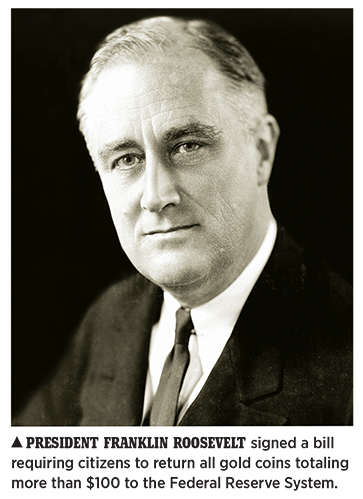
Improving The Numismatist was a hot topic of discussion. Some said it was fine as is, while others commented that it should be more scholarly, like the discontinued American Numismatic Journal. Perhaps the touché moment was furnished by a quip from Charles Markus: “I think The Numismatist should have nothing in it except learned discussions on the obolos of Lampsacus of Mysia.”
Goodbye Gold
In the summer of 1932, the quadrennial presidential election saw incumbent Herbert Hoover, famous for his “Recovery is just around the corner” comment, squaring off against Franklin D. Roosevelt, who promised a “New Deal” for America. Roosevelt won by a landslide.
Inaugurated on March 4, 1933, Roosevelt set about making changes immediately. William H. Woodin, a longtime numismatist and student of patterns and gold coins, was named Secretary of the Treasury. Banks were failing left and right, and the Depression showed no signs of letting up. America’s gold reserves were being depleted by people who squirreled away “hard money.”
On April 5, 1933, Roosevelt decreed that private individuals had to return all gold coins totaling more than $100 to the Federal Reserve System before May 1 of that year. Exempted were “gold coins and Gold Certificates in an amount not exceeding in the aggregate $100 belonging to any one person; and gold coins having a recognized special value to collectors of rare and unusual coins.” This included all quarter eagles, as they had been discontinued in 1929 and had a premium value.
Anyone not complying was subject to a fine not to exceed $10,000; imprisonment not to exceed more than 10 years; or both. The regulation was subsequently modified to remove the $100 provision, thus making it illegal for ordinary citizens to hold regular (non-numismatic) gold coins. In August 1933, the annual ANA convention was back in Chicago at the Congress Hotel. Merriment, buying and selling, programs and other activities contributed to an enjoyable event.
In 1934 Roosevelt raised the price of an ounce of gold to $35, effectively stealing millions of dollars from citizens who turned in gold coins for face value. A part of America’s freedom had been abridged, and citizens could not trade common foreign gold coins minted after 1933, or bullion and Gold Certificates until 1974.
These gold regulations had a far-reaching effect on numismatics. Some collectors, including Louis E. Eliasberg Sr. and Floyd Starr, accelerated their purchases of scarce and rare gold pieces. Interest multiplied, and Charlotte and Dahlonega gold in particular increased in value. Popular gold dollars and $3 coins went up in price. Dozens of people started collecting double eagles by date and mint.
Around this time, U.S. Mint and Treasury employees saved many rarities from the melting pot and became numismatic Robin Hoods. There was no loss to the government, for common coins of equal gold content had replaced them. In time, the gold was stored at Fort Knox, Kentucky.
Revolutionary Publication
In the summer of 1934, the Scott Stamp & Coin Company advised that its Standard Catalogue of United States Coins and Currency from 1652 to the Present Day (GA30 .R3u) would be ready on September 10, and was said to list and describe, for the first time in one volume, all United States coins and currency. Priced at $2.50, the volume was compiled by Raymond. The book was produced in 18 editions through 1957, and helped revolutionize coin collecting in America. It was the first widely distributed guide to coin values that would be updated on a reg-ular basis.
On August 18-23, 1934, the convention was held at the Carter Hotel in Cleveland. A dealer bourse was set up in the exhibit area. By this time, the ANA realized that attendees liked buying and selling coins at shows. About 100 people attended, including spouses.
Rise of Commemoratives
In 1935 the City of Hudson, New York, celebrated its 150th anniversary with a commemorative half dollar. Ten thousand pieces were authorized, coined and shipped to the First National Bank there, and sold for $1 each. A few advertisements were placed in advance, including one in The Numismatist. Those in charge of their distribution stopped to think: America was in the Depression, and after the coins arrived, there were no lines of buyers forming at the bank. What would be done if they did not sell?
Julius Guttag, who had been a prominent dealer in the 1920s and now was quietly buying and selling coins, learned of the dilemma and went to Hudson. He took most of the unsold coins off the committee’s hands for a reported 85 cents each. Not long after, advertisements for them began appearing. Orders poured in, and the market price jumped to $5 each!
In August 1935, the annual convention was held at the Webster Hall Hotel in Pittsburgh. The expansion of the hobby resulted in a membership high of 1,398 names, a gain of 223 over the previous year.
In 1936 commemorative half dollars dominated the news, overwhelming the coverage of just about everything else. In the January 1936 issue of The Numismatist, Mehl offered a selection of other commemoratives for sale under the headline “BUY NOW—Potential $10 and $20 coins for a fraction of their near-future value!” Nothing could go wrong! The news spread nationwide, and thousands of citizens became coin collectors. Toward the end of the year, the market ran out of new buyers and prices dropped, not to recover their levels until about 1941.
Auction Frenzy
A footnote for 1936 was what might have been a first, the “Daily Coin Auction” set up by W.R. Anderson in his Chicago shop. Coins were put on exhibition 10 days before each closing date.
Proof coins were issued for the first time since 1916. Individual cents, nickels, dimes, quarters and half dollars could be purchased, and a complete set was priced at $1.81. Just 3,387 quarters were sold, the lowest figure, which affected the number of sets that could be formed.
The 1936 convention took place in Minneapolis in late August. Four hundred and sixty names were added to the membership roster in the past year, raising the total to 1,863. Moritz Wormser, former six-term ANA president, formed the New Netherlands Coin Company, which opened its doors on September 15. Meanwhile, William Forrester Dunham, a longtime collector and ANA promoter, died in Chicago on October 12, at age 79. Mehl bought his collection, which included an 1822 half eagle and 1804 dollar, and began privately selling the coins.
On Solid Ground
In 1937 the Depression still pervaded America, the Dust Bowl was recent history and the economy was looking up. The worst era in financial history was balanced by the best era in numismatics.
Raymond’s Standard Catalogue with prices and mintages had indeed become standard. Coin albums and pages were available for all U.S. coins, many printed with information below the openings, others blank so information could be filled in. Collecting coins from cents to half dollars by date and mint was the most popular specialty. A certain low-mintage Lincoln cent was a hot ticket. Norman Schultz, a Salt Lake City dealer, advertised: “1931-S cent, Uncirculated, one of the rarest cents. These will sell very high in the future, each 50 cents.”
Silver dollars were of interest to fewer numismatists. Paper money, colonial coins, Civil War tokens and other pieces were not in the news as they had been in earlier decades. Commemoratives were dead in the water, but as many proposals for new issues were still in the pipeline, news of such filled pages in The Numismatist. Retail offerings bore such headlines as “Bargains Galore,” “Close-Out Prices,” “If You Are Looking For Bargains—Here They Are,” “Low Prices,” “Want To Dispose of 1,000 Commemorative Halves” and simply “Bargain Prices.” A contributor to The Numismatist noted:
I first attended auction sales in 1931 and got used to the low prices at which coins were selling then. Now I go to a sale and often come out without having spent a cent. Prices today seem to be about double what they were a year ago, at which time I also thought prices were high. I wouldn’t be surprised if this weren’t due entirely to the commemorative collectors who are now drifting into other fields.
Coin clubs proliferated across the country and were the ideal way to
spend an evening. The annual ANA convention was held in Washington,
D.C. Incredible growth in membership was reported—a jump of 664 names,
for a new high of 2,537!
By 1938, Mehl proclaimed he had $250,000 in capital, $500,000 in resources and operated “the largest numismatic establishment in the United States.” Stack’s noted that the firm had moved to larger premises at 32 West 46th Street, New York City, and that its library was available to all. The store was a virtual coin club, especially on Saturdays when collectors gathered to exchange ideas. The Jefferson nickel also made its debut that year.
Almost everyone could appreciate ANA Librarian William S. Dewey’s submitted list of misspellings of “numismatic,” which had come to his attention through mail addressed to the Association. The list included “numatic,” “numisatic,” “nunisatic,” “pneumatic” and many more. The annual convention was in Columbus, Ohio, at the Neil House. Membership had increased to 2,763.
In 1939 ANA President J. Henri Ripstra, a rather unpopular figure, drew many complaints, including wasting the Association’s money and advising collectors to rub their coins with baking soda and a bristle brush before dipping them in ammonia, which created hairline scratches on proofs. The 1939 convention took place at the Hotel Pennsylvania in New York City, and membership totaled 3,104.
Continuing Events
In 1939 hot topics included the cleaning of coins; whether ANA members seeking office should be allowed to gather proxies from those not attending the convention; and, perhaps most of all, the continued need for a grading system. Another dilemma was younger hobbyists. Time and again it had been recounted in The Numismatist that youngsters were some of the most interested and perceptive collectors, and commonly attended club meetings. However, the doors of the ANA were closed to them. Duffield mused, “The American Numismatic Association has a definite mission, which includes the training of young people…Today the Association is doing nothing in this regard.” The annual convention was held in Michigan at the Detroit-Leland Hotel, and membership reached 3,176.
Numismatics ended the span from 1921 to 1939 on an upbeat note. Membership in the Association had grown exponentially, and the market surprisingly boomed during the Great Depression. But a Second Great War on the horizon would change the world—and the hobby— forever.
As related in the April issue, the economic downturn of the Great Depression led to increased interest in rare coins. Mintages were low in the early 1930s, and by early 1933 the U.S. gold supply was rapidly depleting. President Franklin D. Roosevelt required citizens to turn in gold coins totaling more than $100 (except for those with numismatic value) to the Federal Reserve System or face a fine.

Setting the Scene
By 1941, all was well with numismatics in the United States. Commemorative coins—which had enjoyed a boom market in 1935 that continued into the summer of 1936, followed by a crash—were beginning to revive. Otherwise, prices were strong, with fairly consistent increases year after year as the hobby continued to attract more people.
Collecting coins from circulation was the launchpad for nearly every hobbyist. With a Whitman cardboard panel (later superseded by three-panel folders) and a pile of “pennies” from a bank or a friendly storekeeper, collectors were on the hunt to find rare 1909-S VDB or 1914-D cents. Beyond that, 1885 and 1912-S Liberty Head nickels were keepers, as were Barber silver coins of various mintmarks. Among other coins, 1916-D Mercury dimes and 1916 Standing Liberty quarters were prized. Upscale collectors bought “National” cardboard pages, which came in two basic sizes and were housed in ring binders. (These were marketed by Wayte Raymond for about a decade.)
Gold coins, especially popular in the 1930s after they disappeared from circulation, were eagerly sought, and dollars, A quarter eagles (gold $21/2) and $3 pieces were of particular interest. Saint-Gaudens double eagles (gold $20) by date and mintmark (most of which could be bought in uncirculated grades for less than $40) were in demand as well. Civil War and Hard Times tokens were hot, and colonial and Early American coins enjoyed a strong following. Raymond’s Standard Catalogue of United States Coins, published regularly, listed most issues in at least two grades and provided mintage figures.
Not much attention was paid to quality within a given cate-gory. Uncirculated and proof coins were simply described as such. Whether a piece had slight wear or some hairlines did not make much difference to buyers, and grading standards still did not exist. The “bright is best” philosophy continued, and nearly all collectors and dealers dipped or otherwise cleaned their silver coins when the pieces started to tone blue, brown or any other color. The Numismatist and The Numismatic Scrapbook Magazine, the two leading hobby publications at the time, carried advertisements for coin-cleaning chemicals.
Around the Marketplace
In January 1941, Frank Duffield, longtime editor of The Numismatist, presented a challenge:
It is up to the numismatic generation of today to train these erstwhile penny-board collectors into numismatists. They must be shown the greater values in the hobby than the mere collecting of dates and mintmarks from circulation. If the hobby had nothing but dates and insignificant letters to offer it would not be the fascinating science the real numismatist considers it to be.
This would have been an ideal situation, but like it or not, most collectors pursued dates and mintmarks, not only from circulation, but from coin shops, mail-order dealers and auction houses. Nearly every medium-sized city had a hobby shop that usually offered both coins and stamps, and sometimes toys, crafts and models.
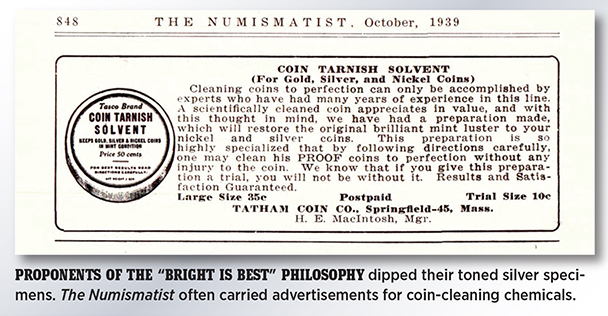
Among retail offerings, Frank-lin Coin Mart of Columbus, Ohio, suggested in a headline that readers should buy “Dollars for Speculation” and “lay a few of them away as they are becoming harder to get every day in Brilliant Uncirculated condition.” An 1883-CC was priced at $2.50; a 1921 Peace dollar could be had for $1.50; a 1928 went for $1.75; and a 1928-S could be ordered for $1.75. In Bowie, Maryland, John Zug continued to sell coins through the mail, featuring dimes, including a 1796 Extremely Fine for $15; an uncirculated 1814 for $6; a proof 1827 for $5; and an uncirculated 1853 “with arrows” for just 75 cents. (To see how spectacularly the coin market has performed since 1941, look up these issues in A Guide Book of United States Coins today!)
In New York City, Abe Kosoff, who styled himself as “A. Kosoff” and “Numismatic Gallery,” was a fresh face in the auction business, having started in 1941. New Neth-erlands Coin Company issued catalogs. The leader in the city was Stack’s, operated by brothers Joseph and Morton Stack, who had set up shop in 1933 and had conducted auctions since 1935. Also in New York City, the somewhat enigmatic J.C. Morgenthau & Company produced auction catalogs that were not much more than lists of dates, mintmarks and grades, with little or no history or salesmanship. These were cataloged by Raymond and James Macallister (the latter a Philadelphia dealer who came to the city by train on occasion). No one ever figured out who Morgenthau was, and it was a mystery why Raymond, a leading scholar of the era, turned out catalogs with little content. Barney Bluestone held auctions in Syracuse, New York, and M.H. Bolender created a series of mail-bid sales in Illinois.
B. Max Mehl, the most prominent dealer of all, was in Ft. Worth, Texas, where he held his “illustrious series of auctions” (as he called them). Actually, they were mail-bid sales, as there was no gallery or floor bidding. In June 1941, he offered the William Forrester Dunham Collection, highlighted by two great rarities: an 1804 silver dollar (the “King of American Coins”) and an 1822 half eagle (gold $5). The sale was a very peculiar event, as a later generation of scholars discovered. Mehl had purchased the collection outright and sold many coins, including the two showcase rarities, to private customers before the sale date. Further complicating matters, he made duplicate envelopes for some series and added coins from his stock so that multiple bidders each thought they were the only ones buying a lot!
In 1941 the Association’s National Coin Week, a tradition since the 1920s, was celebrated March 23-29. The objective was to create public displays of coins, tokens, medals or paper money for store windows and banks to generate more interest in the hobby. (This tradition is still observed today.)

Wartime
In 1939 Nazi Germany (under dictator Adolf Hitler) attacked and occupied Czechoslovakia and Poland, followed in 1940 by the Battle of Britain that laid many buildings in London to waste. Much of the European continent came under Nazi control. In the Pacific, the Japanese conquered China and other territories, while Italian dictator Benito Mussolini sent troops out to pillage and conquer. The United States was neutral, but many factories worked three shifts to supply military goods to England. The economy was more stable than it had been since the start of the Depression in 1929.
With the ongoing war in Europe, auction houses and dealers on the Continent fell silent, and numismatics was no longer truly international. On December 7, 1941, called “a date which will live in infamy” by President Frank-lin Roosevelt, Japanese naval forces launched aircraft and bombed the United States Navy installation at Pearl Harbor in Hawaii. Life in America, and the world, instantly changed.
Regarding numismatics on the home front, the hobby remained dynamic. In The Numismatist, editor Duffield stated that while the war was the first and fore-most challenge for America and its allies,
it is not possible for the American people to live successfully without relaxation and diversion. Recreation is essential; we are accustomed to it. Any attempt to get along without it is unwise. Numismatics will continue to prosper in America; serious collectors, as well as non-collectors, require it. In a war-torn world numismatics will continue to exist; we offer the hobby to those who require its message for the better performance of their daily duty.
Coins struck at the Philadelphia, Denver and San Francisco Mints during the war were the cent, nickel, dime, quarter and half dollar. With the need for copper in wartime materiel, zinc-coated steel was used for Lincoln cents in 1943. This proved to be unsatisfactory, as they were easily mistaken for dimes and became stained and spotted. In 1944 the copper alloy was resumed.
Nickel, which had comprised 25 percent of the content of 5-cent pieces, was eliminated in early 1942, and through 1945 an alloy of 56-percent copper, 35-percent silver and 9-percent manganese was used. These “wartime” nickels had the appearance of bright silver. To distinguish the alloys, mintmarks P, D and S were placed on the reverse above Monticello’s dome. This represented the first use of a Philadelphia mintmark.
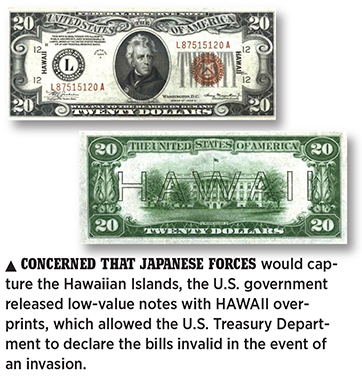
The American dollar was su-preme worldwide, including in war zones. In France, where the entire nation of tens of millions of people was controlled by fewer than 10,000 Nazi soldiers, American double eagles and other gold coins traded daily in an “underground” economy, the details of which were not publicly known until years later.
In 1942 the estate collection of the Garrett family was gifted to The Johns Hopkins University in Baltimore, Maryland. Stack’s in New York City offered $100,000 for the John H. Clapp Estate Collection on behalf of Louis Eliasberg, the same price paid by Raymond and John Work Garrett for the Colonel James Ellsworth Collection two decades earlier.
A snapshot of coin values was provided by “$19,154.50,” the title of Mehl’s full-page advertisement in The March issue of The Numismatist. The figure “is a lotta money at any time—especially this day and time,” he wrote. “But that’s the amount my recent sale realized!”

The auction conducted by Abe Kosoff realized more than $15,000. A complete set of proof and uncirculated 1883 to 1912-S Liberty Head nickels sold for $72.50; an uncirculated 1922-S $20 went for $62.50; and a worn 1855 Wass, Molitor & Co. $50 gold coin commanded $265.
In 1942 Duffield resigned as editor of The Numismatist, and several others filled that post in the coming years. First in the seat was Lee F. Hewitt, the publisher of The Numismatic Scrapbook Magazine, the largest-circulating coin journal of the time. He was soon followed by Burton H. Saxton, who in a later issue suggested that coin collecting could be a stabilizing influence during the turmoil of war, and that spending a satisfying hour with numismatic treasures of the past would produce relaxation and respite from the cares of the day.
The coin market changed forever in 1943. Kosoff’s sale of the Michael F. Higgy Collection on September 10 and 11 brought more than $30,000, with many pieces selling for multiples of Standard Catalogue values. The sale created a sensation, and prices of most coins, tokens, medals and paper currency rose dramatically. Beyond thousands of people discovering the lure and excitement of collecting, the fact that commodities and manufactured goods were scarce and cash was common meant ample funds were available.
No annual convention was held in 1943, but the following year, members gathered at the Hotel LaSalle in Chicago. Dealers’ tables were priced at $10. Attendance totaled 139 members and 51 visitors. ANA membership rose to almost 4,200, another record. In 1945 Stuart Mosher was appointed editor of The Numismatist. Numismatic Gallery, now with Kosoff and his new partner Abner Kreisberg, sold the silver pieces of “The World’s Greatest Collection” at auction. (An exaggeration perhaps, but the coins gathered by F.C.C. Boyd were indeed important.) Among silver dollars, a 1794 fetched $2,000, an uncirculated 1893-S Morgan realized $75 and an uncirculated 1873-CC sold for $110. The following prices were achieved for proof Seated Liberty dollars: 1840 $115; 1841 $150; 1842 $130; 1843 $150; 1844 $140; 1845 $150; 1847 $145; 1848 $135; 1849 $140; 1850 $150; 1851 $210; 1852 $180; 1853 $220; 1854 $75; 1855 $115; 1856 $70; and 1858 $180.
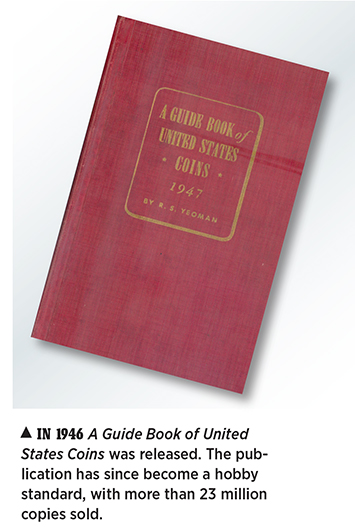
The war in Europe ended in 1945 with the unconditional surrender of Germany in May, and Japan in the Pacific in August, after atomic bombs leveled parts of Hiroshima and Nagasaki. In the following months, most Amer- ican combat men and women returned home. No ANA convention was held that year.
The Postwar Years
In 1946 the coin market—which included all numismatic items—was stronger than ever. The great rise in prices inspired countless investors to enter the market, seeking profits rather than any pleasures the traditional art and science of numismatics might offer. Collecting bank-wrapped rolls of uncirculated cents, nickels, dimes, quarters and half dollars from about 1934 on became wildly popular. Likewise, rolls of low-mintage cents, such as the 1931-S, were saved in large quantities, and mintage figures began to be published with greater frequency. Although scholars of the old school decried such activity, the hoarding of rolls and, to a lesser extent, proof sets, made many coins in uncirculated grades very common that might otherwise be viewed as rare.
High-grade rolls, bulk double eagles, commemoratives and other coins available in quantity spawned many new dealers. Entry into professional numismatics was easy, as all coins could be called uncirculated—no need to know about grading—and were simple to understand. Few such newcomers knew anything about or were the slightest bit interested in ancient and foreign coins, American colonial issues, patterns, Civil War tokens, Continental Currency or other foundational areas of traditional numismatics.
In 1946 commemorative half dollars were issued for the first time since 1939. The Iowa Centennial half dollar, with a 100,000 mintage, sold out rather quickly. The three-mint Booker T. Washington half dollars, which were struck through 1951, attracted mixed interest, and many went unsold. Roosevelt dimes replaced the Mercury design in 1946.
That same year, the annual convention was resumed in Davenport, Iowa. Membership was reported as 6,098, again a record. Coin clubs were dynamic and could be found in many towns across the country, typically meeting one evening each month. Numismatic Gallery sold the gold portion of “The World’s Greatest Collection”; the Hollinbeck Stamp & Coin Company (A.M. and Paul Kagin) conducted regular mail-bid sales; Mehl sold the William Cutler Atwater Collection (the 1804 dollar brought $10,500 and broke all records); and Stack’s was busier than ever.
In Autumn 1946, Whitman Publishing Company released the first edition of A Guide Book of United States Coins (the “Red Book”) with a cover date of 1947. The volume was researched and compiled by Stuart Mosher and several others under the direction of Richard S. Yeoman. The Red Book would go on to be printed annually thereafter and became one of the 10 best-selling books of all time. Within a few years, it surpassed Raymond’s Standard Catalogue of United States Coins as the go-to hobby reference. (Raymond’s book expired with the 18th edition in 1958.)

Later Years
In 1947 the Hotel Statler in Buffalo, New York, hosted the annual convention. (After announcing prices of $3.85 per day for a single and $8.80 for a room with double beds, the ANA had to inform members that the hotel increased its rates, customer relations being unimportant.) It was a time of nationwide prosperity and great inflation in the prices of goods and services. More and more Americans were traveling, and accommodations often were filled. A.M. and Paul Kagin said they would be at the show with an amazing $100,000 to spend on coins for inventory. At the August event, it was reported that membership was 7,236. Incoming president V. Leon Belt announced that his goal for the coming year was an increase of 2,000 names. At the auction by Numismatic Gallery, a five-piece set of 1915-S Panama-Pacific commemoratives sold for $1,350.
The ANA still had no headquarters. During this time and for years afterward, Lewis M. Reagan of Wichita, Kansas, was secretary and tended to most Association business, including membership, convention arrangements, printing contracts, dealer relations and more. He reported spending about 60 hours per week performing ANA duties.

The 1948 ANA convention was held in Boston. Among the new attendees was a young Walter Breen, who entertained the ladies by playing the piano in the hotel lobby. In the bar, J.V. McDermott, who usually could be found there, showed people the 1913 Liberty Head nickel he carried in his pocket. ANA membership enrollment was 1,140, including recent resignations and deaths. This was a new high, but short of the 2,000 hoped for.
The Association recorded a surprising loss of $11,407.33, mainly due to the rising cost of printing. To help offset this shortfall, annual dues were raised from $3 to $5. The lack of grading standards was among the topics discussed, and Lloyd B. Gettys was elected president.
New Dynamic
By 1949, the coin market had run out of steam. The price of gold coins, especially of double eagles in large lots, had dropped, and new investors were scarce. “Want to Buy” advertisements were infrequent. Consumer goods such as automobiles and appliances were widely available for the first time since before the war. Housing construction proceeded apace, with developers laying out whole towns in the East. There were lots of places to spend one’s money, and a chill pervaded the market.
In the January issue of The Numismatist, a feature article by G.R.L. Potter urged readers to use potassium cyanide to clean copper and silver coins, pointing out that because it was a lethal poison, care should be taken when using it. The “bright is best” philosophy that was in place for decades, continued. As a result, most silver coins, in particular, were cleaned multiple times, creating countless microscopic hairlines.
Arguably, at least in retrospect, the leading news of the era was the publication of Early American Cents, 1793-1814: An Exercise in Descriptive Classification with Tables of Rarity and Value (GB32.S5) by Dr. William H. Sheldon. It proposed a numerical grading system of 1 to 70, and rarity ratings of 1 to 8, for cents dated 1793 to 1814. At last, the fuzzy concepts of “Very Fine,” “Uncirculated,” “Scarce,” “Very Rare,” etc. were expressed numerically, just like prices in the stock market or measurements of the acreage of a piece of property. At last, such aspects were scientific, it was thought, and uncertainty would disappear. It did not quite work out that way. Today, many people worship such numbers, despite that they have not remained constant and that grading still is a matter of often widely differing opinions. David M. Bullowa stated:
If all new collectors would devote their attention to the information which is available in printed form they could be saved many dollars ultimately squandered upon inferior coins or otherwise not as represented, and which due to their lack of knowledge on the subject has proved to be an expensive lesson.
He went on to suggest that for every dollar spent on coins, the savvy buyer should spend at least 15 cents on books.

By 1950, the most popular specialty among ANA members was Lincoln cents, followed (not necessarily in any particular order) by Buffalo and Jefferson nickels; Mercury dimes; Standing Liberty and Washington quarters; Walking Liberty half dollars; and older Indian Head cents. Proof sets were issued for the first time since 1942 and were priced at $2.10 for five coins. The market registered a slight uptick, though prices remained low. Investors seeking rolls and proof sets were scarce, and the new sets, while interesting, did not generate wide excitement.
Walter Breen and John J. Ford Jr., both of whom were mentored by Wayte Raymond, were rapidly attracting recognition as rare-coin experts. Milferd H. Bolender published a useful book on silver dollars dated 1794 to 1803. Farran Zerbe, who joined the ANA in 1900, passed away.
Dealer Louis S. Werner advertised as “Money Back Werner” and later got into scrapes when he refused to give refunds on counterfeits (ranging from proof half cents to an 1804 dollar). He suggested that a new honor, intended to be the ANA’s highest, be named the Farran Zerbe Memorial Award, and it was.
Frank Katen, a respected dealer, became embroiled in a brawl with the ANA when he printed information accusing certain officers of improper actions, including wasting money, election fraud and stating that a candidate would never be elected “unless he played ball with the boys.” As a result, he was expelled on April 8. (There is much more to the story—a good reason to check the ANA website today and read back issues of The Numismatist.) Years later, the ANA apologized.
The 1950 convention took place at the Hotel Schroeder in Milwaukee. Membership dropped by another 328. In retrospect, students of numismatic history have said that the years 1949 and 1950 were the bottom of the market, but many changes were coming in the decades that followed.
In 1951 the market remained soft, as it had been since 1948 and 1949, particularly for series that had attracted investors earlier—such as bank-wrapped rolls of coins, commemoratives, proof sets and common gold. Collecting coins from circulation remained exciting, however, and three-panel Whitman folders made it easy to store and view a collection in progress. Each empty hole was a challenge. The Holy Grail was the 1909-S VDB Lincoln cent. Now and again, a lucky collector would find one and report it to Lee Hewitt, editor of the monthly Numismatic Scrapbook Magazine, the largest-circulation publication in the hobby. The Numismatist continued to be sent to ANA members and was a bit more formal, with extensive notes of club meetings, and research articles on topics from ancient to modern.
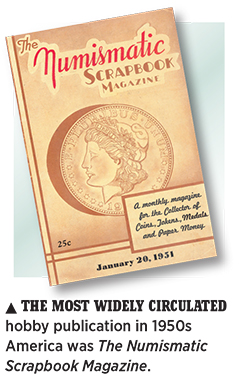
In Ft. Worth, Texas, B. Max Mehl, who had been dealing in coins since the early 1900s, continued his stream of auctions, which actually were mail-bid sales, as there was no live participation. He was slowing down, however. There were two dynamic companies in the auction field. The Numismatic Gallery, founded by Abe Kosoff in 1937 (with Abner Kreisberg as a partner since 1944), generated the most publicity. Kosoff continually wrote about people, the market and events in his catalogs. Located in Beverly Hills after a move from New York City in 1948, the Gallery relocated to a new address at 228 North Beverly Drive in 1951.
Meanwhile, in New York City, Stack’s (established in 1933 and dynamic in the auction business since 1935) continued a steady stream of sales, including large collections. Founders Joseph and Morton Stack were joined by their sons Norman, Ben and Harvey. Today, Harvey is the only dealer active in 1951 who can still be seen at coin shows now and again, but in a quiet mode. In Des Moines, Iowa, the Hollinbeck Coin Company, run by brothers A.M. and Paul Kagin, conducted frequent mail-bid sales.
Buying coins by mail order probably accounted for the largest total volume of sales. Dozens of dealers ran advertisements and issued catalogs, among them R. Green; Ben’s Stamp & Coin Company; Bebee’s; James F. Kelly; J.V. McDermott; James P. Randall; French’s; Charles Foster; Art Kelley; Louis S. Werner; and Hans M.F. Schulman. Most major cities had at least one coin shop, and many also sold stamps. Robert Friedberg operated a chain of coin boutiques in department stores.
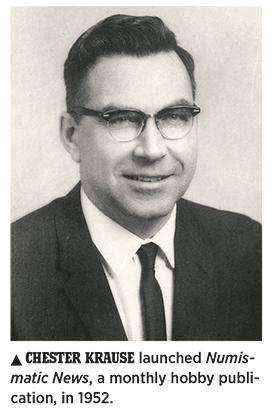
The Market Brightens
In 1952, for the first time since 1948, there was an uptick in ANA membership, which now stood at 7,774. Hooray! From this point, it would increase year after year. Prices inched upward as well. Commemorative half dollars became a hot-ticket item, especially those minted from 1892 to 1946. Modern proof sets also were in strong demand.
In the January 1952 issue of The Numismatist, Walter Breen contributed an article, “Survey of American Coin Hoards.” Increasingly, his published research made him the single person to turn to with questions about mintage and history. Breen’s star would continue to rise in coming years. Contributions from others increased, including research by Eric P. Newman; the father-and-son team of George and Melvin Fuld; John J. Ford Jr.; Raymond H. Will-iamson; Kenneth E. Bressett; and Harry X Boosel. In 1952 in Iola, Wisconsin, Chester (“Chet”) Krause launched the monthly publication Numismatic News.
The pace of the market continued to pick up. In 1952 the ANA’s anniversary convention was held in New York City. The auction catalog for the event was unprecedented in size and had sections contributed by four different firms. The New Netherlands Coin Company portion created a sensation. For the first time, coins and other items were described in detail throughout, accompanied by research information by Walter Breen. The sale grossed more than $100,000—an unheard-of total.
While American coins from colonials to modern proofs were the main focus of interest to collectors, ancient and foreign specimens each had many devotees. The coins of Canada in particular attracted much attention.
In 1952 I discovered the world’s greatest hobby via two Whitman folders—one for Lincoln cents from 1909 to 1940, and the second for 1941 to date—and a copy of the Red Book. (From this point forward, I can write from first-hand experience.)
Continuing Activity
The field of collectable currency was given a boost by the 1953 publication of Robert Friedberg’s Paper Money of the United States (US20.F7). Stuart Mosher, a long-time scholar and, for a short time, the curator of the numismatic collection at the Smithsonian Institution, was editor of The Numismatist and received $2,700 annually for his efforts. Coin clubs increased rapidly. It was fun to have an evening meeting once a month. The typical gathering included a recitation of news from The Numismatist and The Numismatic Scrapbook Magazine; a program (frequently with slides furnished by the ANA); show-and- tell, with the latest finds or purchases; and a club auction. Editor Mosher told club secretaries to cut down the amount of information they were sending about meetings, as The Numismatist was running out of space!
Collecting coins from circulation continued to be a magnet for newcomers. In theory, it was possible to find all Lincoln cents back to 1909, plus Buffalo nickels and the occasional Indian Head cent from 1913 onward; the stray Liberty Head nickel from 1883 onward; and dimes, quarters and half dollars from 1916 onward. Barber dimes and quarters were scarce and when found were usually worn nearly smooth. Barber halves were seen more often and were in low grades as well. In one afternoon at the Forty Fort State Bank in Pennsylvania, I filled two Whitman folders with a complete date and mint set of Walking Liberty half dollars from 1916 to 1947. Most, if not all, banks had a supply of silver dollars in their vaults, and friendly tellers often would allow collectors to sort through them.

At the time, there was no particular distinction in grading uncirculated and proof coins other than to use the term “Brilliant,” abbreviated as BU. Coins had to be bright in order to attract buyers, and collectors and dealers alike routinely cleaned their pieces. Had this not occurred, all proofs in existence today would be flawless and without hairlines. Coins at conventions and auctions nearly always were stored in 2 x 2-inch paper envelopes, although plastic holders were becoming increasingly popular. In 1953 Stack’s moved to 123 West 57th Street in New York City, a location it would occupy for decades to come.
The annual ANA convention took place in Dallas in 1953, and J. Hewitt Judd was the new president. That same year, the second general assembly of the International Association of Professional Numismatists (IAPN) was held. The convention auction was dynamic, confirming that the rare coin market was strong once again. Lot number 1 was a beautiful, uncirculated 1856 Flying Eagle cent estimated at $200, which set a record at $230. A group of 48 different types of commemorative half dollars went for $460, and a full set of mint-state and proof 2-cent pieces sold for $140. A 1796 half dollar graded Fine soared to $300, and a set of uncirculated Mercury dimes commanded $575.
While attending high school in 1953, I became a part-time dealer, starting a career that extends to the present day. My specialties at the outset were patterns, colonials, and early half cents and large cents. I memorized many varieties and at coin shows was able to find many rare issues for generic prices. David M. Bullowa, a highly regarded Philadelphia dealer, died that year. His company was successfully continued by his widow, Catherine, under the “Coinhunter” moniker. (She was an honored guest at the 2015 ANA World’s Fair of Money® banquet in Chicago.)
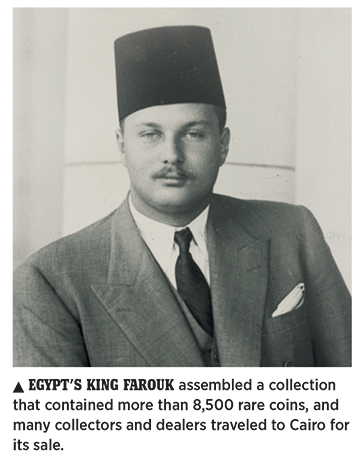
The sale in Cairo of the Palace Collection of ousted playboy King Farouk was the prime news item of 1954. More than 8,500 coins and medals were represented. The American series included many rarities, most of which were poorly cataloged and grouped in lots, such as a set of Liberty Head nickels containing the rare 1913 specimen. More than a dozen American dealers and collectors attended and divided the spoils, most of which sold for fractions of market value. After the sale, the two “AKs”—Abner Kreisberg, who was holding down the Numismatic Gallery fort, and Abe Ko-soff, who was in Egypt—had a falling out. The Numismatic Gallery was dissolved, leaving the lion’s share of the coin auction business to Stack’s and the increasingly popular New Netherlands Coin Company, with its catalogs written by Breen and Ford.
Action was very strong in April at the Davis-Graves sale conducted by Stack’s. An 1804 silver dollar opened at $2,500 and soared to $8,000. An 1822 quarter with error reverse, described as a proof, went to a buyer for $600; an 1841 quarter eagle fetched $6,000; gold proof sets of 1882 and 1883 brought $875 and $1,865, respectively; and the unique 1794 dollar in copper sold for $1,400, or just slightly more than twice the $600 price a silver strike fetched.
The market was in high gear indeed. For the next several years, it was common for dealers to advertise that they were paying more than Red Book prices for scarce and rare coins. The annual ANA convention was in Cleveland in 1954. All was well, and membership rose to a new high of nearly 9,427. The proxy system of voting, whereby candidates could round up and collect bids by mail to present at the election, was abolished in favor of direct voting. More than two dozen coin clubs were formed. Now there was one within driving distance of almost every collector.

The growth of the ANA, the hobby and the market increased in the mid-1950s. The 1955 convention in Omaha saw attendance cross the 500 mark—a record. It was my first ANA show. (Coming up in August of this year, I will have attended more annual conventions than anyone, a situation that has been true for a number of years now.) The Professional Numismatists Guild (PNG) held its first meeting there.
Investing in rolls and proof sets continued apace, and the mint had to restrict orders for proofs. In 1955, a record 378,200 were sold. The Treasury Department reviewed the cost of coin production and found that the more-efficient Denver Mint could make coins for the West Coast more cheaply than the San Francisco Mint could. After producing 1955-S cents and dimes, the presses shut down, seemingly forever, and later the facility was renamed the San Francisco Assay Office. The market for proof sets was on fire. Dealer Sol Kaplan put up a large chalkboard at shows with bid and ask prices for sets from 1936 to date.
In 1955 at the Philadelphia Mint, an error die was used to strike cents, and about 24,000 specimens were released. The mistake was caught, and the die was removed from the press. The 1955 “Doubled Die” cent subseqently became famous, and today is a gem that sells for thousands of dollars!
Early in 1956, the price of a 1936 proof set rose from $300 to a new high of $600. At the Central States Numismatic Society show, the market ran out of buyers and collapsed. Momentum continued with the general public, and in 1957 the mintage of proof sets crossed the million mark for the first time (1,249,952). The market remained weak, and sets purchased for $2.10 were worth less when resold. Mintages dropped, and it was not until 1960 that a new record was set. Not to worry—the rest of the market was headed onward and upward!
In 1956 the Congress Hotel in Chicago was the site of the annual convention. Attendance was a record 1,029. Association membership also was a record at 11,669. At the Northern Trust Company bank in the same city, the Louis E. Eliasberg Collection was displayed under tight security, with showings reserved exclusively for ANA members. During the 1950s, Association con- ventions did not have security rooms, and it was common for collectors and dealers to carry locks so they could put valuable items in their hotel room closets. At each convention, new officers were elected, often without competition, and reports were given regarding finances, the number of books borrowed by mail from the library, and more.
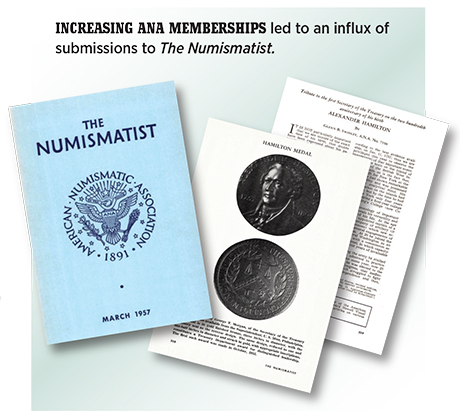
In 1956 Wayte Raymond, who had been in the coin business since the early 20th century, passed away. In 1957 B. Max Mehl died and Richard D. Kenney, a prominent researcher, passed away at the young age of 39. The old order of dealers and scholars was giving way to the new.
The 1957 convention was held in Philadelphia at the Sheraton Hotel. Single rooms cost $8.50, doubles $13. Membership kept going up, and the roster stood at 13,562. Dealers had a hard time buying for stock, as choice material was scarce. At the show, my table was overwhelmed with buyers, often standing in line a half dozen deep. I had never seen anything like it. Seventy-two coin clubs became affiliated with the ANA. Admiral Oscar H. Dodson, a fine gentleman and scholar, was reelected president. Elston G. Bradfield, editor of The Numismatist, was receiving more news and articles than he had room to print. Everything was coming up roses…well, almost. The Professional Numismatists Guild had been holding PNG Day events prior to certain conventions, including those of the ANA. During this era, many complained that this was unfair, as PNG membership was limited to those chosen by existing members via secret ballot, in the manner of a private club. The entire matter of having dealers at shows was condemned by some, with one ANA Board member calling dealers a “necessary evil.” Abe Kosoff, ever the gentleman, did much to smooth relations. Eventually, the two organizations moved forward in harness to promote the hobby, and PNG was opened to all qualified dealers.
That autumn, Jim Ruddy, bidding on my behalf while I was studying at Penn State, bought an 1894-S Barber dime for a record $4,750 from Stack’s sale of the Empire Collection. The idea of a teenager (I was 18 at the time) paying such a huge amount for an old, thin dime made nationwide news. I received more than 6,000 letters and postcards, and for the first time I went on television, NBC’s Today Show. In 1958 Ruddy and I merged our dealerships to form the Empire Coin Company.
Dr. Robert Bilinski took out a succession of full-page advertisements promoting his book, A Guide to Coin Investment (GA55 .B55), which he billed as “the most amazing report ever completed on investment practices within a hobby.” A roll of 1950-D nickels sold for $20—yielding a great profit to anyone who cared to sell. Sellers were few, however, and buyers were numerous.
The Late 1950s
In 1958 the 18th and final edition of the Standard Catalogue of United States Coins was published. The rights were acquired by John J. Ford Jr., who wanted me to take the lead in compiling the 19th edition. However, Empire Coin Company was growing by leaps and bounds, and I declined. Other dealerships were prospering as well. Prices of coins kept going up, up, and up some more, and in many instances were multiples of what they had been earlier in the decade. Inventory had to be marked up constantly.
A Guide to the Grading of United States Coins (GA50.B72) by M.R. Brown and John W. Dunn was published that same year. “A book for the beginner as well as the advanced collector,” the notice read. “How to grade all regular United States coins. New—this is the first publication that has gathered together reliable information which will serve as a guide to the grading of circulated United States coins.” This did little to solve the problem, as interpretations continued to differ widely.
In June 1958, Frank J. Katen of Washington, D.C., offered his 29th mail-bid catalog, his first after a lapse of four years. All 1,244 lots consisted of numismatic literature, a first for Katen and a highly unusual offering for the time. Thereafter, he dealt primarily in that field and helped to launch a market in coin books, catalogs and magazines that has thrived ever since.
The 1958 ANA auction, conducted in Los Angeles by Abe Kosoff, featured the first 1943 copper Lincoln cent ever to cross the block, surprising Lee F. Hewitt, who said that no authentic specimens existed. This piece seemed to pass muster, but was withdrawn when Kosoff had a dispute with the consignor. Auction prices reflected the strength of the market: 1795 uncirculated half dime $175; 1860 pattern half dime $335; 1792 half disme in copper $650; 1796 uncirculated dime $330; 1859 transitional pattern dime $1,125; set of proof Morgan dollars $1,600; set of gold $1 and $21⁄2 commemoratives $735; set of uncirculated and proof 3-cent silver pieces $730; and an 1894 proof double eagle (gold $20) $1,150. ANA membership reached another record—15,032—an increase of about 11 percent.

In December, dealer Richard Picker had a telephone line connected to a New Netherlands Coin Company auction room, and took bids from a distant client. This caused a storm of protest from collectors and dealers who had paid to come to New York City to attend in person. Picker apologized, saying his client had hoped to participate, but had an illness in his family. (Things have changed since then!) In the same city, Lester Merkin, a professional clarinetist who had been a collector for many years, was fast gaining a good reputation with his new coin dealership. Elston G. Bradfield was still editor of The Numismatist.
Regional coin shows were dynamic, including the fourth convention held by the Florida United Numismatists (FUN) that featured 37 dealers and drew 2,000 people. More than 1,300 came to the Numismatic Association of Southern California’s show held in Los Angeles in February. The Penn-Ohio spring convention in Cleveland set records, as did most, if not all, other shows.
John J. Ford Jr. placed full-page advertisements in The Numismatist offering to buy Western Americana, and was rewarded by finding many previously unknown gold coins and ingots, including an 1855 Blake & Co. $20; a Diana gambling club coin of the same denomination; gold bars saved by a madam who almost, but not quite, escaped drowning when the S.S. Brother Jonathan sank in 1865; three Bowie half eagles; and a marvelous trove of 1853 U.S. Assay Office gold proof $20s. (Years later, most were found to be fantasies and fakes.)
A review of the 1960 edition of the Red Book, which was released in July 1959, stated that prices had risen since the last edition and that “coin values are more than keeping pace with inflation.” For the first time, the 1955 doubled-die cent was listed for $30 in Extremely Fine, and $50 in Mint State. At the summer convention in Portland, Oregon, it was announced that a record 2,725 members had joined in the past year. Oscar H. Dodson was reelected president. In autumn, Kenneth E. Bressett, the first person to develop a convenient portable camera for photographing coins, joined the staff of Whitman Publishing to work with Richard S. Yeoman on the annual Guide Book. Rolls of 1950-D nickels, in demand for investment, reached $60.
A new work, United States Pattern, Experimental and Trial Pieces (GA90.J8) by Dr. J. Hewitt Judd was published by Whitman, the first book on the subject since 1913. At the Smithsonian Institution, Dr. Vladimir Clain-Stefanelli and his wife, Elvira, were busy reorganizing the National Numismatic Collection into what would become a spectacular display.

The hobby of numismatics continued to change in 1960. While it was common knowledge that carefully building a fine collection and holding it for a number of years nearly always resulted in a profit when the coins were sold, enjoyment was primary and investment was a natural counterpart. Now, investment became primary in the minds of many newcomers.
On April 21, 1960, J. Oliver Amos of the Sidney Printing and Publishing Company (Ohio) launched the first weekly numismatic publication—Coin World. D. Wayne (“Dick”) Johnson was editor. He had a fine sense of humor, stating, for example, that a “Medium Date” was a night out with a fortune-teller. A subscription was $3 a year, and the paper became an instant success.
About the same time, it was publicized that certain earlier Philadelphia Mint strikes of the current Lincoln cents had the date in smaller numerals. The “Small Date” coins proved hard to find. A $50 face value bag sold for $10,000, followed by several sales at the $12,000 level—mainly by dealers Jonah Shapiro and Harry J. Forman. How exciting! Time magazine ran a story, television and newspapers covered it nationwide, and the race was on!
Almost overnight, millions of people became interested in rare coins, and within a short time more than 100,000 collectors subscribed to Coin World. By year’s end, prices had jumped across the board and countless new dealers went into business. (Chet Krause estimated the total number at about 6,000.)
Leading the market were uncirculated rolls, commemorative coins and common-date gold, such as Saint-Gaudens double eagles, plus proof coins from the 19th century onward. By trading only in such coins, an inexperienced dealer did not have to have any knowledge about grading or authenticity. All that was needed was a checkbook and a list of market prices. It was suggested to Bressett that the Guide Book eliminate the listings for colonial coins and territorial gold, as these were not in the mainstream or of interest to investors. In fact, an investor would not even look at a 1652 Pine Tree shilling.
Counter to this, many old-timers in the hobby, as well as newcomers interested in particular series, corresponded among themselves. In 1960 at the annual convention in Boston, the Rittenhouse Society of writers and researchers, envisioned in 1957, had its first meeting, only the second specialized numismatic group to be formed. (The American Vecturist Society of transportation-token collectors started in 1947.) The coming decade would see the formation of several other groups dedicated to subjects such as tokens and medals, paper money and early coppers.
At the Boston show, President Dodson announced that ANA membership had increased by 4,000 names, or 18 percent, during the year, nearly touching the 20,000 mark. The governors of the Association started a building fund with a deposit of $20,000, plus a $2,000 check from Whitman Publishing.
Numismatics, now a mix of collectors and investors, was dynamic. The future was brighter than ever.
This month, I continue my overview of the American Numismatic Association, its people and activities, and historic events pertaining to coins, tokens, medals and paper money. The present installment covers the early 1960s, one of the most unsettled times in ANA and numismatic history.
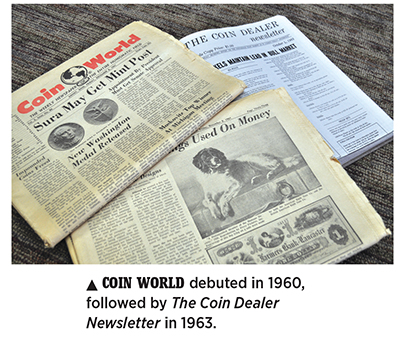
In 1960 two dynamic events occurred: Coin World, the first weekly hobby newspaper, was launched in April and became an immediate success. At the same time, the nation was buzzing about the 1960 “Small Date” Lincoln cents, which were rare in comparison to those struck with larger numerals after the beginning of the year. It was very exciting to see the news spread across the country that a bag of 1960 cents with a $50 face value could sell for $12,000! Almost overnight, tens of thousands of people discovered the coin-collecting hobby.
By that time, the art and science of numismatics was going strong. Collectors collected and dealers dealt in American, world and ancient coins, many specializing in die varieties such as early copper cents (1793-1814), Capped Bust and early half dollars (1794-1836), the 39 different varieties of Vermont copper coins (1785-88) and Civil War tokens (1861-64). Collecting these required a knowledge of grading, counterfeit detection and more. It was a challenging but fun pursuit, and aftear a few years’ experience, a hobbyist was likely to have a real sense of accomplishment despite making some mistakes along the way.
In addition, another activity was energizing the market: investing in bank-wrapped rolls, proof sets and commemoratives. This material was bought and sold as Brilliant Uncirculated (BU) or proof—no numerical grading designations yet. A checkbook with a healthy balance was all that was needed.
The pulse of the investment market was reflected by 40-coin rolls of 1950-D nickels. In that year, the Denver Mint produced only 2,630,000—fewer than in any year since the release of the 1931-S nickel. (By comparison, 36,498,000 1949-D nickels were struck.) When the 1950-D mintage figure was announced in early 1951, fireworks erupted! Everyone wanted some, preferably in $2 rolls of 40 coins. By the summer of 1951, rolls were selling for $5 each. The excitement continued and prices escalated, with a roll bringing $15, then $30, then $50. By 1960, a roll commanded about $200.

In 1961 traditional numismatics still was thriving as specialists continued to seek early cents, pattern coins, colonials, Shield and Liberty Head nickels, Continental paper money, territorial gold and other series. However, most new money coming into the field was from investors who continued to be attracted by the simplicity of writing checks and acquiring rolls, proof sets and other items that were said to be “investment quality.”
In addition, collectors showed interest in common-date double eagles (gold $20). Success begat success: Coin World’s subscription base crossed the 100,000 mark, and prices of 1950-D nickels, proof sets minted since 1936, commemoratives and other investment favorites rose, with many items doubling and tripling in value. My gosh, a roll of 1950-D nickels was worth $500!
To attract investors, coins had to be brilliant, or no sale! Hobbyists wanting to brighten their coins undoubtedly took advantage of advertisements in The Numismatist for such products as “Brilliantize” (“Makes copper, silver, other coins brilliant instantly—safe for Proof coins”), Copper Coin Cleaner, (“Easy to use and economical!—Fast action—It actually cleans in seconds!”), “E-Z-est Jeweluster” (“Removes tarnish and oxidation instantly—The perfect coin cleaner”) and “Magicsheen” (“It’s fantastic—It works like magic—The perfect and safe coin cleaner guaranteed to clean all coins—One application does it”).

While Coin World was growing, Numismatic News, then published monthly, was expanding as well. News founder Chet Krause announced that his staff in Iola, Wisconsin, had increased to nine people with the addition of Edward C. Rochette, a journalist from Worcester, Massachusetts.
On the dealer scene, Stack’s, the “First Family in Numismatics,” continued operation under founders Joseph B. and Morton Stack, and their sons Benjamin, Harvey and Norman. New Netherlands Coin Company in New York City had earned a high reputation for numismatic scholarship, with auction catalogs prepared by John J. Ford Jr. and Walter H. Breen. The latter was far and away the most honored writer and researcher in the hobby —making many new discoveries. Others, such as Eric Newman, George Fuld, Kenneth Bressett and myself, were less prolific and less publicized. The Hollinbeck-Kagin Coin Company, operated by Arthur M. and Paul Kagin in Des Moines, Iowa, conducted regular mail-bid sales. In New York City, Lester Merkin’s auctions attracted a lot of attention, and in Boston, Mayflower Coin Auctions handled lots of nice material.
Abe Kosoff, operating a mail-order business from Encino, California, reminded ANA members that the William Idler specimen of the 1804 silver dollar and a 1913 Liberty Head nickel soon would be auctioned as part of the Edwin M. Hydeman Collection, and that the coin would be in good company with numerous other rarities. Harry Forman, Jonah Shapiro, M. Hirschhorn, J. Grove Loser (pronounced “Lowzer”) and Klondyke Coin Exchange dealt in many coins that were favored by investors.
With Jim Ruddy, I was busy running the Empire Coin Company, which in 1961 was the hobby’s largest advertiser and achieved an unheard-of $1 million in annual retail sales. Among our offerings in 1961 were a gem 1909-S VDB cent for $109.50; gem Barber quarters for $9.95 each; and a half-dollar type set for $17.95. (No one dreamed that a couple generations later, in 1996, a single U.S. coin would cross the auction block for more than $1 million.)
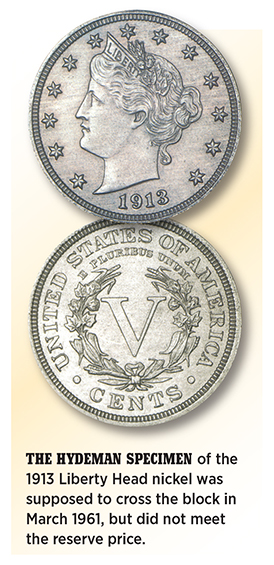
George W. Haylings published The Profit March of Your Coins, 1935 to 1968 (ANA Library Catalog No. GA55.H3py), which experienced some success as buyers hastened to see what their coins might be worth seven years hence. Much more could be said about the commercial scene of the decade, and I refer ANA members to the digital archives of The Numismatist, accessible online at money.org.
In 1961 the Smithsonian Institution’s spectacular exhibit of “Monetary History” opened under the aegis of curator Dr. Vladimir Clain-Stefanelli and his talented wife, Elvira. Arranged on many panels in a large room were coins, tokens, medals and paper money of all eras. During the decade, the Smithsonian would accomplish a great deal and become a focal point for research.
Presidential Art Medals, formed in 1961 by Max Humbert and associates, produced medals that were purchased in quantity by President John F. Kennedy to give to friends and visitors. Interest in modern medals increased by leaps and bounds, and became a vital segment of the marketplace.
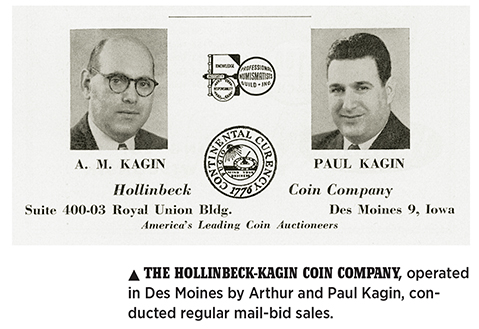
Although the American Numismatic Association witnessed a strong period of growth, it had its share of challenges and controversies. More than any other
ANA president since Augustus G. Heaton a couple of generations earlier, then-president Admiral Oscar H. Dodson was a philosopher. Excerpts from his New Year’s message for 1961 reflected his depth:
During the last few years, the American Numismatic Association has experienced a remarkable growth in membership. Are newcomers flocking to join because a gradual increase in living standards gives more time for leisure? With leisure, are men becoming more curious? As we rush through the 20th century, bewildered by problems both national and international, are we turning to a study of coins as an aid to understanding how mankind arrived where he is today? For example, do we collect and ponder Roman coinage as one facet of Roman political and economic history because the empire which rose on the banks of the Tiber suffered through vicissitudes remarkably parallel to those which today confront citizens of the United States?
I would like to believe that our new members are impelled by these intelligent and lofty motives, but unhappily evi-dence points to a different conclusion. The majority of our beginning collectors are attracted to the Association by the pros-pect of quick and lucrative pro-fit from mint errors, rolls, and eye-straining variations in current coinage…
But there is room for optimism. I would prefer to have our “transient members,” shall we call them, among us for two or three years than never to have had them at all. But more important, among our newly admitted members, some will be “bitten by the bug” and will never recover. Growing in numismatic knowledge, they will regard interest in mint errors and rolls and variations in the 1960 Philadelphia cent as the bottom rung of an adventurous and inspiring ladder.
Some of the most enjoyable experiences in life await those who climb this ladder. Acquiring a long sought coin, forming new and warm friendships, traveling scenic routes to distant conventions, through research becoming an “expert” on the coins of Alexander the Great or the 1804 American dollar, these are a few of the stimulating attainments awaiting those who ascend the ladder of numismatics…
Today, 55 years later, these words are still relevant.
Yes, ANA membership was on the rise, but there were some problems, to be sure. The Professional Numismatists Guild (PNG) was established in 1953 and held its first official meeting in 1955. During this time, the organization was a big help to the ANA. To secure hotel space for its annual conventions, the ANA had to guarantee that enough dealers would sign up to make it worthwhile. The PNG stepped in, “block booking” many tables. However, in the early 1960s many more dealers were in operation and selling bourse tables no longer was a challenge. Some ANA governors made it clear that the PNG, which conducted “PNG Day” in advance of conventions, no longer was needed or wanted. Conflict between the two groups continued for many years. Although the PNG did many beneficial things and had the best of intentions, it was, in essence, a private club that admitted dealers by invitation only. Many people knocked on the door and were turned away.

Treasure Hunting
As if the dynamic coin market were not enough, the numismatic world was turned upside-down, so to speak, in November 1962. At that time, Morgan silver dollars were popular with collectors, with most of the nearly 100 different dates and mintmarks available in Mint State for less than $50 each, many obtainable at banks for face value. These were fun to collect, and their availability in bright, as-new condition added to their appeal.
However, collectors faced some stumbling blocks, one of which was the 1903-O dollar in Mint State—the rarity of rarities, with fewer than 10 believed to exist. Indeed, A Guide Book of United States Coins (the “Red Book”) priced it at $1,500—rather theoretical, as none were traded. In fact, I had been a dealer for nearly a decade and never saw one!
Then came the news that a vault at the Philadelphia Mint contained silver dollars from the New Orleans Mint (which had not produced coins since 1909). The vault was sealed in 1929, so it did not have to be audited regularly. At holidays, public demand grew for silver dollars as gifts, and the mints obligingly paid out pieces from storage. The Philadelphia Mint’s supply ran out in the autumn of 1962, so it opened the vault. What did mint employees find? Hundreds of 1,000-coin bags of 1903-O dollars! Nothing like this had ever happened. This caused virtual pandemonium among collectors and dealers as everyone rushed to get their share. Within a short time, these erstwhile rarities were selling for less than $20 each. (The lowest price I remember was a bag of 1,000 for $4,000.)
The discovery was a double-edged sword. First, the 1903-O dollar became available at a price anyone could afford. In fact, many collectors opted to buy in quantity. Several other previously scarce New Orleans dollars were released as well, in particular the 1898-O and 1904-O. These two, previously worth several hundred dollars each, now sold by the bag for slightly more than face value.
The problem was that no one knew what the future held. In 1918, under the terms of the Pittman Act, 270,232,722 silver dollars were melted for bullion. No account was kept of dates and mintmarks. For many years, it was presumed that nearly all 1903-O dollars had been melted, but now it was learned they had been in hiding. What other coins recognized as rarities might all of a sudden become common? Dealers and collectors became cautious.
Finally, in March 1964, after banks and federal sources had been virtually emptied of silver dollars, the Treasury called a halt to their distribution. At the U.S. Treasury Building in Washington, D.C., about 3 million coins remained—all 1878-93 Carson City issues, including substantial quantities of the 1882-CC, 1883-CC and 1884-CC. These were turned over to the General Services Administration (GSA) and later sold to collectors through mail-bid auctions. Numismatists realized there would be no more surprises, and this instilled confidence in the market. They knew what was rare and what was common—and that the status of such coins would not change.
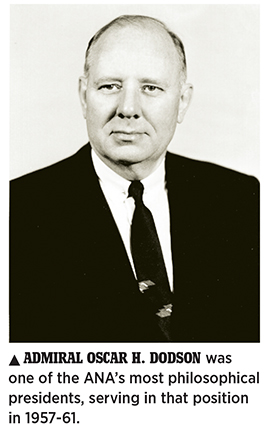
Changes & Innovations
In the meantime, other innovations affected the market. Early in the decade, Teletype machines electronically connected dealers across the country, allowing them to type and automatically send messages that were printed out on rolls of yellow paper. Such devices, often called “green monsters,” typically were enclosed in metal cases to diminish the chattering noise. At one time, the PNG had its own network, as did several other groups.
In 1963 The Coin Dealer Newsletter made its debut. Issued weekly, it listed bid and ask prices for rolls, proof coins, commemoratives, silver dollars and other popular series that appealed to investors. In time, certain earlier issues were listed as well. Coin values were now precise…just like the stock market.
Well, not quite. Bid and ask prices were a bit different than one might expect with stocks and other securities. A dealer, using a Teletype machine, might offer $100 each for certain varieties of commemorative half dollars in uncirculated grade. Upon being offered 20 of them, he might say, “I already have all I need.” Perhaps he bought only one coin or none at all. Or he might reply, “Send them to me, and I’ll see if I like them.” As a result, many coins were available for less than bid price. This was illogical, but no more so than the ads today that offer coins “below wholesale” price, a logical impossibility. The “ask” prices also were somewhat wiggly and often reflected what would be asked for a coin if one were in stock. Not to worry, as few people asked questions.
The net result was that the availability of information—good, bad and indifferent—was unprecedented, and market activity continued to increase. Neither the fax machine nor Federal Express overnight delivery had been invented yet, but long-distance phone service helped fill the gap. Several years earlier, if I wanted to buy a five-coin set of 1915-S Panama-Pacific commemorative coins, an 1851 Augustus Humbert $50 “slug” or a 1796 half dollar for a client, I would write a dozen letters, or perhaps make a few phone calls. In 1963 I could tap a request on the keyboard of my Teletype and in 10 minutes have many offers!
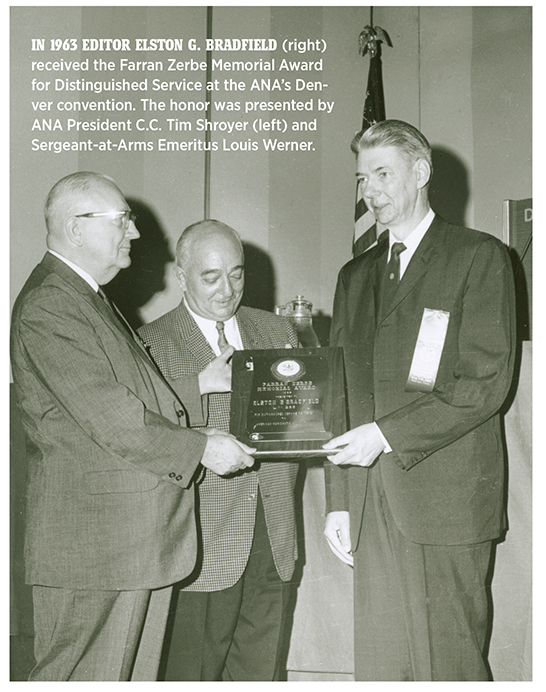
The market’s dynamism spurred the founding of many coin clubs across the country, a momentum that had begun in the 1950s. The ANA suggested that club leaders plan meetings carefully to include diverse content, and offered to loan slide programs and other educational material.
By the summer of 1961, ANA membership was 22,374, an increase of 13 percent over the previous year. The annual convention was held in Atlanta. Among the highlights was the formation of the Token and Medal Society (TAMS). Perhaps as a foil to all the excitement about investment, several other societies formed in the 1960s and early ’70s to facilitate the sharing of research and information among scholars and specialized collectors.

While the ANA’s summer convention was widely anticipated each year during the decade of the 1960s, a dozen or more regional shows were important and drew crowds. The up-and-coming Florida United Numismatists (FUN) show in Orlando saw the participation of 92 dealers in January 1962. Sometimes convention exhibits caused controversy—such as those that rotated on motorized bases, and, especially annoying to many, Art Lovi’s display illuminated with special lights and accompanied by a bank of telephones from which an observer could lift a receiver and listen to a tape-recorded monologue.
By far, monthly receipt of The Numismatist continued to be the most important member benefit. Elston G. Bradfield served as editor, having held the post since 1954. To keep interest at a high level, issues contained a mix of scholarly articles, convention news, advertisements, information about current coin issues, and more. Controversies within the ANA were downplayed or not mentioned. To learn about these, members had to read Coin World or Numismatic News. (Editors Margo Russell and Chet Krause, respectively, were finely tuned into ANA matters.)
In 1962 the annual convention was held in Detroit. Membership had gained 8 percent, or 1,190, and a remarkable 144 new coin clubs were reported for the year. Attendance at the show was 2,719. Controversies included ANA bylaw revision, dealer activities, the lack of official grading standards and especially the overproduction of medals that were being touted and sold as investments.
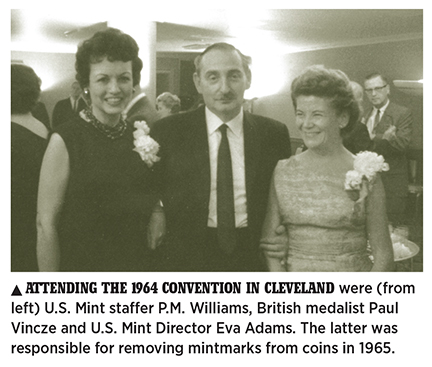
Some concluded the fraud had been engineered by Kaplan; others felt just as firmly that it was a blatant attempt by a low-life adversary to discredit Kaplan and the PNG. To this day, the mystery has never been solved! As for president Anderson, most observers felt he was an empty suit—the least involved person (and the least useful, so it seemed) to hold that office in recent memory. On the positive side, membership stood at a record 25,205.
As noted, in early 1964 the U.S. Treasury and banks ran out of silver dollars. The new Ken-nedy half dollar launched in March. Both events caused a lot of excitement and drew more collectors to the hobby. The holding of Gold Certificates and modern gold coins and bullion, illegal since 1933, was permitted again.
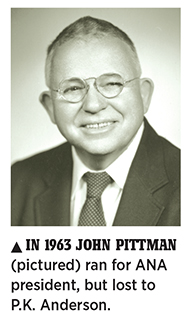
By 1964, the price of a roll of 1950-D nickels in several offerings was $1,200, even touching $1,400. Kenneth Bressett told me that some years earlier he and a non-collecting friend were discussing coins, and Ken mentioned the dynamic 1950-D nickel—not as a recommendation but as a conversation piece. His friend was intrigued and bought a couple rolls at $15 or so each. In 1964 Ken notified him of the burgeoning demand, and his friend sold out immediately at $1,200 per roll!
Then came the day of reckoning. Partway into 1964, the number of new buyers slowed and prices of investment favorites leveled off. Investors became concerned and started selling, precipitating price drops all over the board. Buyers disappeared. This ended the 1960-64 boom, and there would not be another one for quite a few years. The coin market always moved in cycles, but few people understood that. When prices rose, all dandelions were roses and all crows were swans. No one wanted to think differently.
In the meantime, the price of silver rose on international markets, causing the public to hoard circulating dimes, quarters and Franklin half dollars. Kennedy half dollars never did achieve wide use as they were hoarded from the outset. A nationwide coin shortage developed. Even “pennies” became scarce. U.S. Mint Director Eva Adams blamed numismatists and in 1965 punished them by removing mintmarks from coins and stopping the issuance of proof sets.
Uncertainty was the order of the day, and everyone suffered. Would things get better? If so, when? More about numismatic life in the ’60s next month!
The present chapter of ANA history begins with 1965, the Association having emerged from several years of market boom (soon to be on its way to bust). Difficulties ranged from ANA Board animus toward dealers to a still-unsolved mystery of thousands of fake ballots in a presidential election.
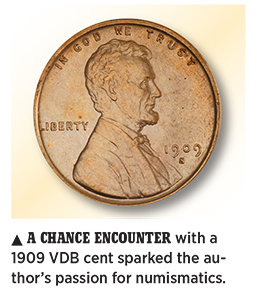
In its May 2016 issue, The Atlantic magazine had a feature article, “Why Luck Matters—Much More than You Think,” by Robert H. Frank. He discusses success and how hard work plays an important part. Often overlooked, he says, is luck— being in the right place at the right time. I discovered, quite by accident, the “world’s greatest hobby” in the summer of 1952 when, as an avid collector of fossils and minerals, I visited Robert Rusbar to see his specimens. When we were finished, he asked me if I knew about rare coins, which, at the time, I did not. He showed me a penny with the date 1909 on the front and the initials V.D.B. on the back that he paid $10 for at Gimbels department store in New York City. I was amazed and started looking through more of his pennies…and here I am today. Luck was on my side. If I had spent my life studying fossils, I would not have experienced the rich friendships and great pleasures I contemplate today. If you have been in numismatics for a number of years, you can probably say the same thing.
A New Era Begins
In 1965 matters were very un- settled in numismatics and for coinage in general. Silver specimens struck at the United States Mint had been part of the American scene since 1794. In 1965 the international price of silver was on the rise, and dimes, quarters and half dollars in pocket change were worth more than face value if melted into bullion. Virtually over-night, most disappeared from circulation. This trend continued, and many coin shops installed mechanical devices to count silver coins brought in by the public. At conventions, there was the constant ringing sound of such machines in action.
Mint Director Eva Adams placed the disappearance of coins from circulation squarely on the shoulders of numismatists, although they had little to do with it. The general public did the hoarding and justifiably so, seeing that a profit could be made. As punishment, Adams decreed that the mint would no longer make proof sets or place mintmarks on coins—so there!
In actuality, the rare-coin market was very soft. Prices crashed for “investment grade” coins, especially proof sets, bank-wrapped rolls of coins from 1934 onward. Commemoratives nose-dived, and a few, such as the hot-ticket roll of 1950-D nickels, once worth $1,400, dropped to prices lower than they are today. Ever since 1859-60, the market has experienced many well-defined cycles, a subject I explored at length. (I published my findings in the early 1960s and have kept it updated.)
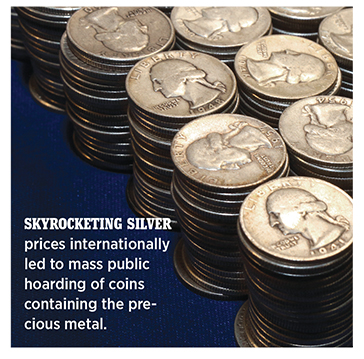
Into 1965
All was well in early 1965. Although the market had slowed, anyone reading Coin World, Numismatic News, The Numismatic Scrapbook Magazine or The Numismatist would not have known it! Then, as in practically all other times, optimism prevailed in print, even when reality differed. Soon “investment” became a bad word (but, some years later, it became a good word again)!
On the bright side, the concept of building a “Home and Headquarters” for the Association shifted into the fast lane. In earlier times, there was no central facility. The general secretary, the late Lewis M. Reagan, conducted business in his own office, negotiating printing contracts, arranging for conventions, awarding bourse tables and more. Elston G. Bradfield, the editor of The Numismatist, worked from home, as did other appointees and officers. As it had been since day one, The Numismatist continued to be the main benefit of ANA membership, as a relatively small percentage of members took advantage of other benefits, such as attending annual conventions, borrowing books from the library or viewing ANA slides. S.W. Freeman served as the publication’s advertising manager.
The Professional Numismatists Guild (PNG), viewed dimly by certain members of the ANA Board of Governors (for the dealer group had been a by-invitation-only club), took the lead in raising money for the new building. In January it was reported that $72,492 in cash, including a check for $10,000 from Whitman Publishing Company, had been received, plus $6,374 in tangible donations. The PNG scheduled its first stand-alone convention for the Palmer House in Chicago, March 5-7, 1965. As it turned out, the event received very little local support. Despite its being held in attractive surroundings, participating dealers considered it to be a lackluster event. (I was there…yawn.)
On the plus side for PNG, co-founder Abe Kosoff led the way in opening the group, which had just 65 invited members, to any dealer with a good reputation, good credentials and proven experience. In time, membership expanded greatly, and today the PNG remains open to all qualified applicants. (PNG co-founder Sol Kaplan disagreed with the change and just about dropped out of sight.) Perhaps more than any other group, it has benefited the ANA and its programs over the years.
The typical issue of The Numismatist continued to contain a half dozen or so articles on varied topics (often in areas other than federal coinage), followed by membership applications, Association news, reports of local and regional club meetings, and many pages of dealer advertisements. The January issue included this report:
According to Lester Merkin, the recent sale at Christie’s in London proved that top grade U.S. coins bring high prices no matter where they are offered. He cites the following examples of prices realized in the overseas sale: two AU 1794 silver dollars, 4,000 British pounds ($11,200) each; three Type I 1795 silver dollars, 460 pounds, 900 pounds and 700 pounds ($1,288, $2,520 and $1,960) respectively; a Sheldon-69 Mint State 1794 cent, 3,000 pounds ($8,400). Others from America attending the sale, reported Merkin, were Mrs. Ostheimer, Mrs. Paschal, James Ruddy, Ed Shapiro, and Norman Stack.
Among the many dealers active in 1965 were Stack’s in New York City (at 123 West 57th Street and still dynamic today); New Netherlands Coin Company, also in New York and well-known for its detailed auction catalog descriptions; Lester Merkin and, separately, Hans M.F. Schulman of New Netherlands Coin Company, whose auctions were popular as well; Catherine Bullowa, who traded as the “Coinhunter” in Philadelphia; Hollinbeck-Kagin in Des Moines, with regular mail-bid sales; and Abner Kreisberg and Jerry Cohen on North Beverly Drive in Beverly Hills. Also active were Abe Kosoff, of Encino, California, who regularly conducted auctions; the Joseph Flynn Sr. Coin Company of Kansas City, Kansas (which actually was run by Joe junior); Mayflower Coin Auctions in Boston; the recently formed Para- mount International Coin Company in Ohio; Harry J. Forman in Philadelphia; and many more (not to overlook the General Numismatics Corporation formed by Joseph Segel, that in time would change its name to The Franklin Mint). A full roster of leading dealers would include several hundred names, plus several thousand who operated shops in various towns and cities or did business by mail. A detailed discussion of the professional side of numismatics would require a book of its own. (I refer you to advertisements and news in back issues of The Numismatist, which you can visit online at money.org.)
A Guide Book of United States Coins, the familiar “Red Book,” continued to be the basic source of coin information and prices, as it had been since the first edition in 1946. The Coin Dealer Newsletter, launched in 1963, gave current prices for silver dollars, type coins, rolls, proof sets and other popularly traded items. Teletype systems linked multiple dealers, many of whom issued and mailed printed catalogs and price lists—quite different from the Internet-based coin listings of today.
From Home to Headquarters
After raising the necessary capital, the ANA faced its next challenge—determining the location of its new headquarters. Board member Charles M. Johnson, one of the most talented people ever to serve the ANA, was chairman of the Association’s Headquarters Committee and had done his homework. The ANA received a variety of proposals, some offering free space, others free land on which to build. Inducements had been received from Abilene, Kansas; Amarillo, Texas; Canton, Ohio; Colorado Springs, Colorado; Dubuque, Iowa; Evansville, Indiana; Kansas City, Missouri; Linton, Indiana; Oklahoma City, Oklahoma; Omaha, Nebraska; Prairie du Chien, Wisconsin; Salina, Kansas; Stafford, Virginia; Texarkana, Arkansas; Wichita, Kansas; and Yuma, Arizona. Omaha offered not only free space but also custodianship of the remarkable Byron Reed Collection, which the city had received generations earlier. The collection included an 1804 silver dollar, which was then valued at $1.5 million. Omaha was the favorite of the nine-member ANA Board. (Oops! As you, a reader in 2016, knows, Colorado Springs was the winner by upset—a decision supported ever since.)
The rest of the 1960s saw a very muted market; the investment sector essentially was dead. Early coins by die varieties continued to be in strong demand, as were tokens, medals, ancient coins, foreign issues and paper money. New strength was registered in many of these specialties. Circulating silver coins were replaced by clad issues. The era of filling in Whitman folders and other holders with treasures from pocket change was over.

In other news, Matt H. Rothert, a highly accomplished businessman (furniture manufacturing) and long-time numismatist, was elected president, one of the best ever to serve in that office. (Some years earlier, it was Rothert who influenced Congress to add IN GOD WE TRUST to paper money.) The ANA adopted a Code of Ethics, which was rarely enforced. The annual convention was held in Houston, Texas, in August 1965. “Considering the recent inactive numismatic market, Houston convention auctioneer Al Overton felt that the results were good,” The Numismatist reported. ANA Executive Secretary Don Sherer, who declined to move from Phoenix to Colorado Springs, resigned.
In 1966 dealers remained controversial, as did criticisms of the ANA leveled by Coin World, Numismatic News, the PNG and others. There was a shortage of bourse space for dealers at the annual convention in Chicago—only 100 spaces were available for 250 applicants! The bourse committee’s suggestion to bar Chicago-area dealers was met with resistance, as were some other proposals.

Changes & Transitions
In 1966 Glenn Smedley became the new editor of The Numismatist. Jack R. Koch, who had been assisting Don Sherer in the management of the ANA following the death of Lewis M. Reagan, was named to the new position of executive director. He was set to supervise all headquarters activities, and he was envisioned as the right person for the job. Meanwhile, certain operations were set up in rented space in the city. Virgil Hancock, who would later become ANA president, gained notice for presentations he gave. Starting with good intentions, Hancock was a bit sloppy on research, and in the next few years he stirred up a lot of resentment by calling some genuine coins fake. By decade’s end, he was one of the most controversial people in the hobby.
Don Taxay, a disciple of Walter Breen and John J. Ford Jr., gained deserved praise when his book The U.S. Mint and Coinage: An Illustrated History from 1776 to the Present (ANA Library Catalog No. GA80.T3) was released. It was the most comprehensive study of the Philadelphia Mint ever published. Today, it is still essential to any advanced library.
A hue and cry arose about the ever-increasing number of “coins” put out by different countries that were legal tender to be sure, but were made for sale to collectors, not for circulation. Chester Krause and Clifford Mishler of Krause Publications devised the term “non-circulating legal tender” (NCLT). The furor continued for a year or so then faded, as so many new varieties were being issued and purchased. Today the controversy is forgotten, and most world mints make legal-tender coins that never circulate in commerce. Poster examples are the silver and gold American Eagles made since 1986 by the U.S. Mint. Face values (or legal-tender values) are a meaningless $1 and $50. The annual worldwide output of NCLT coins guarantees an impressive display of varied and often-improbable designs.
In 1966 Midas Coin Centers of America advertised for franchisees to open coin stores across the country—just like McDonald’s® or Kentucky Fried Chicken™. Those who operated such centers had exclusive rights to sell “Coinew,” improved and then the “hardest-working, fastest-acting cleaner on the market.” I think at least one such store opened, but no chain of stores ever materialized.

Welcome to the Springs!
In the March 1967 issue of The Numismatist, Harry W. Bass Jr. noted that he had been enjoying coins since his first purchases at an auction in May 1966. Harry went on to become one of the most accomplished students of Early American gold coinage; to build one of the finest collections ever (the core of which is now on display at ANA headquarters); and to become the president of the American Numismatic Society in New York City.
Harry was a benefactor to many and was always a fine friend. In the 1980s, he became a pioneer in the use of home computers. One day, he called to say that unless I got such a device, I would never hear from him again, as he was no longer going to write letters! I quickly bought a Macintosh® Plus. Harry did write letters later, but the computer commanded most of his attention. He even set up a system for the American Numismatic Society.
Another article noted that Eric P. Newman, who had been collecting since the age of 10 in 1921, had authored The Early Paper Money of America (US40.N4e), released by Whitman Publishing Company. Although Eric’s contributions in print were occasional rather than regular, each was carefully researched. Today, anyone seeking to update or edit his books and articles would find very little to change. In contrast, Walter Breen was prolific, gave many public talks and programs, provided authentications and endorsements for a fee, and was generally regarded as the leading expert on American coinage. Years later, however, it was found that many of his facts were fiction. Although guesses made up only a small part of his writing, any of his work used today needs to be taken with a large grain of salt.
In the meantime, an updated edition of A Guide Book of United States Coins was released each July and was the standard source for easy-to-find pricing information. In 1967 investment-coin values were down sharply, while most early coins, including gold from 1795 to 1834, showed increases.
Al C. Overton announced the impending publication of his only book, Early Half Dollar Die Varieties, 1794-1836 (GB23.O8). The investment end of the coin market remained in the doldrums. William C. Henderson, president of the Pikes Peak National Bank in Colorado Springs, was appointed ANA treasurer. The new ANA headquarters was dedicated in a three-day ceremony starting June 10, with 600 attendees at one point. I have nice memories of it.
In the ANA election of 1967, an uncontested Arthur Sipe became president. Executive Director Jack Koch was fired for stealing coins, news that surprised and dismayed almost everyone. Membership fell to 22,863, a loss of more than 1,000 members during the year. There were high points, however. At the convention auction in Bal Harbor, Florida, a 1913 Liberty Head nickel sold for a record $46,000, amid cheers and applause. The buyers were Aubrey and Adeline Bebee, who years later donated the coin and their paper money collection to the ANA—highlights today of the Edward C. Rochette Money Museum.
Around this time, the ANA began to set up the American Numismatic Authentication Trust and solicited $50,000 in donations to make it possible. Altered mintmarks and counterfeits were a huge problem. There was no reliable way for the average collector to evaluate coins, and many dealers lacked the technical expertise to tell the good from the bad. At the time, PNG dealers guaranteed the authenticity of the coins they sold and, on request, would provide certificates attesting to this.
Events of 1968
In 1968 proof sets were again made, for the first time since 1964, in San Francisco instead of Philadelphia, and mintmarks were restored to coins. A curious side note was that Eva Adams, the former mint director who blamed numismatists for the 1965 coin shortage, had a change of heart, became friends with hobby people (Coin World Editor Margo Russell, in particular) and later even landed a seat on the ANA Board of Governors.
The collection of more than 5,000 gold coins in the estate of pharmaceutical executive Josiah K. Lilly, formed exclusively by Stack’s over many years, was the subject of a bill in Congress that eventually led to its donation to the Smithsonian Institution. Lilly’s collection contained many incredible rarities.
The 1968 market could be described in one word: hopeful. Most investors had disappeared; collectors remained enthusiastic; and the market was stabilizing, with popular investment items priced at lower levels, some attractively so. History would show that bank-wrapped rolls, commemoratives, proof sets and other series, if bought at the depressed prices of this year, would, for the most part, multiply in value in years to come! Ruthann Brettell, a local lady, joined the ANA staff to assist with bookkeeping and finance. Adna G. Wilde Jr., a retired army colonel who lived in Colorado Springs, was named executive director, while Geneva Karlson was appointed librarian.
In 1968 the annual convention was held in San Diego. Registration topped 6,150, and more than 2,000 paid for and received admission badges. ANA membership experienced a slight uptick during the year. Elections were now biennial, so the roster of officers from the year before remained in place.
Steady Growth
The mood of most people was upbeat in 1969. ANA headquarters had established good practices under Wilde’s leadership, and investors began returning to the market, but were more selective in their purchases than before. Worries faded, and stability returned to most areas of numismatics.
The Franklin Mint made headlines promoting medals by emphasizing their great potential for price appreciation. Its stock was a darling on the exchange. CEO Joseph M. Segel made generous donations to both the ANA and the Token and Medal Society.
Herbert M. Bergen, a longtime collector and an oil-business professional from Fullerton, California, was unopposed in the election for ANA president. The 1969 convention was held in Philadelphia, coinciding with the dedication of the fourth Philadelphia Mint. It was reported that 7,772 attended. (Some years later, it was revealed that annual convention figures were partly guesswork and that official sign-in registrations at shows were much lower.) Membership showed a slight rise from 23,472 to 23,726.
In 1970 the ANA and the market were both healthy. Interest in books and out-of-print catalogs was growing sharply. Aaron Feldman, previously a dealer in coins, converted his activities to the field of numismatic literature, prefacing advertisements with the title “Buy the Book Before the Coin,” a slogan for which he subsequently became well-known in the hobby. James F. Ruddy published Photograde: Official Photographic Grading Guide for United States Coins (GA50.R8), which enabled readers to quickly classify and grade coins. It was an instant success and sold countless thousands of copies. In the August 1970 issue of The Numismatist, dealer Walt Laub offered rolls of 1950-D nickels for $350.
The 1970 annual convention was held in St. Louis. It was not an election year. Membership showed a nice jump of nearly 1,000 names to 24,780. Mary Brooks, who succeeded Eva Adams as mint director, was deeply interested in numismatics and soon became a familiar face at coin conventions. In the meantime, she and the mint were busy with the design of the impending Eisenhower dollar.
In retrospect, the years from 1961 to 1970 were the most uncertain in the Association’s history, with more changes and controversies than in any comparable era. The decade ended on a positive note, however, and just about everyone looked forward to the future of numismatics with enthusiasm.
This month’s chapter of ANA history begins with 1971. The preceding decade was marked by dramatic changes in the marketplace, plus a lot of problems within the ANA. The market soared when thousands of investors discovered coins in 1960 and prices kept going up for “investment quality” pieces, mainly gold and silver in mint state and proof. (Hardly anyone wanted a 1652 Pine Tree shilling or a 1785 Vermont copper.) The walls came tumbling down in 1964 when new buyers failed to materialize and investors wanted to capture their profits.

There were challenges galore. Dealers, especially members of the Professional Numismatists Guild (PNG) who set up a day before the ANA summer convention, were despised by dealers who were not members. Additionally, ANA Executive Director Jack Koch was caught stealing coins and was fired. (As I was an active part of the numismatic community as a dealer and writer, my comments in this recent series of columns are mostly from first-hand experience.)
The ANA in 1971
In 1971 things had to get better…and they did. In Colorado Springs, most of the growing pains had eased, employees were settled in their positions, and the ANA looked forward to growth. In that year, as is true today, The Numismatist was the main—make that the only—benefit for the majority of members. Fewer than half went to conventions, borrowed books from the library, or were otherwise involved. Accordingly, it was a challenge for Editor Ed Rochette to balance a mix of mint information, market news, auction reports, club meetings, research, feature articles and advertising. The printer, selected during competitive bidding, was doing a poor job. Many illustrations were fuzzy and other production problems arose. This was solved by taking the business to a better firm.
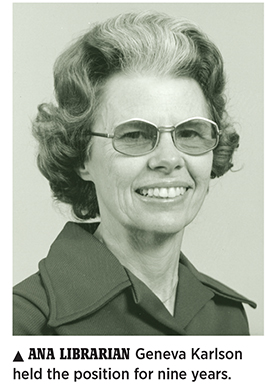
Maurice M. Gould was in charge of the by-mail correspondence course for junior members that featured information laid out by Kenneth Bressett, Lee Martin, Paul Whitnah, Ralph Mitchell, Russ Rulau, Jim Johnson, Leon Lindheim, Abe Kosoff, George Waite, Maurice Gould, Eric Newman, Byron Johnson, James Ruddy and myself. The idea was a good one, as were other ANA correspondence courses, but they never gained much traction.
Counterfeits and alterations were endemic to numismatics, and John J. Ford Jr. estimated that more than half of the 1916-D dimes he had seen were fakes. To combat this, the American Numismatic Association Authentication Trust was set up at ANA headquarters. Its name was later changed to the American Numismatic Association Certification Service (ANACS). Thanks in part to significant private donations by PNG members, funding goals were reached, and plans were laid for its operation.
Dealer Community
Advertisers in the January 1971 issue of The Numismatist included most of the active professionals of the time. New York City was the epicenter of the rare coin business. It took at least two days to make the rounds of the various dealers and examine their inventories. Stack’s had been in business since 1933 and at the same location since 1953. They captured the lion’s share of “name” collections. New Netherlands Coin Company, which had been operating since 1936, emphasized the scholarship of its catalogs—often taking an entire paragraph to say what others could explain in a couple of sentences. Harmer Rooke Numismatists, Ltd., featured a toll-free number and noted, “It only takes seconds to talk personally to the people who know, the people who care.” Herbert Tobias offered rare coins for sale, including a gem uncirculated 1909-S VDB cent for $250. Lester Merkin took out a double-page advertisement to tell of his forthcoming auction of rare coins and currency cataloged mostly by Walter Breen, America’s best-known commercial research authority. Hans M.F. Schulman on Fifth Avenue ran an international business and Max L. Kaplan had a nice company. Louis S. “Money Back” Werner was in the city as well, but getting a refund for a counterfeit coin could be difficult—as I, A.J. Ostheimer and some other buyers found out (excuse the digression).

Dealers in other locations included Ohio-based Paramount International Coin Company, one of the biggest players of the era, with auctions, direct sales and a program of selling proof sets made by various foreign mints. Also important in the auction scene was the Rare Coin Company of America (RARCOA), which handled many fine properties. Al C. Overton announced the revised edition of his book, Early Half Dollar Die Varieties, 1794-1836 (ANA Library Catalog No. GB23.O8), which played to a very dynamic group of specialists. Richard Picker handled many fine colonial and Early American coins, while Robert L. Steinberg specialized in gold and silver coins.
Other advertisers included The Sheldon Coin Shop, operated by Sheldon L. Moses; Richard M. Muniz; the Coen-Messer Company; Dan Brown’s Coin Shop; Morey Perlmutter; Cadillac Coins; J.A. Scott & Company, Inc.; William P. Donlon (the most important name in paper money at the time); and Mayflower Coin Auctions, which was prominent in Boston. In Dallas, Mike G. Brownlee and John N. Rowe were the major dealers, were well liked and were familiar figures at coin shows.
The Whitman Hobby Products division of Western Publishing promoted its books and accessories. Harry J. Forman in Philadelphia, who had connections to the vault keeper(s) at the Philadelphia Mint, was probably the largest dealer in quantities of rolls and bags of uncirculated coins, and was a popular figure. Other advertisers included Ossie’s Coin Shop and Harold Sly, who offered coin holders.
Bebee’s in Omaha maintained a large inventory of popular coins and currency. Anco, of Florence, Alabama, offered coin tubes for storing rolls and evolved into a major player, including ownership of Whitman Publishing some 30 years later.
Medals were a hot ticket, with the Franklin Mint being by far the largest dealer. Presidential Art Medals also had a good share of the market.

Ongoing Events
Eisenhower dollars were launched in 1971 and soon became popular with collectors. Never mind that the public ignored them. It was not for the lack of trying, as the U.S. Mint and the Treasury Department did their best to make a dollar coin to replace the paper version. Chief Engraver Frank Gasparro, designer of the Eisenhower specimen, enjoyed numismatics and was a familiar figure at numismatic events held in and around Philadelphia. Mint Director Mary Brooks, one of the finest people ever to occupy that post, appreciated the hobby as well, attended most ANA conventions and was always ready to answer questions.
By July 1971, the ANA Summer Seminar was in its third year. Under the direction of Edward C. Rochette, the event gained in stature and attendance. Special emphasis was placed on the detection of counterfeit and altered coins, an especially timely topic given the recent formation of the ANACS. Forty-seven students attended.
The annual ANA convention was held in Washington, D.C., August 10-14. It was stated that more than 10,570 attended (but it was later revealed that for many years such figures were guesses and not based on individual registrations). Some thieves breached the security room at the show and made off with dealer Richard Picker’s large inventory. This resulted in lawsuits, as the hired security firm took no responsibility for the loss. The matter went to court, and in 1977 Picker was awarded a judgment in the amount of $107,734 against the ANA. By this point, the security firm had gone out of business. Fortunately, no other theft of this magnitude took place before or since.

On September 1, the ANA Museum opened under the curatorship of Richard Long. As 1971 drew to a close, members could reflect upon a good year. There were more than 25,000 members on the roster, most of whom lived in the United States. There were many advances and relatively few controversies. The market was on an upswing and gaining strength, which made almost everyone happy.
Onward & Upward
The numismatic community continued to grow. Plastic holders, such as those made by Capital Plastics, were the standard for showcasing valuable single coins and sets. Cardboard albums by Whitman, Meghrig and others were popular as well. Gone were the days when the typical collector kept a pile of Whitman albums for Lincoln cents, Buffalo nickels and up through half dollars. No longer was there any hope of finding a “treasure in your pocket,” such as a 1909-S VDB cent, 1913-S Type II Indian Head nickel, 1916-D Winged Head Liberty (“Mercury”) dime, or 1932-D Washington quarter.

In 1972 Abe Kosoff advertised, “We are pleased to offer for sale the Hydeman 1913 Liberty Head nickel and the Idler 1804 silver dollar each priced at $100,000.” They were bought at a negotiated lower price by World-Wide Coin Investments, Inc. of Atlanta, the fastest- rising new star among coin dealers. In time, they were the first to install a computer. (Made by Burroughs, it occupied a room of its own.)
In the meantime, Jim’s Stamp & Coin Shop, operated by Jim Halperin, Russ Vaughn, Chris Tracey, John Reed and Gary Walls and located in Cochituate Center, Massachusetts, advertised itself as “One of New England’s most active coin shops.” Halperin went on to great success, including with the New England Rare Coin Galleries and, years later, Heritage. In California, Western Numismatics, a subsidiary of A-Mark Coin Company, had Robert Hughes as its main trader and conducted a lot of wholesale business.
Stack’s announced that during one 13-month period it sold an incredible $2.4 million in coins. Hollinbeck-Kagin, based in Des Moines, announced that Donald H. Kagin, a graduate of Northwestern University with a doctorate degree in numismatics, had joined the firm. John J. Ford Jr., one of America’s leading authorities on counterfeits, was no longer with New Netherlands Coin Company but was spending time on research and coin brokerage.
Helpful References
Among new books of the time was the Guide to Morgan and Peace Dollars, a Comprehensive Guide and Reference Book on U.S. Silver Dollars by Leroy C. Van Allen and A. George Mallis (GB22.V35c). Utilizing “VAM” numbers to identify varieties, it became a game-changer and inspired hundreds of readers to become specialists. Market prices were available from listings in Coin World and Numismatic News, and the annual Guide Book of United States Coins (the “Red Book”) was released each July. The Coin Dealer Newsletter gave “bid” and “ask” values for many series.

A new hazard erupted—“whizzed” coins. These were high-grade, circulated specimens that had been wire-brushed to give them fake, bright mint luster. The effort to combat them was difficult and challenging, and millions of dollars of whizzed coins continued to be sold to unsuspecting buyers. Virgil Hancock’s “Featuring Fakes” column in The Numismatist was admired as a step in the right direction. Meanwhile, ANACS was in the process of being set up in Washington, D.C. (so as to be near the Smithsonian Institution as a reference base for coins and the Secret Service). Charles Hoskins was appointed director.
Edward C. Rochette, editor of The Numismatist, was named executive vice president of the ANA following Adna G. Wilde Jr.’s retirement. (The latter did not leave the Association for good, and went on to be a board member and then president.) Thom Marshall became the new editor.
As of June 30, membership stood at 27,964. On August 15-19, the annual convention was held in New Orleans. Attendance was reported at about 6,500. Among the program speakers were Jimmy Hayes and Eric Newman. Increased emphasis was placed on young numismatists (age 11 to 20).
The market was energized by the discovery of the 1972 doubled- die Lincoln cent, of which thousands were found, and a sharp increase in the price of gold. Mint errors and die oddities became increasingly popular. ANACS went into operation with some impressive equipment, including a scanning electron microscope (the use of which cost $20 per coin above the regular fee). Submissions were brisk. The most-often submitted specimens were 1916-D dimes, 1893-S dollars and 1909-S VDB cents. Four 1894-S dimes were submitted; all fake.
The 1973 convention took place at the Sheraton-Boston Hotel from August 23 to 27, with Arthur M. Fitts III as chairman. Attendance was reported as 13,926, and a record 816 went to the banquet. A total of 177 bourse tables were sold. The Numismatic Literary Guild “Bash,” an annual event, saw the usual hilarity, jokes and antics—the ANA equivalent of a “roast” of leading figures in the hobby. Specialized societies were on the rise. Convention meetings were held by the Token and Medal Society, The Elongated Collectors, the International Bank Note Society, the Society Historia Numorum, the Love Token Society, the Old-Time Assay Commissioners Society, the Early American Coppers and Numismatics International. The Rittenhouse Society of numismatic researchers held its annual breakfast, as it had been doing since 1960.

One annual “sport” for the Board of Governors was changing the Association bylaws. In the past year, 10 revisions were made. Richard Long resigned as museum director and Thom Marshall as editor. Ed Rochette took up the editorship until a replacement could be found. National Coin Week continued as a yearly ANA-sponsored event.
Continuing Progress
In early 1975, N. Neil Harris, an accomplished writer, sculptor and medalist, was appointed editor—a position he would hold into the next decade. Arthur M. Fitts was named assistant to Executive Vice President Ed Rochette, and moved from Massachusetts to Colorado Springs with his wife, Nancy, and sons William, Stephen and Scotty. David L. Ganz, an up-and-coming attorney, was a prolific writer, especially about numismatic legislation in Congress.
Florence M. Schook was appointed head of the young numismatists program. She mothered them with great success, and in ensuing years the number of YNs, as they were called, increased.
Because of the rising cost of copper, the mint struck a large quantity of cents in 96-percent aluminum alloy. Mint Director Mary Brooks gave out samples to a number of government officials and others. Then the Treasury Department announced that ownership of such coins was illegal. Brooks tried her best to retrieve the gifts, but could not get them all. She was sufficiently harassed and later took time off to compose herself, an unfortunate scenario. In 1974 she spent much time planning for special issues of 1976 Bicentennial coins.
The annual convention was held in Bal Harbour (Miami Beach) from August 13 to 18, with Robert L. Hendershott as chairman. (As a child, he attended the St. Louis World’s Fair in 1904 and later wrote a book about its numismatic souvenirs). It was reported at the show that as of May 31, the ANA had 28,021 members. By the end of the event, the total was more than 30,000.
Glorious Gold
The year 1974 ended on an optimistic note. The holding of gold bullion and modern gold coins, forbidden since 1933, became legal one second after midnight, December 31. Doubtless, that brought many people to the hobby. Additionally, specialized societies were growing, and ANACS had to hire more staff.

Association News
Whizzed coins continued to be the number-one problem in the hobby. Virgil Hancock became increasingly controversial with his “Featuring Fakes” column—in essence calling anyone an idiot who did not agree with his findings. The problem was that he was sometimes dead wrong. Never mind. His column remained popular.
On January 18, 1975, the new museum at ANA headquarters was formally dedicated. Mint Director Mary Brooks was in attendance. Afterward, on May 14, Culver held the first Numismatic Round Table. Hobby leaders were invited and gave presentations regarding “Problems-Projects-Priorities.”The ANA officers and governors learned so much that Culver decided to schedule another a few months later.
Among plans in the works was the establishment of an ANA coin-grading board to be part of ANACS. In other news, Krause Publications announced the construction of a 20,000-square-foot headquarters on a 16-acre site in Iola, Wisconsin.
The 1975 annual convention was held in Los Angeles in August at the new Marriott Hotel near the airport. Nearly 12,000 attendees were reported. Although no one dared to mention it in print, the rare-coin market was softening.
Virgil Hancock, as controversial as ever, was elected president, edging out George Hatie. Grover C. Criswell now occupied the vice president’s chair, while Board of Governors members included Maurice M. Gould, Kenneth Hallenbeck, Byron F. Johnson, John Jay Pittman, S. Morton Reed, Glenn Smedley and Adna G. Wilde Jr. Membership stood at 30,585.
Hancock immediately announced plans to revise the ANA election rules. Governors’ seats were to be numbered 1 through 7, and candidates would run for a specific seat. The unspoken motive was that Hancock and some others thought that Pittman, who was still on the board after his presidency, and Grover C. Criswell had served too many terms. This was a way to oust each of them, as candidates could target either. This and other changes were approved.
In reality, hardly anyone wanted to run against proven winners! Term limits were put into place, a practice which lingers today. Although numbered seats are gone, a governor cannot be reelected if he or she has served 10 years.
New policies for the awarding of bourse tables were enacted. Dealers were given “stars” depending on past activity. This was controversial as well. Hancock made it clear that he could make better decisions than the Board of Governors or any committee. It was his way or else risk being condemned. Wilde Jr., one of the finest directors and governors the ANA ever had, was roundly excoriated—Hancock’s first victim. The next two years saw much turmoil as a result.
On the plus side, George F. Kolbe held his first sale of numismatic literature; Paramount International Coin Corporation published David Akers’ book on auction listings of gold dollars; and Coin World issued its first “almanac.”
The U.S. Bicentennial was observed in 1976. New designs were created for the reverses of the quarter, half dollar and dollar. Notes of the $2 denomination were issued with a new back design. The U.S. Mint, which had loaned its coin collection to the Smithsonian Institution in 1923, now wanted it back to exhibit at the Philadelphia Mint during the Bicentennial. Curators Dr. Vladimir Clain-Stefanelli and his wife, Elvira, did not know what to do, as the Mint Collection was key to many Smithsonian exhibits. Harvey Stack stepped in and arranged for the mint to exhibit the Louis E. Eliasberg Collection instead. The arrangement exceeded all expectations; more than a million people visited, and the exhibit was extended for a half year into 1977.
The 8th Summer Seminar in Colorado Springs drew 116 participants. The annual convention was held from August 24 to 29 at the new Marriott Hotel on Times Square in New York City. More than 21,000 attendees were reported, and dealers occupied 200 bourse tables. A slight decline in membership was reported. Stack’s created a 448-page auction catalog comprising 4,178 lots. Meetings conducted by president Virgil Hancock were boisterous and heated as he continued to insist on being right on all matters.
In autumn of 1976, ANACS moved from Washington, D.C., to Colorado Springs. John Hunter was the only employee who relocated. Ed Fleishmann, earlier with Coin World, joined the ANA staff at headquarters in October.
By early 1976, The Numismatist had gone through several transitions, including a new style and printing company. Edited by N. Neil Harris with the assistance of Patricia Black, and printed by R.R. Donnelley & Sons, the magazine was better than ever.
In 1977 the market continued to be soft. The Official ANA Grading Standards for United States Coins (GA50.A5) was published to great acclaim. The Sheldon scale of 1 to 70 formed its basis.
Virgil Hancock continued to run a one-man show, usually at odds with the “stupid” Board of Governors. He was popular with most ANA members, many of whom felt that, at long last, improvements were being made. Rochette, whose title at the time was executive vice president (later changed to executive director), was the glue that held everything together at headquarters.
In a bidding contest with Bowers and Ruddy Galleries, A-Mark Coin Company purchased the Laverne Redfield estate consisting of bags of silver dollars, for $7.3 million. The Coin Dealer Newsletter introduced its “Monthly Summary” issue. Mary Brooks resigned as mint director and was replaced by Stella Hackel Sims.
The ANA convention was held in Atlanta during the last week of August. Election results were announced and, having run unopposed, Grover Criswell became president. At the convention banquet, he took issue with the past actions of the mint, particularly under Director Eva Adams, who was present at the event. This seeming breach of etiquette—never mind that the remarks were accurate—caused a great stir. The Board of Governors subsequently printed an apology in The Numismatist.
It was a year of lawsuits, including Richard Picker’s loss by theft at the 1971 ANA convention and other legal action by dealers who alleged that bourse assignments at the 1977 convention were unfair. Thus started an unfortunate trend of litigation on various subjects, costing the ANA millions of dollars.
The year ended on an optimistic note. Infighting had diminished, and the market was turning up. The outlook for 1978 was bright.
I continue my history and overview of the American Numismatic Association, its people and activities, and the events pertaining to coins, tokens, medals and paper money with a look at the years 1978 to 1985. The ANA experienced growing pains in the early to mid-1970s, eventually settling into smooth operations from its headquarters in Colorado Springs. The coin market was volatile, but ended the period on a positive note as well.
The ANA in 1978
The coin market was somewhat weak at the time, reflecting one of its many cycles. The Official ANA Grading Standards for U.S. Coins (ANA Library Catalog No. GA50.A5) was published to great acclaim, setting the scene for emphasis on numerical classifications. These were thought by many to be scientifically precise, but that did not prove to be the case, as the same coins were graded differently by people using the same book.
Grover C. Criswell, well known as the leading dealer and expert in Confederate paper money, was elected president of the ANA in 1976, without opposition. By early 1978, the Association was embroiled in two costly lawsuits—situations relatively new to the organization. It was an era of litigation, and, continuing forward to the present day, lawsuits have cost the ANA millions in legal fees.
The Numismatist, edited by N. Neil Harris, continued to be the sole benefit of ANA membership for the majority of readers, as only a fraction attended conventions or the Summer Seminars. At headquarters in Colorado Springs, the American Numismatic Association Certification Service (ANACS), managed by John Hunter and Ed Fleischmann, reviewed coins for a fee and issued certificates for those they found to be authentic.
In 1978 the General Services Administration was in the process of selling large quantities of mint-state Morgan silver dollars struck at the Carson City Mint, most of which had been stored in vaults in the Treasury building in Washington, D.C. The U.S. Assay Commission, which had met yearly since the 1790s to review samples of silver and gold coins, was abolished by President Jimmy Carter as a cost-cutting measure. No recent coins had contained precious metals, except for certain silver strikes made for collectors.
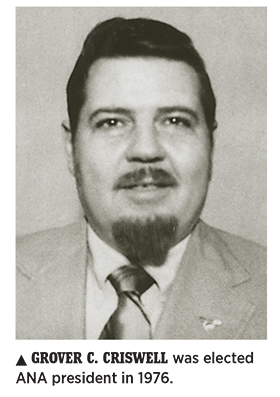
Memorable Conventions
The first ANA midyear convention was going to be held in Colorado Springs at The Broadmoor resort, February 15-19, 1978. The Broadmoor’s International Center could not be booked, so the show was held in The Broadmoor World Arena, home of the U.S. Figure Skating Championships. Advance publicity stated that it did not often snow in the city, and, when it did, it usually melted within 24 hours.
However, reality intervened. Snow from a recent storm of unpredicted intensity covered the ground and it was very cold outside. The arena had no insulation, so the 134 dealers who set up in the bourse were shivering. Most tried to make the best of it. Public attendance was low, but as the market was picking up; dealer-to-dealer transactions were good. Commemorative t-shirts were later made available to those who “survived the first coin show on ice.”
Revising the ANA bylaws was becoming a joke. It seemed that every year the Board spent a lot of time making and then sometimes nullifying the rules. One of the perceived problems was that certain members were so popular that they were regularly reelected. The solution was to establish numbered seats and term limits. The latest bylaws included the following, to be enacted the next year:
1979 election—Candidates for the seven governorships shall be nominated in accordance with Article VI, Section 1 of the bylaws, as in the past except that, in accepting such nomination, each candidate must declare irrevocably which of the seven numbered seats he will stand for. Governors elected to seats No. 1, 2, 3, and 4 shall serve for terms of four years. Governors elected to seats No. 5, 6, and 7 shall serve for terms of two years.
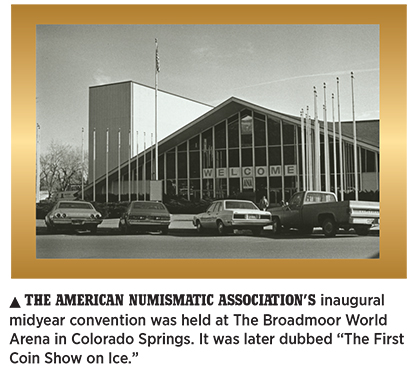
Anti-dealer sentiment was another issue. It was said that dealers should not be permitted to serve on the Board; if they were, they should not be allowed to have bourse tables at conventions. In one memorable comment years earlier, a governor called dealers a “necessary evil” at conventions. The conundrum was this: prohibit dealers, and convention attendance would drop precipitately.
Another complaint was that there were far too many dealer advertisements in The Numismatist. In response, Editor Harris sent out a questionnaire. The surprising result was that 77 percent of respondents said that these notices were their favorite feature.
For more details about these and countless other controversies of the era, consult back issues of The Numismatist, now available online. There, you will find additional information about dealer activities, memorable auctions (with Stack’s, Bowers and Ruddy Galleries, Rare Coin Company of America [RARCOA], Paramount International Coin Corporation, Abner Kreisberg and Jerry Cohen, Hans M.F. Schulman, Lester Merkin, and Superior Galleries at the forefront in the 1970s), and other events apart from mainstream Association activities.
The ANA Museum’s holdings were increasing by leaps and bounds. In the summer, it received the Robert Herdegen estate collection as a gift, the finest ever assembled of United States and Canadian fractional currency, adding to an earlier donation of rare coins.

The presidential administration of Grover Criswell was upbeat, a change from the turmoil that characterized Virgil Hancock’s. Mint Director Stella Hackel, a frequent presence at numismatic events, was a positive influence as well. Membership was reported as 29,369 individuals and 806 clubs, nearly a record for the era. The young numismatists program under Florence M. Schook was rapidly expanding and headed toward the 1,000 mark.
ANACS had brought in tens of thousands of dollars in profit. The headquarters staff was growing, and a two-story expansion of the building was being considered.
There was one important business that was in deep trouble. The Franklin Mint, a company publicly traded on the New York Stock Exchange, had built its business on selling medals and certain foreign proof sets with legal-tender but noncirculating issues. It had hundreds of thousands of customers, many of whom bought these “limited edition” items hoping for future profits. At the Houston convention, Morley Safer and the crew from the CBS television show 60 Minutes arrived unexpectedly to film what would become part of a devastating segment they would later run, featuring owners of medals being told their holdings had little resale value, and showing some medals being dumped into a bucket to be melted. This marked the end of The Franklin Mint’s expansion, as medal sales declined dramatically. Later, the company offered other collectibles, and it became numismatically unimportant.
Continuing Progress
Meanwhile, paper dollars continued to dominate circulation. Eisenhower dollars had been issued since 1971 in the hope that they would replace paper bills. This did not happen—the public largely ignored them, although they were popular with numismatists. The last pieces were struck in 1978. The problem was that the “Ike” dollars, as they were called, were too large and cumbersome for circulation. The answer was apparent to Treasury officials: offer a small-size dollar. The Susan B. Anthony coin was introduced in 1979, but fizzled out in 1981, as the public still preferred notes.

The coin market remained strong. Stack’s told of Harold S. Bareford, who in his lifetime spent $13,832 by carefully buying rare examples. When his estate sold, the coins went for $1,207,215. While this was an exceptional success story, just about every other ANA member who slowly and carefully assembled a collection and held it for 10 or more years realized a great profit. Thousands of investors who did not have the time or inclination to carefully study specimens assumed that by purchasing coins, such profits would materialize automatically.
In other news, by 1979 almost all the bank-wrapped rolls, proof sets, and other “investment grade” coins that fell during the investment market crash in 1964 had recovered and were selling for record highs. New investors were not aware of what had happened 15 years earlier.
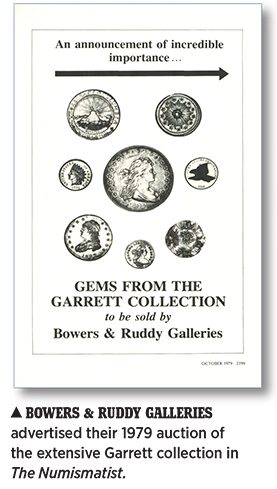
The ANA Board of Governors continued to bicker constantly, changing the bylaws, criticizing dealers and more. Many people admired President Criswell, but others thought him pompous, and that he instituted policies without studying them carefully. However, compared to predecessor Hancock, Criswell was a welcome change.
Coin World and Numismatic News took the ANA to task for the seemingly unbusinesslike conduct at its Board meetings. Meanwhile, headquarters continued to be capably managed by Executive Vice President Edward C. Rochette and his staff. Today, most historians consider Rochette to be the most important figure in the success of the ANA, second only to ANA-founder George F. Heath.
The ANA convention was held in St. Louis in August 1979. George D. Hatie, unopposed, was elected president and Adna G. Wilde Jr., also unopposed, became vice president. Both men had many years of experience in numismatics and with the ANA, and neither was the slightest bit controversial! To onlookers, this signaled a new age of near-harmony on the Board.
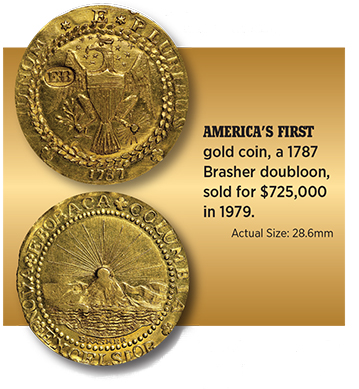
Separately, Stack’s sold an MCMVII (1907) Ultra High Relief double eagle (gold $20) for $225,000, a record price for this well-known rarity. The buyer was Arthur M. Kagin of Des Moines, Iowa, who had been in the trade since 1929. Bowers and Ruddy Galleries sold the first of four sections of the Garrett Collection on behalf of The Johns Hopkins University. Appraised at about $9 million, the auction eventually realized $25 million. In November, a 1787 Brasher doubloon in the Garrett Collection set a new record at $725,000. Schulman, the team of Kreisberg and Cohen, and other auctioneers registered strong prices. Retailers operated by specialists such as Anthony Terranova Sr., Lyn Knight and others, as well as the large and expanding New England Rare Coin Galleries, also were thriving.
From the viewpoint of serious, dedicated numismatists and probably all dealers, by year’s end, all was well in the numismatic market. Geese were now swans; dandelions were roses. With a nod to a phrase in early 19th-century history, this was an “Era of Good Feeling,” and the market was at an all-time high.
As a leading figure in the hobby, I remember this era well and with fondness. How fortunate I am to have a career in numismatics!
Into the 1980s
By 1980, things changed, and quickly. There was trouble in numismatic paradise. In January the investment fervor in silver (spurred by the Hunt brothers) and gold caused the precious metals to peak at $50.35 and $873 per ounce, respectively. (In January 1978, two years earlier, silver had been only $4.89 per ounce.) At the Central States convention in Lincoln, Nebraska, in March, hardly anyone was buying coins. The market for most federal issues in high grades was dead…or was it?

Among federal coins, the market for Morgan silver dollars remained strong, but at lower price levels. The Coin Dealer Newsletter, produced and edited by Allen Harriman, weekly chronicled many developments as they happened.
At about this time, there was a growing realization that polyvinyl chloride (PVC) transparent plastic coin holders, used throughout the hobby, were causing damage after two or three years, including depositing green goo on the surface of silver issues and causing pitting on nickel coins. Within a short time, most collectors discontinued use of these soft “flips” in favor of mylar and other safe materials.
In 1980 Mint Director Stella B. Hackel announced that, henceforth, a “P” mintmark would be placed on nickels, dimes, quarters and half dollars, a first for all except nickels. (P letters had been used on special silver-content nickels from 1942 to 1945.)
The second midyear convention, held February 15-18 in Albuquerque, New Mexico, was successful. Ditto for the ANA summer convention in Cincinnati from August 18 to 23. It was not an election year. Steve Ivy Numismatic Auctions, Inc. reported a hefty sum of $7.6 million from its ANA sale. It was common practice to designate a particular firm as official auctioneer, in consideration of a fee, payable to the ANA, which in 1980 was $50,000.
Conditions improved. The precious-metals crash and the freezing of much of the rare coin market quickly passed into history. Collectors who had refrained from buying silver and gold coins because common dates were so expensive were now back in the marketplace. All boded well for the future of the ANA, which added many new members. In 1980 it was reported that my name was on 1,180 applications as a sponsor. Could this be a record for the most enrollments by one person in a single year?
Coin Grading
Grading continued to be a problem. The ANA system, based on the one devised by William H. Sheldon in 1949, offered three divisions: Mint State (MS)-60, MS-65 and MS-70. However, in the marketplace, many intermediate grades were used, but it was generally agreed that few people could consistently tell the difference between a new grade (such as MS-63) and the standard grade of MS-65. In time, the ANA Board of Governors adopted many intermediate grades.
President George Hatie called for a Numismatic Round Table to be held in Colorado Springs on July 12, 1980. Prominent journalists, dealers and others joined to discuss the present state of coin collecting and to offer suggestions for its future. Such meetings were popular in this era, but later faded away.

During this era, many states and other entities enacted rules that caused problems for coin dealers and collectors. Sales taxes were number one, but other legislation mandated that detailed listings be kept of coin sellers and that coins had to be held for a certain length of time before being resold. Other laws levied income taxes on out-of-state dealers who spent more than just a short time in other states. Today’s sales- and income-tax laws are more restrictive than ever, seriously affecting where conventions can be held. However, rules for listing inventories and holding coins have been eliminated.
In 1981 Donna Pope became U.S. Mint director, following her nomination by President Ronald Reagan. In ensuing years, Pope, who continued the policies of her predecessors, was a familiar face at numismatic gatherings.
In the reporting period ending May 31, 1981, ANA membership hit 36,706. The summer convention was held in New Orleans. Adna J. Wilde Jr. became president, and I was elected vice president, both of us unopposed. Barbara Gregory joined the staff of The Numismatist as an editorial assistant in September 1981. Infighting still characterized most of the numbered seats for governors. Margo Russell, editor of Coin World, stated that the ANA needed a complete overhaul of its confusing and messy election procedures.
Good Times
The year 1982 proved to be another good chapter in ANA history. President Wilde tolerated little nonsense when he conducted Board meetings, and Ed Rochette continued his masterful supervision of headquarters. Profits continued to roll in through ANACS.
Elsewhere, Dr. Vladimir Clain-Stefanelli and his wife, Elvira, curators of the National Numismatic Collection at the Smithsonian, set up finer and more extensive exhibits than had ever been done before. Well-known in the numismatic community, they and their associate, Cory Gillilland, warmly welcomed visitors and encouraged onsite research.
In New York City, the American Numismatic Society, founded in 1858, continued to be a magnet for visitors to its two temple-like buildings on Audubon Terrace, at 155th Street and Broadway.
Elizabeth Jones was named successor to Chief Engraver Frank Gasparro, who retired. Jones went on to create some of the finest coins and medals of any engraver.
Investments dominated much of the market, often bolstered by scientific-appearing brochures and newsletters. Those who sought gold often bought 1-ounce Krugerrands issued by South Africa and common-date double eagles. Several dealers advertised themselves as the “largest” or “best,” or said they were paying “the highest prices” or “selling below wholesale.” More modest was Hannes Tulving, who stated he was “one of only 18 recognized silver dollar experts in the U.S.” The identities of the other 17 were not revealed.
Drug addiction was becoming a major problem across America. Now and again, it took its toll on numismatists, among them Mulford B. Simons Jr., one of the best-loved dealers, who died at age 39.
Donn Pearlman, well-known as a numismatic writer and also as a broadcaster for CBS radio, introduced a radio program called “Coin Collectors’ Corner” on Chicago’s all-news station, WBBM. Many metropolitan newspapers ran weekly columns on rare coins, generating a lot of public interest. In the pages of The Numismatist, articles by Bill Fivaz, Leonard Albrecht, Glenn Smedley, David W. Lange and others shared valuable information about how to collect wisely. Much of this was never read by investors, as most of them did not belong to the ANA.

On June 10, 1982, a second-story addition to headquarters was dedicated, reflecting the success of ANACS and the general well-being of the Association. Seventy staff members were employed there, a healthy increase from 15 years earlier, when employees numbered just five. In June 1982, the first-ever Summer Seminar was held at The Pennsylvania State University.
On July 1, the first “modern” commemorative half dollar, designed by Elizabeth Jones to honor the 250th anniversary of Washington’s birth, was struck. Hooray! This was the first such issue since 1954, and collectors hoped more commemoratives were in the offing. The annual summer convention was held in Boston. It was not an election year.
In 1982 a buyer’s fee was introduced by some auction firms, which in time would be adopted hobby wide, with only a handful of exceptions. The typical fee was 10 percent added to the hammer price, a common-enough practice in stamps, art, antiques, and other venues. However, this was very controversial in numismatic circles and was called a “buyer’s penalty” by some. The solution resided in simple math: before bidding, a buyer need only to calculate the total price, including the fee. In later years, the percentage was increased by most auction firms.
1983 to 1985
From August 1983 to August 1985, I served as president of the ANA, with Florence M. Schook as vice president. I was fortunate to have a Board of Governors which, by that time, was mostly harmonious and included Charles J. O’Donnell, Robert Medlar, Kurt Krueger, Kenneth L. Hallenbeck and Arthur M. Kagin. We all worked together in a mostly cordial manner, and I recall no confrontations or unpleasant incidents. There were no hidden agendas. (As to my own thoughts and actions, I refer readers to back issues of The Numismatist for details. Here, I concentrate for the most part on the ANA in particular and the hobby in general.) By the time of my inauguration I had purchased Bowers and Ruddy Galleries and had relocated to New Hampshire, where I formed Bowers and Merena Galleries. The work and outreach of my term were based in the Granite State, with frequent trips to Colorado Springs, conventions and elsewhere.
By August 1983, the ANA and I were confronted with a number of challenges. Membership had declined to 35,757, and expenses had risen sharply, prompting the Board of Governors and the staff to tighten their belts. The Association had lost hundreds of thousands of dollars in recent years.
Executive Vice President Ed Rochette stated that a 20-percent cut in staff would be made, that the number of complaints received was at a record high (mainly because of problems with grading), and that the Board of Governors had to be more money-conscious when selecting hotels and cities for future conventions.

The recently formed Industry Council for Tangible Assets (ICTA) became prominent by trying to strike down unfavorable taxation and other legislation inimical to numismatics. It succeeded on many fronts. To many, numismatics was indeed an industry. To me, ever the traditionalist, it remained an art and science.
The market was in a slump. In the February 1984 issue of The Numismatist, Michael R. Fuljenz analyzed the reasons, which included:
- Economic uncertainty across the United States.
- Continuing declines in the prices of silver and gold bullion.
- The rapid rise of the market.
- Unprofitable coin shows, with many dealers suffering losses.
- Too many auctions that placed too many coins on the market.
The saying “Be careful what you wish for, you just might get it” came true concerning commemoratives. In 1983 and 1984, new issues for the 1984 Olympic Games were offered, including the very controversial “headless torso” dollar design. (Today, a collector must spend more than $10,000 per year to buy one each of the different coins and formats issued by the mints.)
I could write a book about my experiences in my two-year presidency. The market continued to be lackluster (pun intended). Holding the 1984 summer convention in Detroit (planned years earlier) resulted in a large number of concerns regarding safety. Membership declined, and complaints about the irregularities of grading continued. (In many cases, the same coin submitted to ANACS received different grades the second or third time around.)
On the plus side, as I was completing my term as president, the 1985 summer convention was held in Baltimore and was a great success. By that time, the market was on an uptick.
Also on the plus side, I conducted round tables; sought and paid attention to the advice of collectors and dealers; personally answered all correspondence; attended many conventions; traveled to local and regional clubs; offered the mint advice and research; presented many talks and programs; interfaced with writers and publishers; and promoted and expanded education. I also worked with the budget and other planning; gave awards; received honors; and enjoyed interacting with thousands of members. For further details, you can read my monthly “From Your President” columns in The Numismatist.
Next month, I’ll continue this narrative, beginning with the administration of the ANA’s next president, Florence M. Schook.
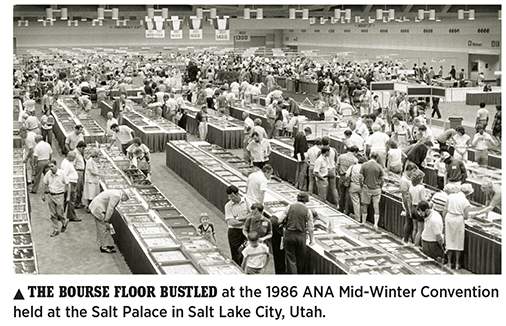
Throughout the 1970s and into the ’80s, the ANA and the numismatic community continued to grow. Though there were ups and downs, the overall direction was positive, as the ANA redefined policies and procedures and membership increased. Founded by Dr. George F. Heath in November 1891, the ANA has grown to become the largest such organization in the world. This month marks its 125th anniversary.
Numismatics in 1986
In the mid-1980s, what I like to call the “art and science of numismatics” was strong and vibrant, but it also had its share of challenges and problems. Many viewed numismatics as an industry, not with machines and smokestacks, but an activity based on the market price of gold and silver. The historical attraction of rare coins (and tokens, medals and paper money) also was a good investment. Though the hobby encompassed so much more than that, it was true that many investors enjoyed the financial rewards numismatics offered. The secret back then, which still holds true, was that a collection carefully formed over a long period of time by a knowledgeable numismatist nearly always yields a profit, sometimes remarkably so. The promotion of coins by telemarketing (particularly by aggressive firms unknown to mainstream numismatics) was becoming an increasing concern.
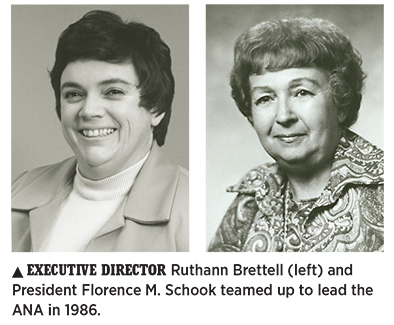
The editorial department headed by N. Neil Harris and assisted by Barbara J. Gregory, G. Lee Hudson and Marilyn A. Reback, turned out substantive issues of The Numismatist each month. Both then and now, the magazine was the main benefit of ANA membership.
Executive Director Ruthann Brettell managed the team. She succeeded Ed Rochette in the post. Ed was largely responsible for managing headquarters in Colorado Springs and had brought it up to world-class status.
Florence M. Schook was president in early 1986, having been elected in 1985. She had long been the driving force behind her pet interest—the ANA Young Numismatist (YN) program. More than 500 youthful enthusiasts were enrolled, some of whom went on to become very prominent in our field.

For a reasonable fee, the American Numismatic Association Certification Service (ANACS) authenticated and graded coins per the official standards that were adopted by the Board of Governors in 1977. However, many dealers ignored the ANA guidelines and came up with grades such as MS-65+++ and the like.
Sometimes, the more things change, the more they stay the same. Marketers who sought to get an edge, often by misleading buyers, were a big problem. In January 1986, Schook addressed this issue in her monthly column in The Numismatist:
Everyone seems to hold the ANA responsible for changes in grading, but in actuality it is the pricing of coins that has changed, and now some want to alter the grading descriptions to accommodate the new prices. Those of you who establish coin prices are warned to think twice before deliberately confusing collectors with your own grading vocabulary. We may just stop buying your coins.
Clubs & Curators
Coin clubs were an active part of the collecting scene in the late 1980s. Most met monthly, and many sponsored local or regional shows. Coin shops could be found in most large and medium-size towns and cities, but not as many as there had been during the market boom of 1960-64.
In New York City, the American Numismatic Society (ANS), housed in two beautiful stone buildings on Audubon Terrace at 155th Street and Broadway, featured the largest numismatic library in the world. The ANS continued to focus on ancient and foreign coinage. However, it did hold yearly “Coinage of the Americas” conferences in which collectors could participate in a day-long program conducted by well-known experts. The lectures were later published in book form.
ANS curator Dr. Richard G. Doty was appointed curator of Western Hemisphere numismatics at the Smithsonian Institution. Over time, he set up many marvelous and extensive displays, which included the Josiah K. Lilly Collection of gold coins. Researchers and others received a warm welcome when they visited, as they had during the curatorships of Vladimir and Elvira Clain-Stefanelli.
In St. Louis, Missouri, the Mercantile Money Museum featured the collection of Eric P. Newman. It was curated by Gene Hessler, who, in earlier times (1967-75), directed the Chase Manhattan Money Museum in New York City.

Coin Grading Concerns
During this period, more was written about grading than any other subject. In 1986 David Hall and dealer partners set up Professional Coin Grading Service (PCGS), which encased coins in plastic “slabs” labeled with a numerical grade. In time, Hall was recognized as one of the most innovative people in numismatics. John Albanese, another highly talented dealer, formed Numismatic Guaranty Corporation (NGC) in 1987, which also used plastic holders. ANACS, which returned coins to their owners with photographs and certificates, for a short time used the “ANACS Cache” holder, which did not gain traction in the marketplace. Later, the ANA sold ANACS to Amos Publishing in Sidney, Ohio, which issued the weekly periodical Coin World. At this time, Beth Deisher was the editor there, succeeding Margo Russell, who had served in that position from 1961 to 1984.
As an experiment, Kevin Foley, a well-known writer, sent 10 different coins to four different professional grading services, including ANACS. The companies were unable to agree on the condition of a single coin. In the instance of a 1919 quarter dollar, professional opinions ranged all the way from About Uncirculated (AU)-55 to Mint State (MS)-65. This type of study was replicated a number of times with similar results.
Across the board, interpretations of the ANA grading standards had loosened. It was found that a coin, resubmitted to a grading service, might be returned with a higher and thus (seemingly) more valuable grade. For example, many coins that had been graded AU-55 and -58 graduated to MS-60, -61 or -62 after the ANA Board of Governors expanded the official system to include these steps.
When the official standards were set in place in 1977, there were three categories for MS-60 and above, and soon that number was expanded to five. This was a win-win situation for the grading services. If a coin was submitted a half dozen or more times, as many were, multiple fees would be collected instead of just one. And what owner wouldn’t be delighted to learn that his AU-58 coin had been re-certified as MS-62?
The problem lay in the complexity of the system. There were 11 numbers between MS-60 and MS-70, and they were not defined in print or by photographs. To be scientific, such grades should not be flexible. Ideally, a coin graded MS-64 in Boise, if sent to a collector in Savannah who had a copy of a grading guide, should be graded MS-64 there as well. Beyond that, some coins were weakly struck (or very ugly), and these more subtle factors were not reflected in grading numbers.
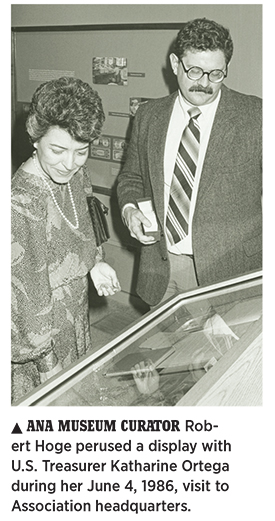
It has been said that someone who is a collector for five years becomes a collector for life. This seems to be very true, for in such a period most basic lessons are learned, and controversies are evaluated. Emphasis turns to the joy of collecting numismatic material for its art, history and romance. Such long-term enthusiasts usually realized the most financial gain. Investment was not their main objective, but a nice bonus!
Within the ANA
The 95th Anniversary Convention, held in Milwaukee, August 6-10, 1986, was a great success, although the soft market was evident. It was reported that ANA membership had increased by more than 1,500 in the past year, but it remained below the historic high. Commercial activities, including “PNG Day,” with 137 tables manned by members of the Professional Numismatists Guild, were held before the show. The regular ANA bourse was a success as well. Particularly popular were tables at which no item was priced over $100.
At the Milwaukee convention, the ANA Board took action against certain promoters:
Resolved: That the ANA Board of Directors recognizes the right of every dealer to sell his stock in a manner consistent with the member/dealer code of ethics, but that we deplore firms or persons who sell overgraded material, train salespersons to hype rare coins but do not train them in numismatology, without intent to accomplish anything other than reach to those unsophisticated in rare coins and motivate them to buy.
As a result, the ANA, working with the PNG and the Federal Trade Commission (FTC), got rid of some bad characters, a few of whom were sent to jail. However, their ilk kept coming back. Later ANA governors were not nearly as proactive, as many of the players were well-connected dealers who belonged to the Association. In contrast, Numismatic News and Coin World championed strict ANA supervision of dealer ethics, but to little avail in later years.
In one of her messages, President Schook opined that the real key to success was education:
If people would put down their Grey Sheets and pick up a good book, such as Q. David Bowers’ Adventures with Rare Coins or The Fantastic 1804 Dollar by Eric Newman and Ken Bressett, I guarantee that more folks would become collectors rather than just investors. The lure of coins and collecting is heightened by a sense of history, something that isn’t sold with a coin… Building a reference library can be a costly project, though the investment is small compared to what many spend on assembling their portfolios.
An innovation of 1986 that became popular and endures to this day was the launch of the American Eagle program of silver and gold coins. Not so well liked were the many new commemoratives of the era that often honored obscure events or people, made possible by promoters who influenced Congress to authorize such issues. On the plus side, U.S. Mint Director Donna Pope maintained warm and close contact with the numismatic community, as did Chief Engraver Elizabeth Jones. (Her departure in 1991 was a loss to the U.S. Mint and all of numismatics.)

The Numismatist Turns 100
In 1988 The Numismatist celebrated its 100th anniversary. The magazine had been started in 1888 by Dr. George F. Heath and later became the ANA’s official journal. Walter Breen was far and away the most publicized researcher of his day. His Encyclopedia of U.S. and Colonial Coins was published by Doubleday and became a sensation. One dealer sold over 10,000 copies in the first year. Breen was flying high until later it was learned that many of his “facts” were unsubstantiated.
The ANA Museum, under the curatorship of Robert W. Hoge, continued to expand and was greatly enhanced by the donation of Aubrey and Adeline Bebee’s remarkable collection of United States paper money. Robert J. Leuver, former director of the U.S. Bureau of Engraving and Printing in Washington, D.C., and a familiar face at numismatic gatherings, was appointed executive director of the ANA, succeeding Ruthann Brettell, who had worked at ANA headquarters in various capacities for 22 years.
In the pages of The Numismatist, Michael R. Fuljenz kept abreast of activities in his “Market Forum” column. Although traditional numismatics was doing well, investment was becoming the proverbial tail that wagged the dog.

The reality of coin grading is that perceptions change, but coins don’t change. To establish a truly permanent grading standard you need permanent physical examples of the grades. You need a set of grading examples… You need a permanent grading set. PCGS is now rapidly expanding its permanent grading set…The goal is to have $500,000 worth of coins by the end of 1987 and $1 million worth (at today’s prices) by 1990…
So how does the PCGS permanent grading set benefit you? Quite simply, when you buy a PCGS coin you are buying a coin that has been graded according to a grading standard that will not change…EVER! The current standards used by PCGS are the same standards PCGS will use in 1992, 1997 and even 2002 because the coins in the PCGS permanent grading set are the coins that will be the grading standards for PCGS in 1992, 1997 and 2002. The days of changing grading standards are over forever.
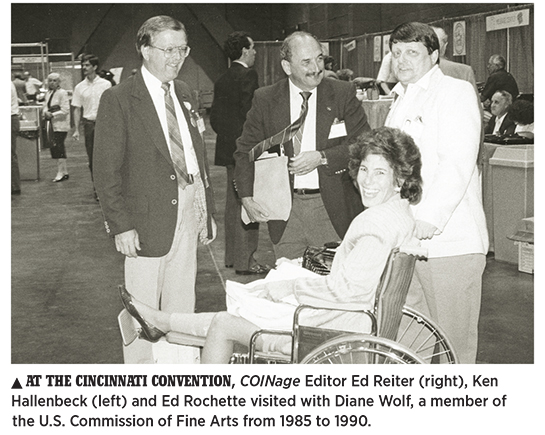
In 1987 Numismatic Guaranty Corporation stated:
Because we are the most trusted name in coin grading, NGC-graded coins are often bought sight unseen. Market makers and coin services know that NGC-graded coins are not subject to fluctuating grading standards.
As grading continued to remain the most controversial aspect of the coin market, these assurances were comforting. In the mean-time, “Wall Street money” was becoming important. Several funds were said to be in the planning stages so that investors who were not interested in numismatics per se could add rare coins to their portfolios by trusting well-known firms such as Merrill Lynch, Shearson Lehman Hutton and Kidder-Peabody.
At the summer ANA convention in Cincinnati, Executive Director Leuver reported a slight drop in membership over the past year and a 36-percent decrease in ANACS revenue, necessitating an ANA staff cut from 62 to 50 employees. Further, he stated, “Balky computer programs and contracted support plagued many efforts to vigorously and efficiently move the Association forward, particularly in the membership program.” Held July 20-23, the show was chaired by Richard Dusterberg, who in earlier times had been the ANA’s well-regarded legal counsel. ANA member and paper money collector Wendell Wolka, with a blend of scholarship and humor, emceed the banquet.
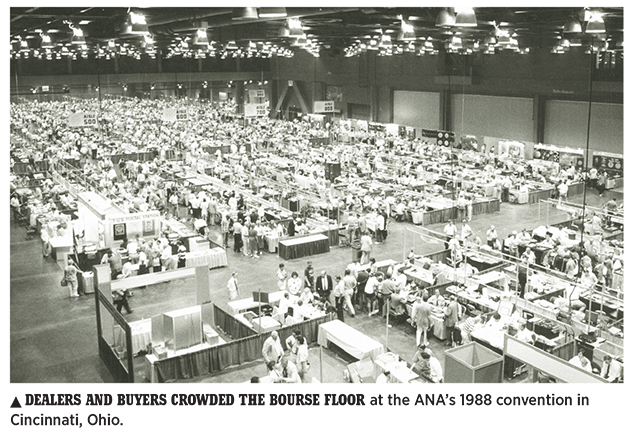
Barbara Gregory, on the staff since 1981, was named editor of The Numismatist, a position she holds today. Ken Bressett’s “Consumer Alert” column advised readers of continuing problems in the marketplace. The words of Bill Fivaz, an occasional contributor, were always insightful. “Back to Basics,” a column by David W. Lange, offered good advice as well. Donn Pearlman, an inveterate humorist and skilled writer, contributed remarks that enlivened the pages of the magazine during this period.
The Late 1980s
Grading problems continued, made all the worse by the rising market and sales pushed by investment brokers. In early 1988, President Steve Taylor stated, “I recently appointed a Consumer Protection Committee, which hopefully will expose some of these unscrupulous dealers.” However, hardly anything was done.

Wall Street money came pouring into the marketplace. Michael Fuljenz wrote, “The impact of this news on the coin market has been nothing short of phenomenal.” All bets were off, and “investment quality” coins, defined as mint-state and proof silver and gold, were hot.
On the negative side, thousands of coins that had been stored in soft polyvinyl chloride (PVC) holders were now found to have sticky green goo or, worse, to be permanently damaged. Mylar holders were recommended as a substitute.
It was an election year in 1988, and, at the summer convention in Pittsburgh, Kenneth Hallenbeck was installed as president and Ed Rochette as vice president. Both ran unopposed. The Board of Governors included Ken Bressett, David Ganz, Jim Halperin, Donn Pearlman, John Pittman, Florence Schook and Nancy Wilson.
It was reported that while 4,405 individuals had joined the ANA, an even larger number (4,935) had left. At year’s end, the number of individual members stood at 29,891, plus 637 clubs. A variety of groups met during the show, among them the John Reich Collectors Society, Society of Paper Money Collectors, The Elongated Collectors, Liberty Seated Collectors Club, Dedicated Wooden Money Collectors, Love Token Society and Barber Coin Collectors Society.
There was a precipitous drop in YN members and concern that the nationwide craze for baseball cards was taking away from coin collecting. An article in the October 1989 issue of The Numismatist by Hugh Cooper stated that, with so many investors in the marketplace, grade replaced basic rarity as the most important factor in coin pricing. Buyers became more interested in common coins in ultra-high grades as opposed to low-mintage rarities that showed signs of circulation. Cooper went on to posit:
Do you know that it is possible to set prices of coins without any knowledge of rarity? “Whatever the market will bear” sounds like a rough-and-ready pricing philosophy, but it is a fairly accurate description of marketing conditions and pricing philosophy.

In November 1989, the Columbus-America Discovery Group, of Columbus, Ohio, located the wreckage of the SS Central America about 200 miles off the coast of South Carolina. The steamship was lost at sea on September 12, 1857, and its cargo was worth millions.
What might have been an extended celebration for Tommy Thompson, Robert Evans and other members of the salvage crew turned into a nightmare. Lawsuits poured in from all directions, ranging from attorneys representing clients who claimed to have had a long-ago insured interest to those who said they aided the treasure hunters in one way or another. The whole matter landed in court and was not resolved until years later, when in 1999 Dwight N. Manley and his associates purchased about 92 percent of the treasure through negotiations with the litigants and others.
Into the 1990s
Nothing could go wrong with the market. In his January 1990 column, Fuljenz wrote:
Bid levels for type coinage have paralleled the rest of the market this month. A Barber half in MS-65 was bid at $4,750 on October 20 and since then has risen to $5,150. A Proof-66 Trade dollar increased from $18,500 to $25,000.
At such prices, very few coins were bought by serious longtime collectors. It was the era of the investor as king. Donn Pearlman wryly noted in his predictions for the coming year:
The 735th coin grading company will open for business with a desperate marketing ploy. Submit any coin for only $1.75 and the company’s owners personally come to your home and gratefully take you to dinner.
Not long after, Fuljenz wrote that the American Rare Coin Fund Limited Partnership had a potential investment of $42 million, the Numismatic Fine Arts World Coin Fund, LP (Merrill Lynch) was slated to spend $50 million to $75 million, and a half dozen other groups were set to spend figures in the millions as well.
However, many traditionalists—Professional Numismatists Guild President (and longtime dealer) Harvey Stack and myself among them—suggested from time to time that the collector was the ultimate “consumer” of coins. We thought that any planning within the “coin industry” (as just about everyone called it) should be done with the collector in mind, if long-term results were to be beneficial.
In the meantime, the Federal Trade Commission investigated a number of private investment-oriented firms that were selling coins to unwary buyers. Subsequently, several firms were shut down by the FTC.
Mike Gumpel, who was with COINage magazine’s advertising department, reported attending a convention and seeing a “professional numismatist” buy and sell tens of thousands of dollars’ worth of coins using a computer—with scarcely a coin in sight—even though the man apparently could not tell the difference between a coin and a stamp. He was trading in slabbed coins and seemingly had all the knowledge he needed.
On May 16, 1990, PCGS held a conference to state that it had achieved success in computerized grading. Fuljenz wrote:
Representatives of major brokerage houses, banks and funds from all over the country dominated the invitation list. What they saw at the conference was truly impressive. The computer can grade 42 coins at a time in a three-minute-time frame. Each coin is examined under several types of light coming from different directions. Some 2.2 billion calculations are made before a grade is determined. According to PCGS, a coin’s strike, lustre, impairments, reflectivity, color and overall eye appeal are considered in the computerized grading process. The machine actually “learns” with each coin it grades.
(The computer was apparently not a quick learner, for this innovation was later dropped.)
The ANA was being deluged with complaints. President Hallenbeck blamed the Board and suggested that its members should lead the way instead of trying not to offend anyone, including perpetrators. Hallenbeck stated that membership was up 1,000 names—the first increase in six years. The total was 30,528 individuals and more than 1,000 clubs, reported David L. Ganz, chairman of the Finance Committee.
At the Seattle convention the PNG and the Industry Council for Tangible Assets (ICTA) held a symposium on grading. Barry Cutler of the FTC showed an unencapsulated 1908 Saint-Gaudens double eagle (gold $20) to an assembled group of people who earned their livings grading coins for the third-party services. One by one they gave their expert grades, which ranged from AU-58 to MS-64.

Still, the basic collecting spirit was alive and well. Those who specialized in coins of ancient Rome and Greece, American colonial issues, United States half cents and large cents, Civil War tokens, large-size U.S. notes, or any one of dozens of other specialties were pursuing their hobby with enthusiasm.
Centennial Celebration
The next year, 1991, was dominated by international events. The ANA’s 100th Anniversary Convention was held at the Rosemont/ O’Hare Exposition Center outside Chicago, Illinois, on August 13-18. It was an election year. The new president was Edward C. Rochette; David L. Ganz was vice president, and the Board of Governors consisted of Kenneth Bressett, Grover C. Criswell, Donn Pearlman, John Jay Pittman, Florence Schook, Anthony Swiatek and Nancy Wilson.
The market for higher-grade mint-state and proof coins continued to be weak. Most, but not all, Wall Street involvement had disappeared. However, interest and prices of series that appealed primarily to experienced collectors remained strong. The hobby press reported on important auctions, sales of rarities, and other news relating to dealers.
Looking back, there was a lot to celebrate during this evolutionary period. The Association faced many challenges and emerged stronger, to the benefit of its members and the hobby.

Controversy swirled around past presidents who were still on the Board, including Criswell, Pittman and Schook. Over time, the bylaws changed, and today no governor can serve for more than ten years (five two-year terms, not necessarily consecutive). The “pro” was the introduction of fresh blood; the “con” was that people with years of experience were excluded, and the true preferences of many members could no longer be expressed.
Declining membership had been a problem for years and continued on a downward trend. Several factors were to blame, among them the lack of scarce and rare coins in pocket change and, some said, the sportscard market, with shops opening in towns and cities across America and stealing some of the numismatic hobby’s thunder.
In 1992 the Early Spring Convention (later called the National Money Show®) was held in Dallas, with about 4,000 in attendance. That summer, the World’s Fair of Money® was held at the Orange County Convention Center in Orlando, Florida. Convention Director Ruthann Brettell stated that the registration of 11,000 was lower than expected, but that the event was satisfactory to almost all who attended. Doing particularly well were dealers who offered moderately-priced items. David Ryder, deputy director of the mint, was on hand to greet visitors.

At the Smithsonian Institution in Washington, Curator Elvira Clain-Stefanelli set up eight large exhibit cases to highlight the history of the ANA. It joined a multi-room display of coins from the National Numismatic Collection, which was a magnet for scholars and casual visitors from all over the world.
The ANA in the Mid-1990s
In Colorado Springs, the ANA Money Museum continued to attract not only numismatists, but also the general public. At one time in 1993, four different examples of the famous 1804 silver dollar were on view there, three being on loan. The annual Summer Seminar, founded by Ed Rochette years earlier, had grown to accommodate a record 130 students.

In September 1993, the ANA began posting on two of the nation’s largest computer bulletin boards—CompuServe and Prodigy. This did not pan out, and within the year Executive Director Leuver reported that online interest was disappointingly low.
A survey sent to members revealed that most who replied were very unhappy with the themes Congress had chosen for commemorative coins, which the U.S. Mint offered in a great variety of options. In December, the mint coordinated the first meeting of its Citizens Commemorative Coin Advisory Committee (CCCAC, later followed by the Citizens Coinage Advisory Committee), with President Ganz as a member.
Dissatisfaction with the ANA’s election procedure continued, and bylaws continued to be revised. The simple “vote for your favorite candidate” approach had been compromised by various rules that limited who could run for office.

The 1994 ANA World’s Fair of Money was held July 27-31 at the Westin Hotel in Detroit, drawing 8,500 participants. Elizabeth Jones, who retired as U.S. Mint chief engraver in 1991, was named an honorary life member, a rare tribute. A series of video programs relating to numismatics was co-sponsored by the ANA and the Professional Numismatists Guild (PNG). David Lisot, recently elected as a governor, took the lead as videographer and went on to record many other programs in the coming years.
In early 1995, the Board of Governors raised membership dues from $26 to $29 to offset rising postage rates. In March the Early Spring Convention was held at the Cobb Galleria Centre in Atlanta, with about 4,000 in attendance. Not long after, the ANA again pursued a presence on the Internet, hoping for greater participation than evidenced in its earlier foray.
It was election time again, and Ken Bressett assumed the position of president, with Anthony Swiatek as vice president (both of whom ran unopposed). By now, third-party certification for expensive coins was the norm, with Professional Coin Grading Service (PCGS) and Numismatic Guaranty Corporation of America (NGC) leading the pack of more than a dozen such firms. In February 1996, the ANA negotiated a contract to designate NGC as its official grading service for three years, an arrangement that later was extended.
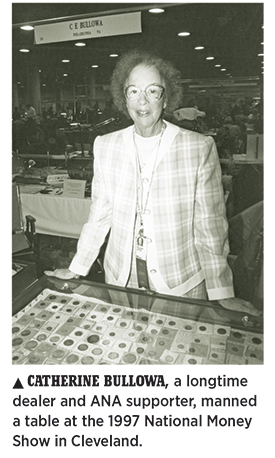
The market remained strong, however, and I was fortunate to be at the podium on May 21 when the very first coin to sell for $1 million crossed the auction block—the Louis E. Eliasberg 1913 Liberty Head nickel, which brought an amazing $1,485,000. (Today, a million-dollar sale would raise few eyebrows.) Overall, the market fluctuated, though values over the long term continued to trend upward.
In July 1996, the ANA Summer Seminar (called the Summer Conference during Leuver’s tenure) attracted 244 participants. The World’s Fair of Money took place in Denver, August 14-17, and was pronounced a success. This and similar events continued to draw criticism from bourse dealers who were penalized for leaving shows early. However, with “PNG Day” and other pre-show events, plus the five days that followed on the bourse floor, the work could be very tiring. The increased acceptance of certified coins meant a collector or dealer who wanted to buy could “do” a show in a day or two—quite unlike earlier times when most coins were in paper envelopes and needed to be examined individually.
In January 1997, the 5th edition of The Official American Numismatic Association Grading Standards for United States Coins was released. From March 20 to 22, the National Money Show (the new name for the Early Spring Convention) was held in Cleveland, but drew only about 2,000 people, including dealers.

The Late 1990s
By mid-1998, many dealers were trading on the Internet, and spending days at a show where buyers were few was viewed as a waste of valuable time. ANA Convention Director Ruthann Brettell countered, “It’s confusing to first-time attendees who enter our bourse floor on the last day of a show and find empty tables…It’s not good for the show and not good for developing new collectors.” However, by staying through Sunday, many dealers were exhausted. The problem was later ameliorated by making Saturday the last day. On weekends many casual visitors stopped by. This was fine from an educational viewpoint, but dealers who had been there all week found that newcomers bought very little. To this day, the controversy continues, with compelling arguments on both sides.


On June 11, Executive Director Hoffman resigned unexpectedly and claimed that the ANA had not been forthright regarding various legal issues pertaining to the Association. In view of the allegations she made, and under advice of counsel, the Board was not able to comment. Members were clueless as to what happened. Local attorney Christopher Cipoletti was appointed as ANA general counsel to replace George Hatie, who had passed away suddenly. Hoffman subsequently filed a lawsuit against the Association, as did former Chief Financial Officer Wayne S. Abraham.

In 1999 the National Money Show took place in Sacramento, California, with attendance recorded at a whopping 10,000. The World’s Fair of Money, August 11-15, was held at the Rosemont Convention Center, not far from O’Hare International Airport outside downtown Chicago. An attendance of 10,000 again was posted. This convention center had been (and continues to be) favored by many members because of its easy access by air from any point in the world.
At the event, the Board of Governors appointed Ed Rochette executive director, a post he had occupied on a pro tem basis since Peggy Hoffman’s resignation. In the biennial race for president, J.T. Stanton faced off against H. Robert Campbell, but before the votes were cast, Stanton left the race. Helen Carmody, also unopposed, became the new vice president. The Summer Seminar was expanded to two week-long sessions, starting a tradition that continues to the present day. At the end of the fiscal year, the membership rolls numbered 28,400.
In 1999 the euro became the official currency of 11 nations that joined the European Union, eventually resulting in the production of distinctive coins that could be used across borders. The U.S. Mint’s statehood quarter program debuted with four designs, the first being for Delaware. Susan B. Anthony dollars, not minted since 1981, were produced, despite the large quantities of earlier dates that remained in Treasury and bank vaults.

Into the 21st Century
The 2000 National Money Show was held in Ft. Lauderdale, Florida, March 3-5, with a reported 6,100 attendees. The World’s Fair of Money was held at Philadelphia’s Pennsylvania Convention Center on August 9-13, and attracted 20,000. The “Ship of Gold” exhibit—a large display that resembled the hull of the 19th-century steamship S.S. Central America—stretched across the front of the bourse. Accompanied by a model of the Kellogg & Humbert Assay Office, the exhibit was staged by Dwight N. Manley of the California Gold Marketing Group. Treasure salvors Tommy Thompson and Bob Evans were on hand to meet and greet the steady stream of visitors. At the Numismatic Theatre, Bob and I delivered a program about the Central America’s discovery to a wall- to-wall audience of over 400.
ANA Chief Financial Officer Ruthann Brettell announced that the Association’s budget would be balanced for the fiscal year. The market was strong, even for modern coins that previously had been depressed. The increasing popularity of certified coins, plus the rise of the Internet as a trading forum, contributed to the dynamics. (The market would remain vibrant through 2013.)
The 2001 National Money Show, held March 8-10 in Salt Lake City, Utah, drew 9,810 people. It was reported that the Association comprised about 31,000 members. In May, Lawrence J. Lee became the new curator of the Money Museum, succeeding Robert W. Hoge, who left after serving in that capacity for 20 years.
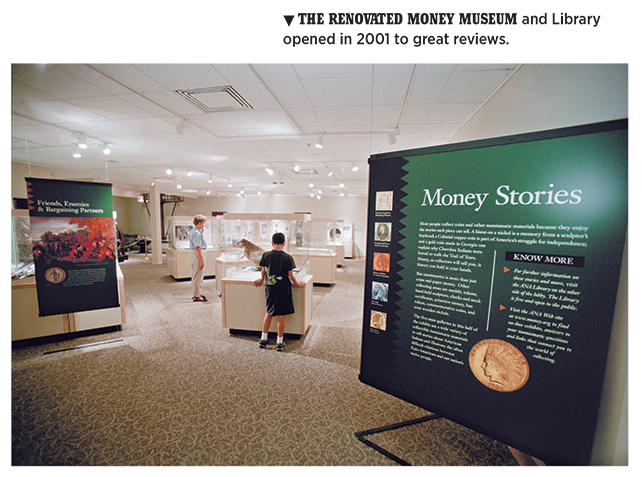
The World’s Fair of Money took place at the Cobb Galleria Centre in Atlanta, August 8-12, with a reported 12,000 attendees. In the biennial election that summer, John Wilson faced Will Rossman in the contest for president and received 4,841 votes to the latter’s 3,225. Gary Lewis went up against Alan Herbert for the vice presidency, receiving 4,343 votes to Alan’s 3,582.
On September 11, 2001, terrorists seized control of four large passenger jets, crashing two of them into the World Trade Center’s twin towers in New York City and the others into the Pentagon in Washington, D.C., and a field in Pennsylvania. More than 3,000 people were killed, and the nation mourned. Air travel was disrupted and adversely affected by heightened security measures that often involved searches and long lines. Not surprisingly, this impacted collector and dealer attendance at numismatic events.
The 2002 National Money Show in Jacksonville, Florida, March 7-9, drew 4,100 people. The Summer Seminar, held for two weeks in Colorado Springs, offered 38 courses and hosted 400 students and instructors, a record. The World’s Fair of Money was held in a familiar venue, the Marriott Marquis Hotel in New York, from August 11 to 15, with 11,600 attending. About 30,000 individuals and over 500 clubs were members of the ANA. Dwight N. Manley and his family donated $250,000 toward the improvements at ANA headquarters, and the Board named the Library in his honor.
The Next Four Years
From March 21 to 23, 2003, the National Money Show was held in Charlotte, North Carolina, with a reported attendance of more than 5,000. The World’s Fair of Money took place at the Baltimore Convention Center, July 30-August 3, with 13,000 participants. All five known 1913 Liberty Head nickels were on display—the first time they had been exhibited together in over 80 years. The recently organized Citizens Coinage Advisory Committee (replacing the CCCAC) held an open meeting at the convention and discussed upcoming state quarters and the Jefferson nickel redesign. Outgoing ANA President John Wilson listed his 10 most important accomplishments, starting with “the hiring of a new and dynamic executive director, Chris Cipoletti,” followed by the introduction of a large-format, full-color Numismatist magazine.

It was reported that nearly 4,000 numismatists had joined or renewed their ANA memberships. The perceived threat of sports-card collecting had diminished dramatically, but the younger set was slow to embrace the numismatic hobby. The statehood quarters program, now in its fourth year, was a great success.
In October 2003, membership stood at 30,153. The Dwight N. Manley Numismatic Library was formally dedicated on October 17. Despite the increasing availability of “virtual books” on the Internet, new print editions were issued in record numbers, especially by Whitman Publishing, which was becoming especially dynamic under ownership of the Anderson family. Another popular source of information was the E-Sylum, a weekly electronic newsletter edited by Wayne Homren on behalf of the Numismatic Bibliomania Society.
Nearly a dozen specialty groups, representing perhaps 5,000 to 10,000 collectors, were active on the numismatic scene. The ANA’s “Lamp of Knowledge” logotype once again was discarded, this time in favor of an image reminiscent of Liberty on the 1921 Peace dollar.

It was anticipated that new designs for the 2004 and 2005 5-cent pieces would introduce thousands of people to the hobby. Goals for the Association included increasing membership to 40,000 by 2009 and balancing the operating budget by 2007. The ANA also officially announced a collaboration with eBay, the online auction venue, to combat numismatic fraud. This effort resulted in a “code of conduct” for those selling numismatic items on eBay and the formation of the Coin Community Watch Group. (This was not particularly effective, and many fake coins, tokens and medals continued to be sold on the Internet, as they are today in 2016.)
In mid-2005, 6,125 people came to the National Money Show in Kansas City, Missouri, April 8-10. The World’s Fair of Money was held in San Francisco, July 27-31, 2005, with a reported attendance of 15,000, a figure that did not square with the opinions of many vocal dealers who said it was one of the slowest conventions on record. (However, they might have had this perception because the bourse was divided between two separate floors.) In the biennial Board of Governors race, Bill Horton was elected president over Will Rossman, and Barry Stuppler was named vice president, besting Arthur M. Fitts III.
Legal expenses continued to plague the Association. A suit filed by ASA Accugrade, Inc. against the ANA and seven other defendants, claiming unreasonable restraint of trade in the third-party grading business, was dismissed, but still was costly.
A new ANA convention was announced—the ANA Coin, Stamp and Collectibles Show, intended to be held twice a year, with the first scheduled for the Mandalay Bay Resort and Casino in Las Vegas on October 28-30. The event had a very short run and disappeared. Also introduced that year was the 1891 Alliance, a reincarnation of the 1891 Club (whose members donated $1,891 during the ANA’s centennial year in 1991). Again, not much happened.
In 2006 the National Money Show was held April 7-9 at Atlanta’s Cobb Galleria Centre, a familiar venue, with 6,100 people on hand. A scholarly publication, ANA Journal, was launched in the spring to highlight strides in numismatic study, with the first 64-page installment priced at $16.95. (An annual subscription was $65.95.) The journal was well regarded, but in-depth, original research was hard to come by, and publication was discontinued the following year.
Denver played host to the ANA World’s Fair of Money on August 6-10, with a reported attendance of 9,200. Among the items on exhibit were 10 double eagles (gold $20) bearing the rare 1933 date, confiscated from the Langbord Family by the U.S. Treasury Department, which maintained the coins legally could not be held, although many scholars in the numismatic community felt otherwise. Kenneth Bressett was presented a gold medal by Whitman Publisher Dennis Tucker to mark the 60th anniversary of A Guide Book of United States Coins, which Ken had edited since 1962. Membership was reported as 31,217.

The 2007 National Money Show was held in Charlotte, a popular venue, on March 16-18. More than 5,600 collectors, dealers and visitors reportedly crossed the threshold. The World’s Fair of Money took place in Milwaukee, Wisconsin, August 8-12. Membership was recorded as 31,544. Although 5,013 new members were reported, the attrition rate was about the same, resulting in little change.
The Board announced a recruitment goal of 40,000 members by 2010. With regard to the budget, this year (and during this era), interest from investment funds was added to income to counterbalance losses.
On October 16, the Board of Governors announced that Executive Director Christopher Cipoletti had been “terminated with cause,” following two months of administrative leave. (He had been ANA general counsel since 1998 and executive director since 2003.) The Board of Governors was largely silent about the situation, but thanks to Coin World Editor Beth Deisher’s investigative journalism, the issues came to light. Cipoletti subsequently filed suit against the ANA, litigation that cost the Association hundreds of thousands of dollars. Ken Hallenbeck took over as acting executive director, and A. Ronald Sirna Jr. was named general counsel.
In 2008 the search for a new executive director continued, and by March 6 the field of 37 applicants had been narrowed to two. Larry Shepherd, a successful coin dealer and former banking/investment expert from Cincinnati, was named to the position by the Board of Governors. The choice was widely applauded by the numismatic community.
That year’s National Money Show was held in Phoenix, Arizona, March 7-9, with attendance reported as 5,796. Effective with the June issue, The Numismatist became available in virtual form online. By telephone vote on June 2, the ANA Board unanimously voted to chuck the “Liberty” logo and restore the Lamp of Knowledge. Meanwhile, Gail Baker, former ANA education director, took the post as chairman of the Membership Committee.
The World’s Fair of Money, held at the Baltimore Convention Center from July 30 to August 3, drew 9,700. Membership stood at 31,721. Among ANA business, the Board restored “The” to the title of the ANA’s official publication. In October the Board voted to create the Florence Schook School of Numismatics to pay tribute to a lady who dedicated much of her life to educating young numismatists. The program was intended to serve both YNs and adults. According to reports at the time, “Summer Seminar will be the flagship program, but the school will include classes and seminars at conventions, remote sites and online.” The concept was promising, but it was not promoted to its fullest extent. On the other hand, the ANA invited Whitman Publishing to underwrite the Association’s Young Numismatist Literary Awards, a successful ongoing program that encourages young writers and researchers.
In 2009 the National Money Show was held March 13-15 in Portland, Oregon. The attendance was 7,943, a strong showing for this event. The World’s Fair of Money was conducted in Los Angeles, August 5-9. Attendance was just 7,700, down from the spring show. A highlight of the event was the limited availability of the U.S. Mint’s MMIX (2009) ultra-high-relief $20 gold piece.
In August, ANA membership totaled 30,396. Executive Director Larry Shepherd indicated that while the ANA was in good condition overall, high legal expenses continued to drain assets and liquidity. A new membership option included a digital subscription to The Numismatist for just $28 per year, instead of $46 for the print edition. Some old-timers considered this a bad move, as printed copies tend to be picked up multiple times, while Internet publications often are quickly forgotten.
The biennial election saw Clifford Mishler defeat Patricia A. Jagger-Finner to become president. Thomas G. Hallenbeck ran unopposed for vice president. The “Cipoletti v. ANA” legal action remained a large drain on finances, although ultimately a court-ordered arbitrator “dismissed [Cipoletti’s] case in its entirety.”
Into the Teens
The 2010 National Money Show was held in Ft. Worth, Texas, March 25-27, and featured a special evening at the U.S. Bureau of Engraving and Printing’s facility there. In all, the show welcomed 5,480 participants.
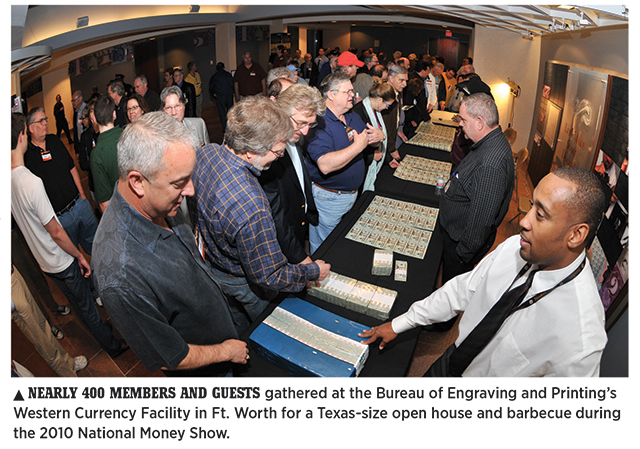
In August, ANA membership totaled 28,264. For decades, the Professional Numismatists Guild’s “PNG Day” was held the day before the opening of the ANA’s summer convention. This event was praised by some and criticized by others, the latter often grousing that PNG dealers enjoyed special privileges. In 2010 the ANA and PNG committed, for a three-year period, to host a joint “pre show,” to be held Friday through Monday, with the ANA convention beginning on Tuesday. This proved to be too much for many dealers and numismatists, and attendance was light. (In 2016 the Board voted to shorten the pre-show, effective next year.)
Although the National Money Show often operated at a financial loss, the ANA Board of Governors voted in 2010 to conduct an additional show in the fall. The first of these was held the following year in Pittsburgh on October 13-15.
In the meantime, it was discovered that some coins and other items apparently were missing from the ANA Money Museum. The Association worked closely with state and federal law enforcement to get to the bottom of the apparent theft.
The 2011 National Money Show was held in Sacramento, California, March 17-19. Reports indicated an attendance of 4,668. The World’s Fair of Money took place at the Donald E. Stephens Convention Center in Rosemont, Illinois, August 16-20. Membership had decreased to 27,559. In the biennial election, Thomas Hallenbeck was unopposed as president. Walter A. Ostromecki Jr. was elected vice president in the only contested race. The ANA’s continuing litigation problems, often played out at length in the pages of Coin World, dampened the spirits of many members. As planned, the first autumn convention was held in Pittsburgh, October 13-15, with 4,027 attending.
In behind-the-scenes activity, the Board of Governors voted to place Executive Director Larry Shepherd on administrative leave beginning on August 20 and later terminated his employment. The news came as a surprise; no specifics were reported in The Numismatist or elsewhere. His termination resulted in another lawsuit against the ANA.
On January 12, 2012, Wyatt Yeager, who had served as ANA collections manager from January through March 2007, entered a guilty plea in Federal District Court in Wilmington, Delaware, to the theft of approximately 300 items valued at $984,740 from the ANA Money Museum. He was sentenced in April to 27 months in federal prison and two years of supervised release, and ordered to pay $948,505 in restitution. Some of the specimens subsequently were recovered, but many remain at large.
The 2012 National Money Show was held at the Colorado Convention Center in Denver, with attendance noted as 2,805. The World’s Fair of Money took place at the Pennsylvania Convention Center in Philadelphia, with 8,800 participating. On May 25, the Board announced the appointment of Jeff Shevlin, a writer, researcher, publisher, cataloger, public speaker and educator, as the new executive director. “Shevlin brings a wealth of valuable management and leadership experience to the position,” reported The Numismatist.

And yet, those who attended ANA shows and continued to build their collections usually enjoyed doing so. Specialized societies were strong and healthy, with perhaps Early American Coppers and the Liberty Seated Collectors Club having the most active rosters. Buyers of gold and silver bullion coins, a subset of numismatics, diligently pursued American Eagles and other investment coins.
On April 26, 2013, ANA President Thomas G. Hallenbeck announced that Shevlin’s contract as executive director would not be renewed. “After considering the ANA’s mission and objectives, the Board of Governors concluded that Mr. Shevlin was not the right fit for the Association as it moves forward,” Hallenbeck said. (Jeff Shevlin subsequently returned to the private sector as a professional numismatist specializing in “so-called dollars.”)
On May 1, Hallenbeck announced that Kimberly Kiick, director of operations, had been named as the executive director, a choice that was well received. A personable lady with many years of ANA experience, Kiick has drawn praise from that time on.
The 2013 National Money Show was held later than usual: May 9-11. More than 3,200 people turned out for the New Orleans gathering. On June 2, Dr. Richard Doty, director of the National Numismatic Collection at the Smithsonian Institution, passed away. During his administration, and dating back to the 1960s when Dr. Vladimir Clain-Stefanelli served in that position, the Smithsonian was a destination for collectors and scholars, all of whom were warmly welcomed. Doty was a regular at ANA summer conventions and frequently brought treasures to share in the ANA Museum Showcase.
The World’s Fair of Money again was held in Rosemont, Illinois, a metropolitan area easily accessible to a great number of collectors and dealers. Membership was reported as 25,366, a further decline. It was election time, and the offices of president and vice president were not contested. Walter A. Ostromecki Jr. and Jeff C. Garrett were installed, respectively.
The ANA in Recent Times
The 2014 National Money Show was held February 27 to March 1 at the Cobb Galleria Centre in Atlanta, with 4,771 present. In May, the Early American Coppers group held its annual convention in Colorado Springs, Colorado, and its members were warmly welcomed at ANA headquarters.
The World’s Fair of Money returned to Rosemont on August 5-9, with 12,642 registered attendees. The membership count was 25,451, a slight uptick from the previous year. Membership descriptions were changed from “Regular,” “Basic” and “Associate” to “Platinum,” “Gold” and “Silver,” respectively.
Convention proceedings were disrupted when some dealers hired hundreds of people, including vagrants off the street, to wait in line to buy the new dual-dated 1964-2014 gold Kennedy half dollars, offered at the U.S. Mint booth on a one-per-customer basis. “When the U.S. Mint announced that its new gold half dollar would be available for limited purchase at the World’s Fair of Money, the ANA was hopeful the release would boost public interest in numismatics,” said Kim Kiick. “Unfortunately, the challenges posed by the masses of people trying to buy the coin led to the suspension of sales at our show and U.S. Mint outlets.”

From March 5 to 7, the National Money Show was held in Portland, Oregon, with 4,592 people attending. The World’s Fair of Money, August 5-9, was back in Rosemont. Attendance was 8,635, a sharp drop thought to have been caused, in part, by the crazy activity of the previous year. The ANA membership rolls remained about the same at 25,564. Year in and year out, the magazine remained by far the largest membership benefit. By this time, about a third of members took the discounted option of obtaining The Numismatist online, rather than in print.
The top two positions in the biennial election were uncontested. Jeff Garrett, a longtime professional numismatist and valuations editor for A Guide Book of United States Coins, became president, and Gary Adkins assumed the office of vice president. Only a small percentage of the membership voted. The following governors were elected: Colonel Steve Ellsworth (3,705 votes), Dr. Donald H. Kagin (3,451), Walter Ostromecki Jr. (3,319), Dr. Ralph W. Ross (3,222), Greg Lyon (2,982), Thomas A. Mulvaney (2,746) and Paul Montgomery (2,407).
In September 2015, Numismatist editor Barbara Gregory surpassed Frank Duffield’s 27-year tenure as editor (1915-1941), making her the longest-serving person in that position in Association history. David Sklow rejoined the ANA staff as manager of the Dwight N. Manley Numismatic Library.
On December 1, 127 years of The Numismatist were made available online to members at no additional charge. The unrelated Newman Numismatic Portal, a project sponsored by the Eric P. Newman Numismatic Education Society with the goal of digitizing a vast majority of American numismatic magazines, books and catalogs, was well underway by that time.
The 2016 National Money Show was held March 3-5 in Dallas, attracting 2,585 collectors, dealers and public. Not long after, on May 25, highly respected numismatist and scholar Eric P. Newman celebrated his 105th birthday. (As recent as July 2014, he co-authored an impressive, award-winning article about Continental Currency with numismatist Maureen Levine.) The World’s Fair of Money, August 9-13, took place in Anaheim, California, with attendance calculated at 8,192.
A number of factors contributed to the less-than-stellar turnout. Chief among them were California’s income-tax laws that stipulate that out-of-state dealers who conduct business there more than 15 days each year must collect and remit sales tax at their home-state location on all sales to California residents. Many had already used their allotted days by attending the Long Beach Expo, held three times a year.
At the 2015 and 2016 summer conventions, the official auctions were conducted by Heritage Auctions and Stack’s Bowers Galleries. At the Anaheim event, the firms took in $38 million and $21 million, respectively.
Looking Forward
Perhaps more than any other period in the American Numismatic Association’s long history, the last quarter century has been a time of challenges, problems and changes. External dynamics played a large part. Millennials are not collectors in the way their parents were. The Internet has resulted in home shopping instead of visiting coin shops, local shows and conventions. A lot of the standard information once provided by The Numismatist and other hobby publications is available instantly on the Internet. And so it goes…
On the other hand, there is ample reason for optimism. In today’s world, personal service and camaraderie are more important than ever. The Summer Seminar offers a hands-on, up-close and often life-changing experience. Even first-time participants are quickly hooked and become numismatists for life.
Annual ANA conventions, the pinnacle of which is the World’s Fair of Money, are not the drawing cards they were a generation ago. However, they continue to offer wonderful opportunities to meet and greet hobby leaders, dealers from around the world, and other collectors in a warm, friendly atmosphere, while advancing the ANA’s mission to encourage the public to discover and explore numismatics.

In August 1926, more than 90 years ago, The Numismatist printed this advice from Winston S. Churchill:
Many remedies are suggested for the avoidance of worry and mental overstrain in persons who over prolonged periods have to bear exceptional responsibilities and discharge duties upon a very large scale. Some advise exercise, and others, repose. Some counsel travel, and others, retreat. Some praise solitude, and others, gaiety. No doubt all these may play their part according to the individual temperament. But the element which is constant and common in all of them is change.
Change is the master-key. It is not enough merely to switch off the lights which play upon the main and ordinary field of interest; a new field of interest must be illuminated. The cultivation of a hobby and new forms of interest is therefore a policy of first importance to a public man. To be really happy and really safe, one ought to have at least two or three, and they must all be real.
In today’s world, the hobby of coin collecting offers a pleasure that, indeed, can add much to your life. In this regard, the American Numismatic Association is front and center and offers more opportunities in 2016 than ever before.
Acknowledgments
For their willingness to review the installments in this 12-part series and/or provide suggestions and additional information, I thank Kenneth Bressett, Darcie Graybill, Barbara Gregory, Christine Karstedt, Jennifer Meers, Caleb Noel, Joel Orosz, David Sklow and Dennis Tucker.








































































